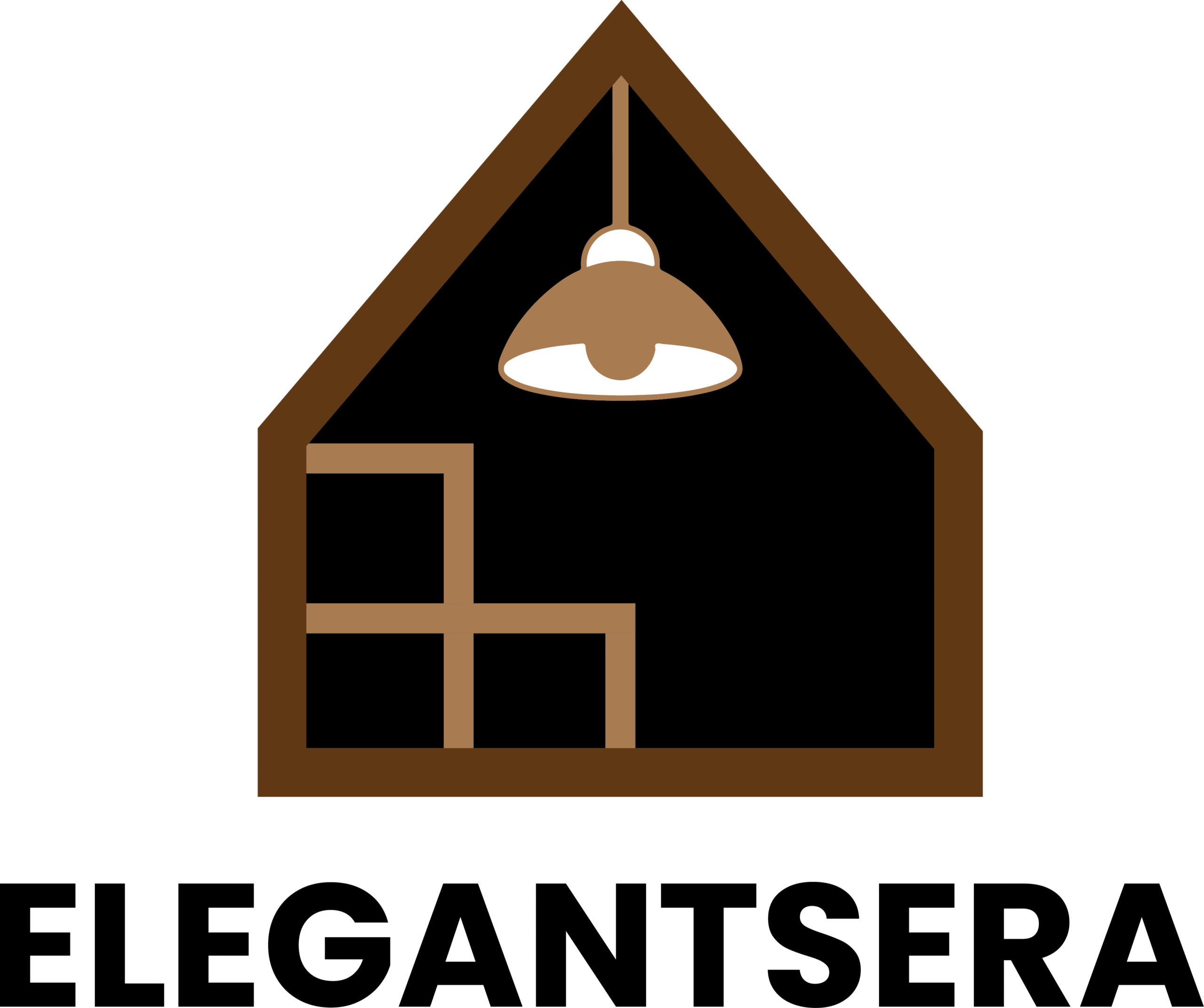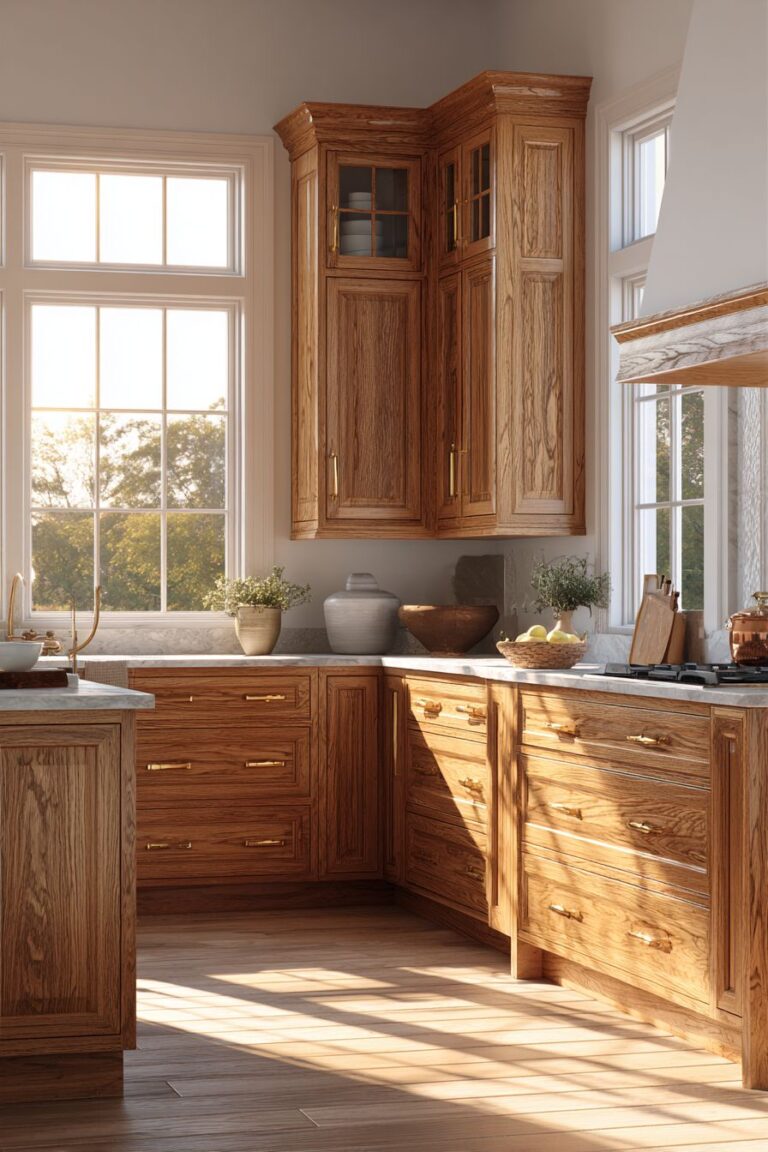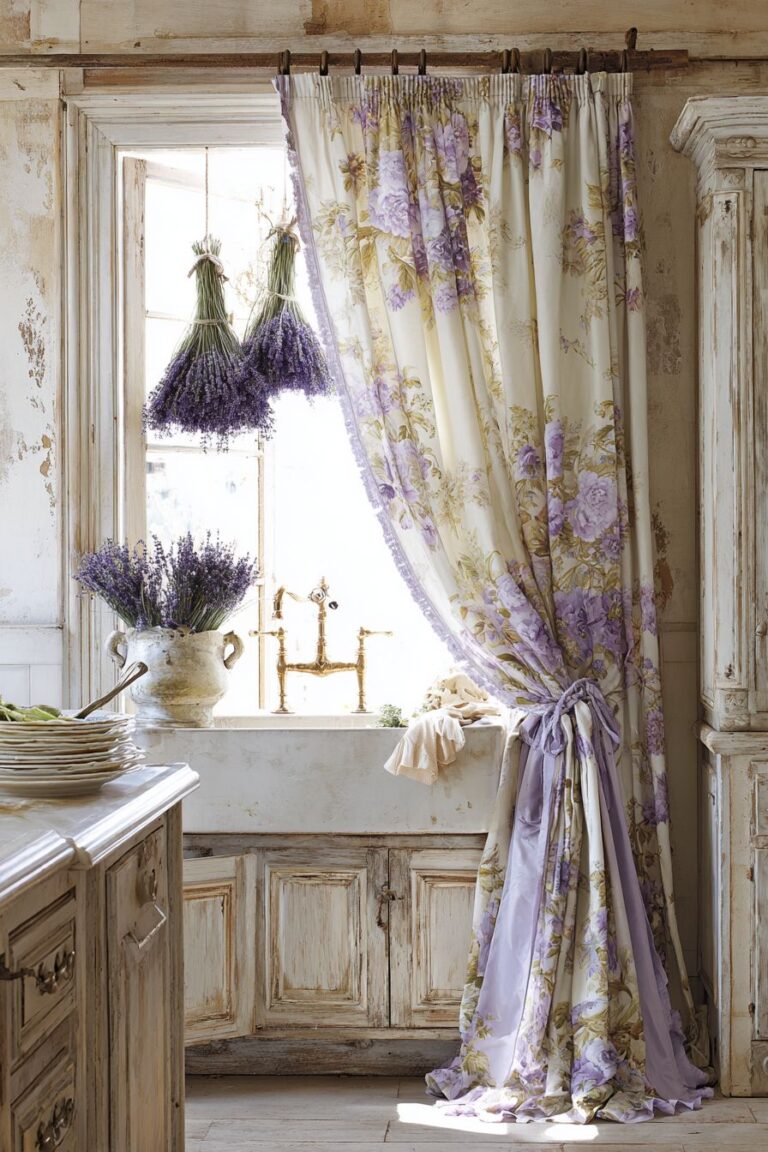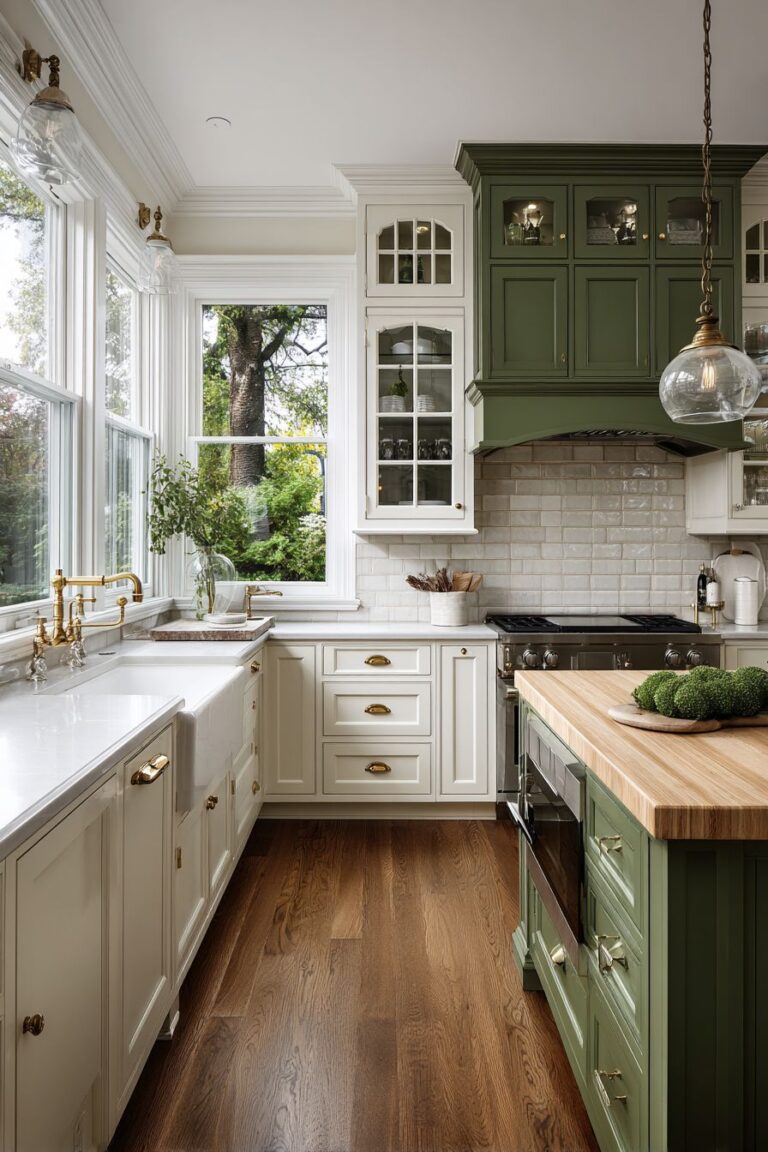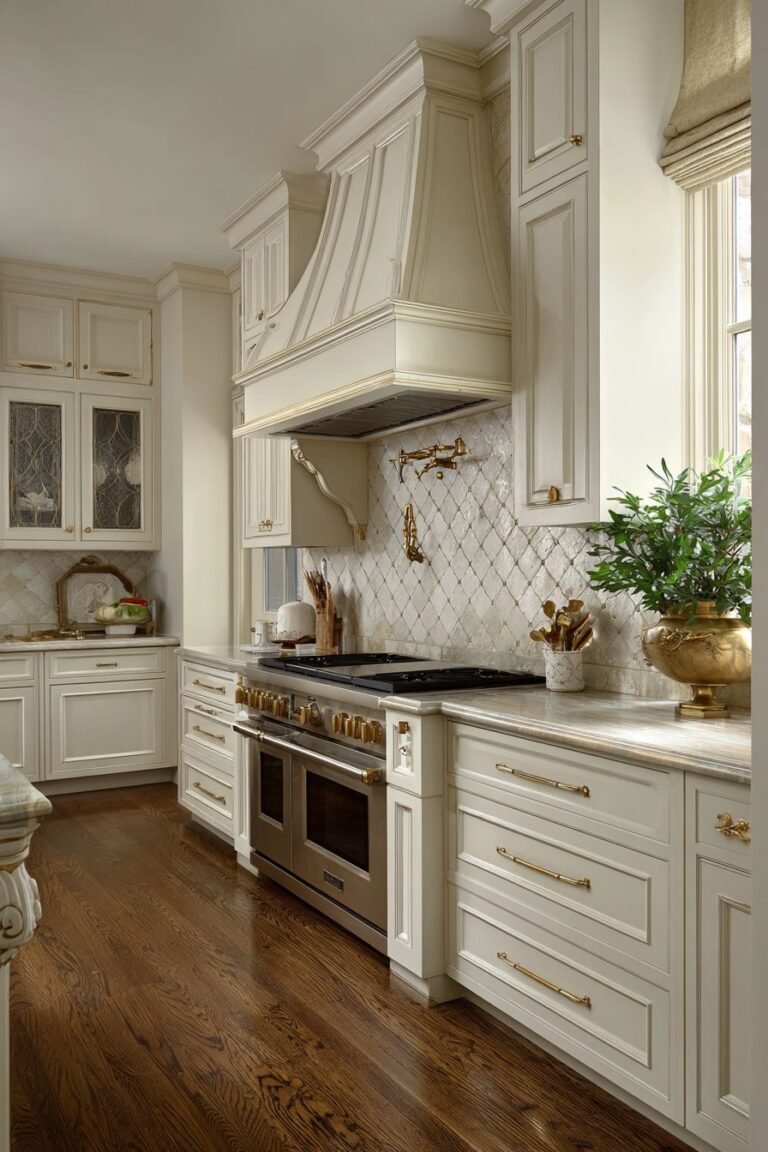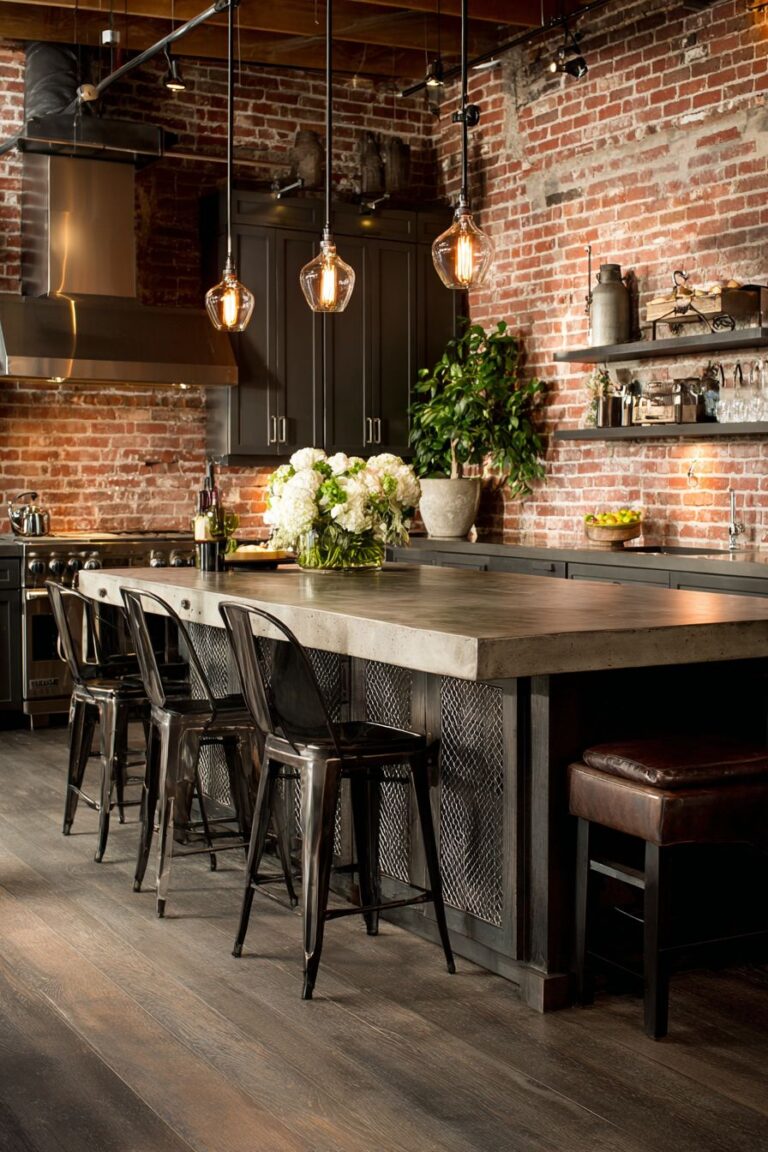20 Kitchen Wall Decor Ideas: Transform Your Culinary Space
The kitchen has evolved far beyond its traditional role as merely a place for meal preparation. Today’s modern kitchen serves as the heart of the home—a multifunctional space where families gather, friends congregate, and culinary creativity flourishes. In this dynamic environment, wall decor plays a crucial role in establishing both aesthetic appeal and functional efficiency. Thoughtful wall decoration can transform bare surfaces into inspiring focal points that reflect your personal style while enhancing the room’s overall functionality.
Creating an exceptional kitchen requires more than just selecting quality appliances and cabinetry. The walls provide an often-overlooked canvas for expressing creativity and maximizing storage potential. From rustic farmhouse charm to sleek contemporary elegance, wall decor choices can dramatically influence the atmosphere and usability of your culinary workspace. Whether you’re working with a compact galley kitchen or an expansive open-concept design, strategic wall decoration can make your space feel larger, more organized, and infinitely more inviting.
This comprehensive guide explores twenty innovative kitchen wall decor concepts that seamlessly blend form and function. Each approach offers unique opportunities to showcase your personality while addressing practical storage and organizational needs. From living walls that bring nature indoors to vintage collections that tell your family’s story, these ideas will inspire you to reimagine your kitchen walls as valuable real estate for both beauty and utility.
1. Farmhouse Gallery Wall with Herb Prints and Cutting Boards
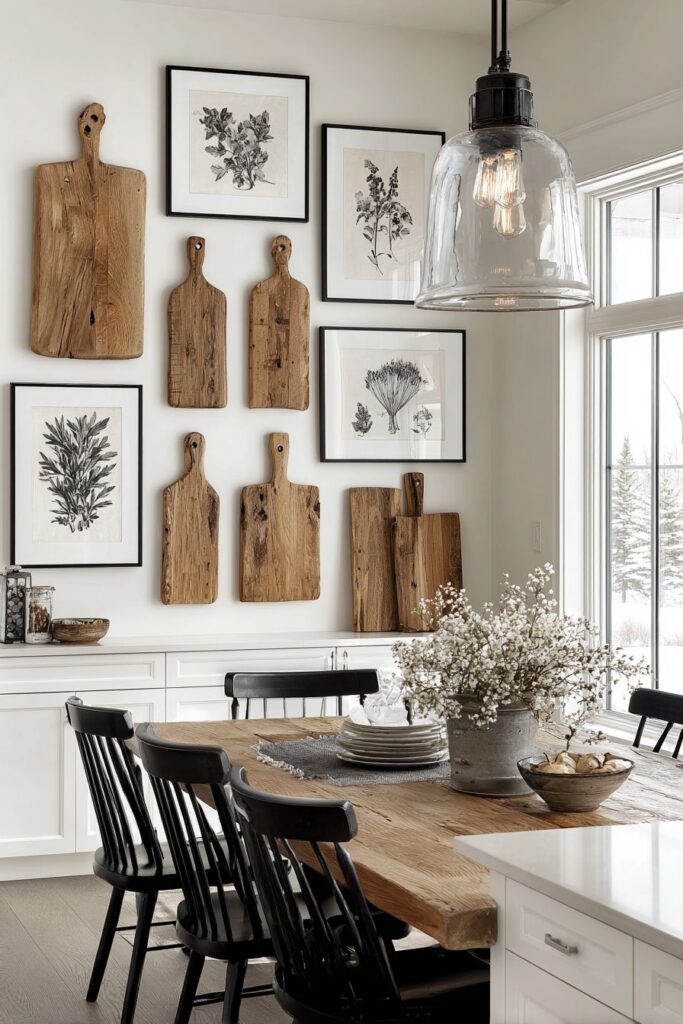
Transform your breakfast nook area with a carefully curated gallery wall that celebrates the rustic charm of farmhouse living. This design concept centers around a thoughtful arrangement of framed botanical herb prints paired with vintage wooden cutting boards, creating a display that’s both visually striking and authentically rustic. The black and white botanical illustrations, housed in matching black frames, provide a cohesive foundation while the interspersed reclaimed wood serving pieces introduce natural texture and warmth through their distinctive grain patterns.
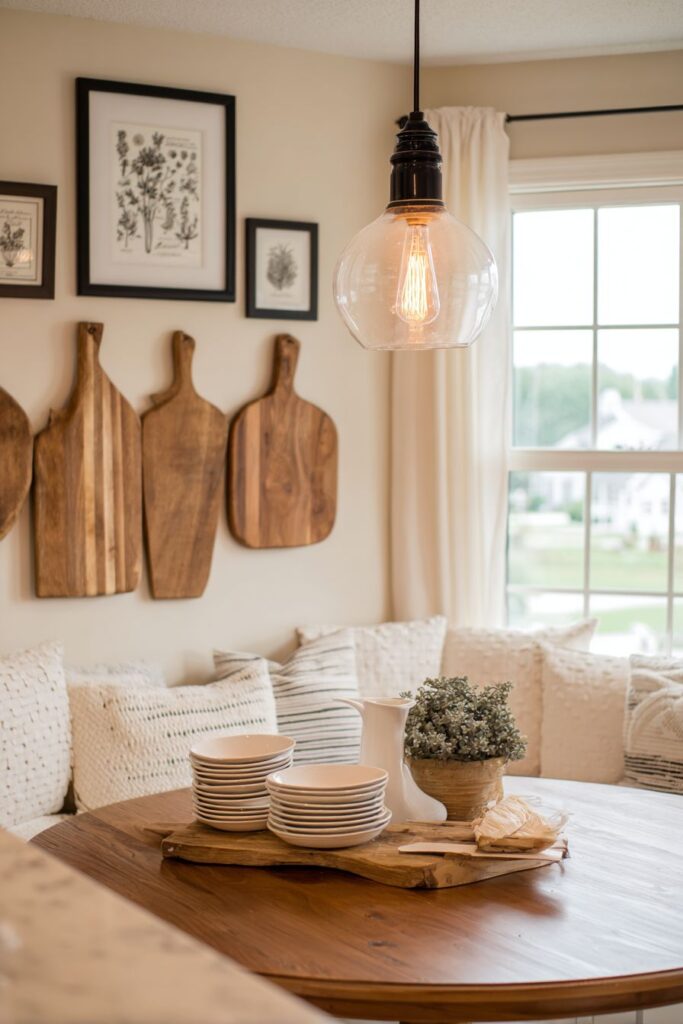
The magic of this arrangement lies in the interplay between refined artwork and functional antiques. Each cutting board tells its own story through unique wood grains, gentle wear marks, and the rich patina that only comes with years of loving use. The botanical prints, featuring detailed illustrations of herbs like rosemary, thyme, and sage, create educational value while maintaining aesthetic appeal. Warm Edison bulb pendant lighting casts a golden glow across the collection, creating depth through gentle shadows that emphasize both the paper textures of the prints and the dimensional quality of the wooden pieces.
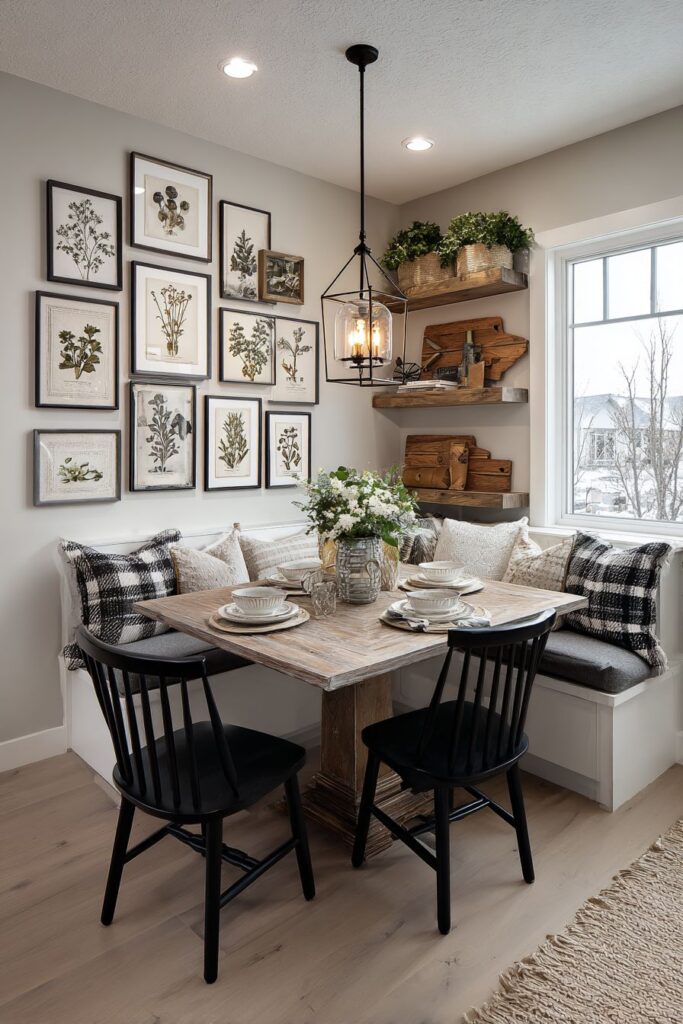
Morning light streaming through nearby windows adds another layer of visual interest, creating ever-changing shadows that bring the display to life throughout the day. The combination of artificial and natural lighting ensures the gallery wall remains a focal point from dawn to dusk, with the warm wood tones becoming particularly rich and inviting during golden hour.
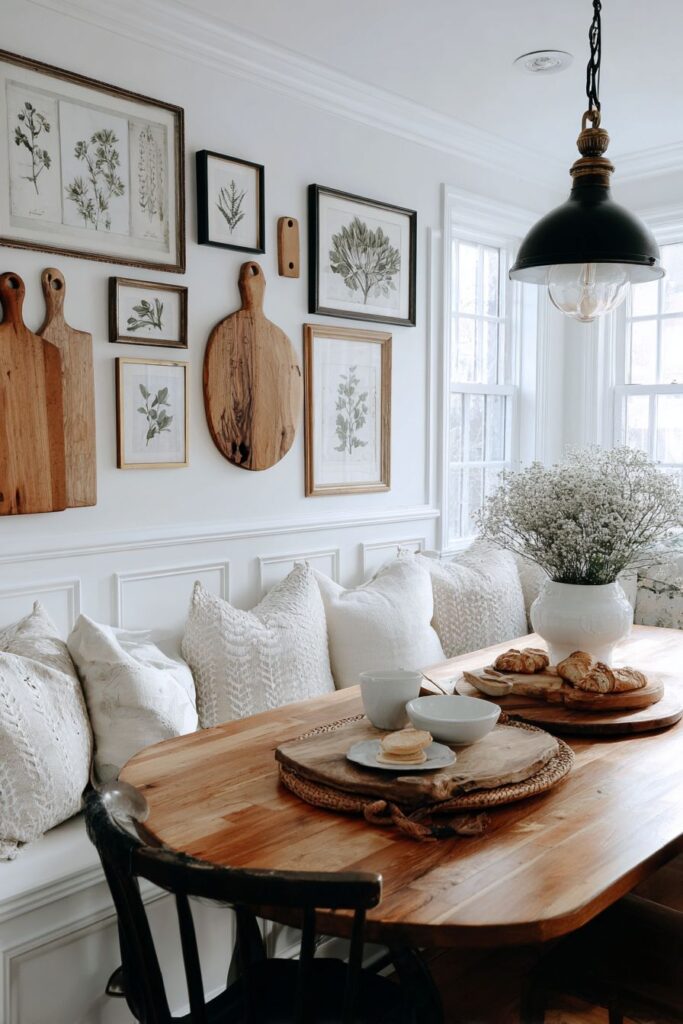
Key Design Tips:
- Select botanical prints with consistent line weights and similar artistic styles for visual cohesion
- Choose cutting boards in varying sizes but similar wood tones to maintain harmony
- Install picture lights or pendant fixtures to create dramatic evening ambiance
- Leave adequate spacing between elements to prevent visual overcrowding
- Consider the viewing angle from your breakfast table when determining hanging height
2. Live-Edge Walnut Floating Shelves with Ceramic Display
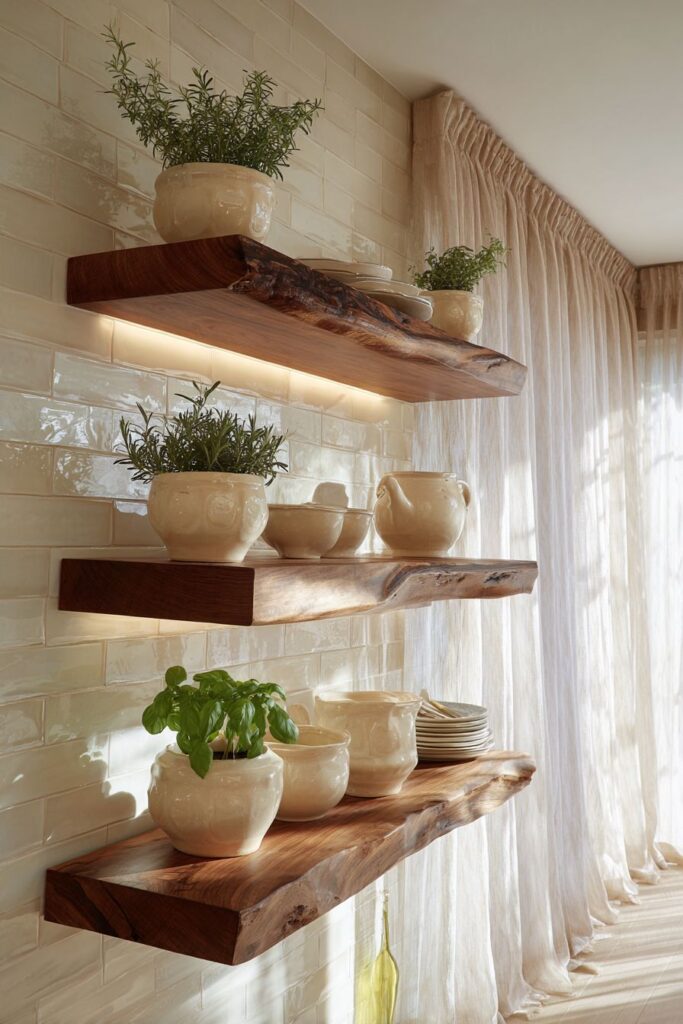
Embrace the natural beauty of live-edge walnut wood through a sophisticated three-tier floating shelf system that transforms functional storage into artistic display. These carefully selected walnut planks retain their natural bark edges, creating organic lines that soften the geometric precision of most kitchen elements. Each shelf showcases a thoughtfully curated collection of cream-colored stoneware and small terracotta planters brimming with fresh herbs, turning everyday dishware into decorative elements.
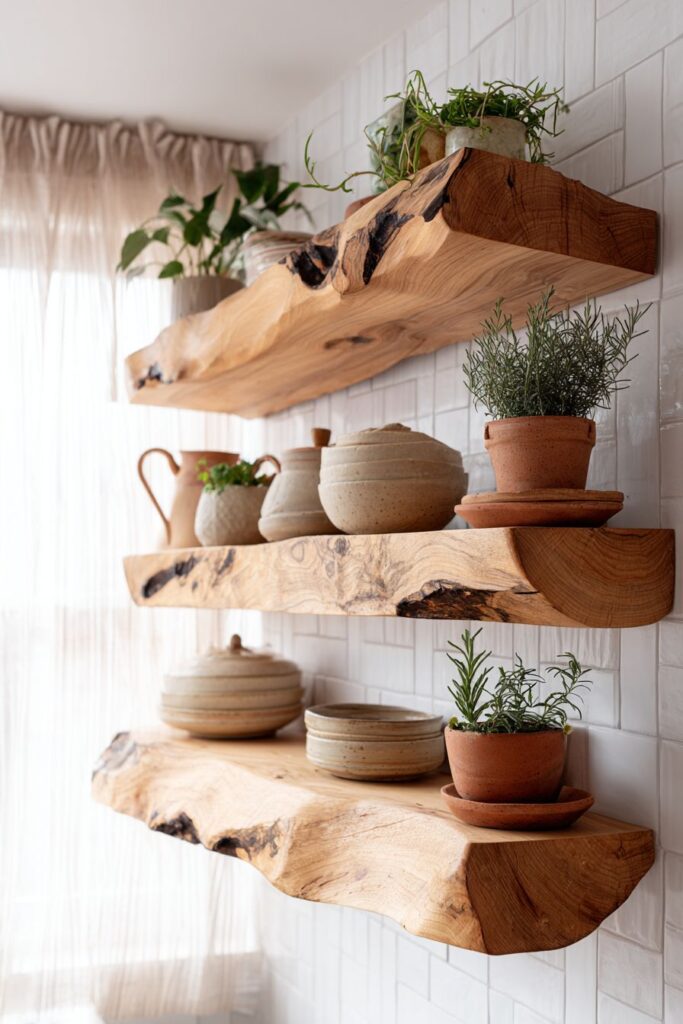
The backdrop of classic white subway tiles provides the perfect neutral canvas, allowing the rich chocolate and honey tones of the walnut to take center stage. The natural wood grain creates visual movement and interest, with each plank displaying unique characteristics that make the installation truly one-of-a-kind. Fresh basil plants with their bright green leaves and delicate rosemary sprigs add living color while providing practical herbs for cooking.
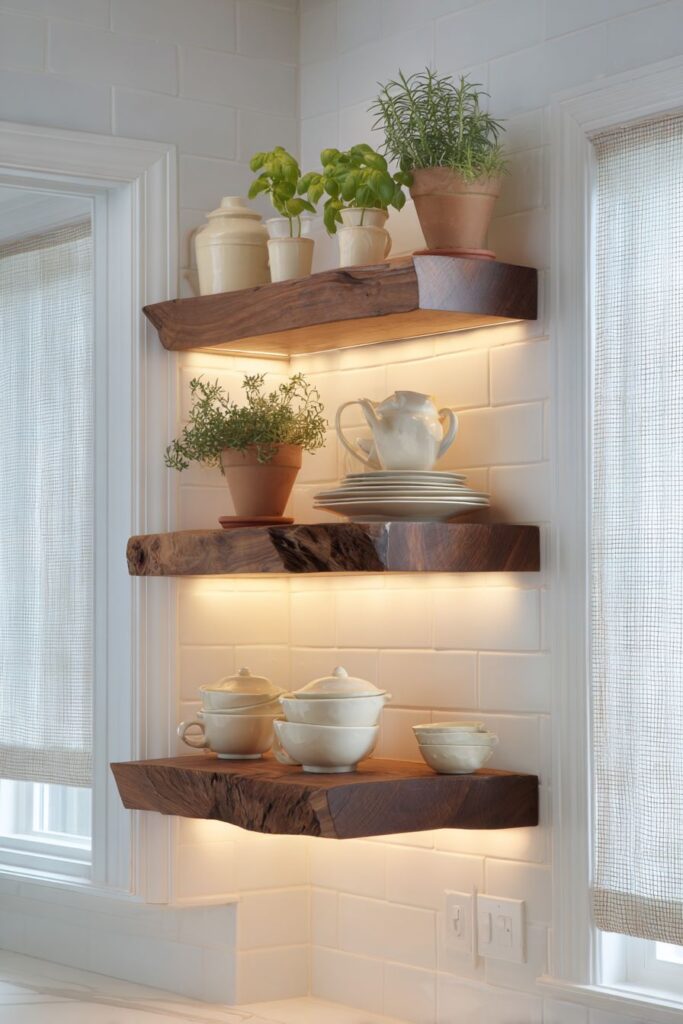
Soft under-cabinet LED lighting has been strategically positioned to highlight the natural wood grain and create subtle uplighting that makes both the pottery and plants appear to glow. This lighting choice eliminates harsh shadows while ensuring the display remains visible and appealing during evening hours. Daylight filtering through sheer window treatments provides soft, diffused illumination during daytime hours, preventing the harsh contrasts that can make displays appear stark or uninviting.
The beauty of this approach lies in its practical functionality combined with high-end aesthetic appeal. The open shelving concept eliminates the visual weight of upper cabinets while keeping frequently used items easily accessible. The living herbs provide both culinary convenience and natural fragrance, creating a sensory experience that enhances the overall kitchen atmosphere.
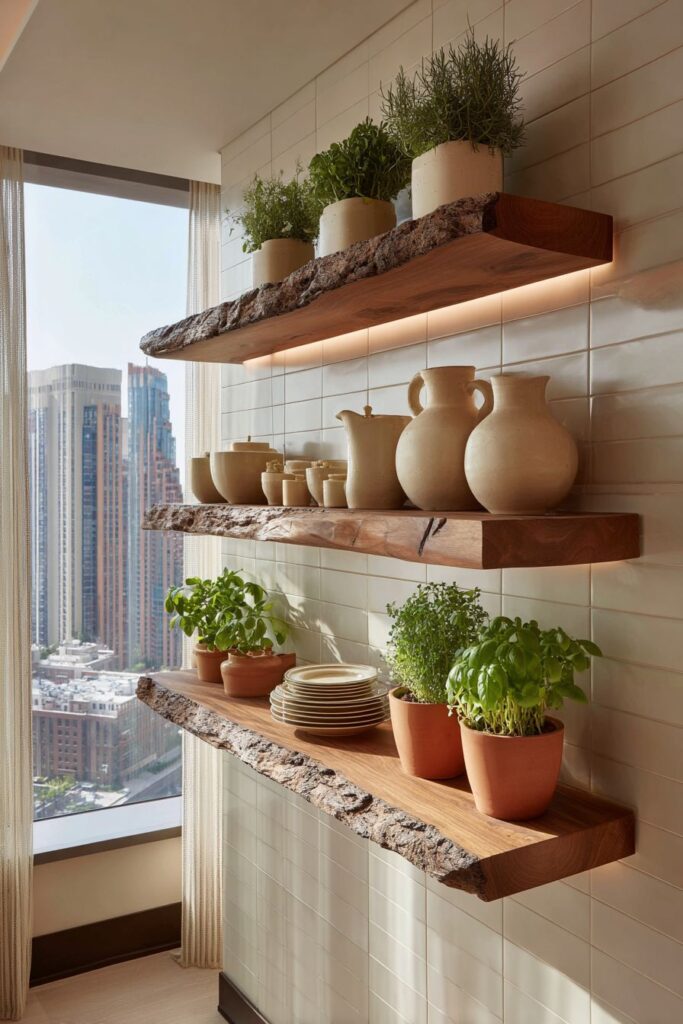
Key Design Tips:
- Choose live-edge planks with similar thickness but varying wood grain patterns for visual interest
- Install sturdy hidden brackets capable of supporting both dishes and planters
- Select cream and terracotta pottery in varying heights to create dynamic arrangements
- Position LED strips to avoid direct glare while maximizing wood grain visibility
- Group herbs by height and growth patterns for the most attractive living display
3. Statement Chalkboard Menu Wall with Shiplap Accent
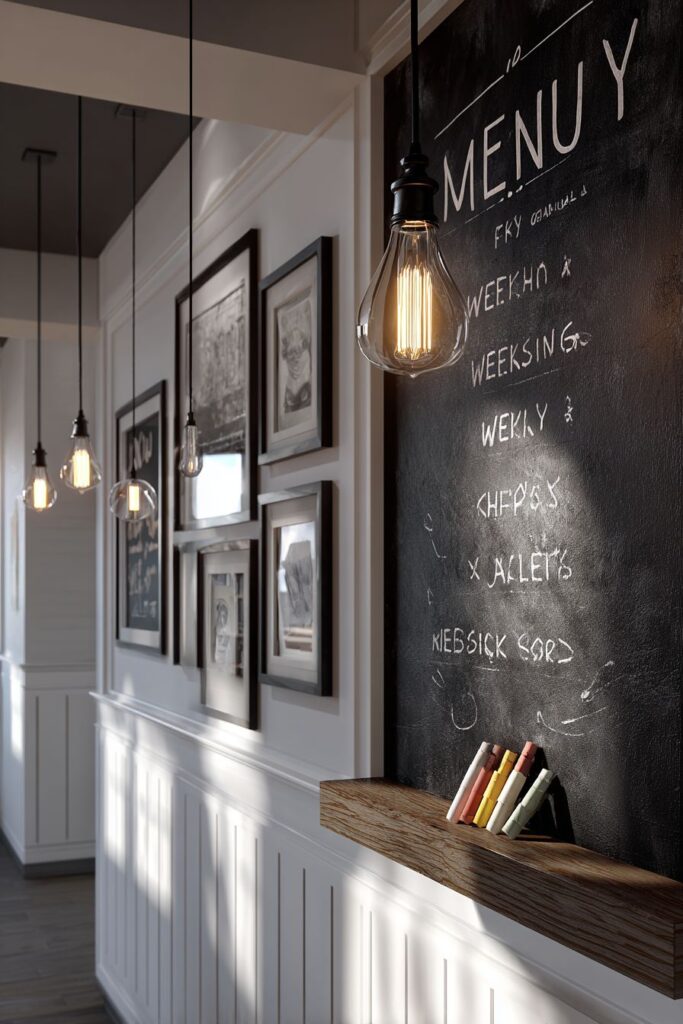
Create a dramatic focal point with a floor-to-ceiling chalkboard wall that serves as both functional menu planning space and striking design element. The deep charcoal surface provides rich contrast against white shiplap wainscoting below, creating a sophisticated two-tone wall treatment that adds architectural interest to any kitchen or dining area. This isn’t simply painted chalkboard paint – the textured surface has been carefully prepared to accept chalk beautifully while providing the authentic look and feel of traditional slate.
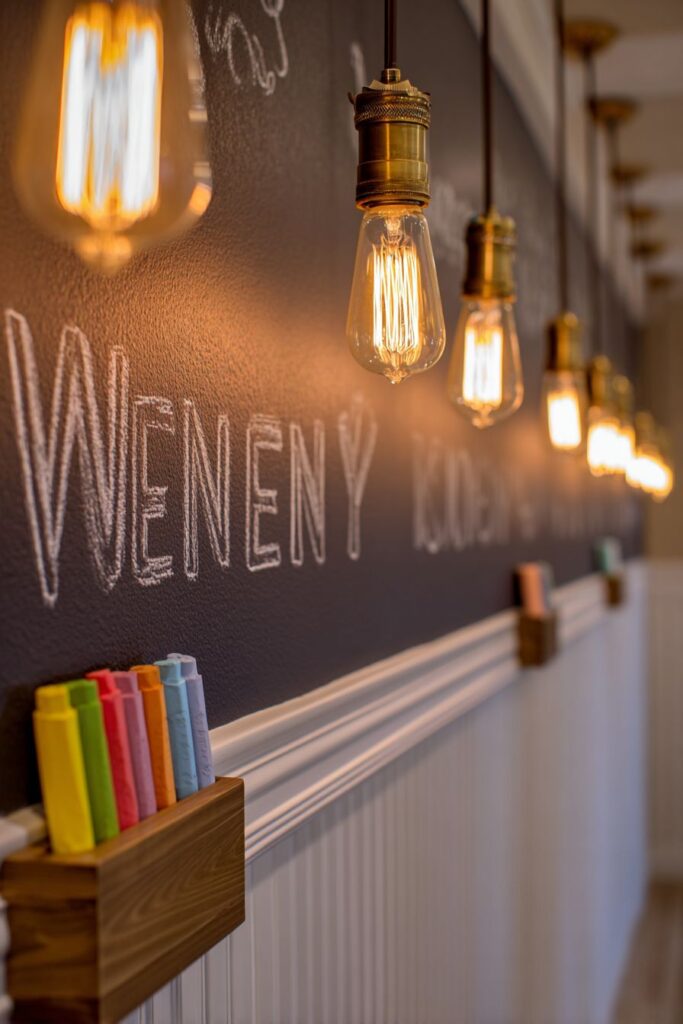
The weekly menu, hand-lettered in flowing white chalk script, becomes a living piece of art that changes regularly. This functional aspect transforms meal planning from a mundane task into an opportunity for creative expression. The texture of the chalkboard surface adds subtle depth and visual interest, while the matte finish eliminates glare and provides excellent contrast for both white and colored chalk applications.
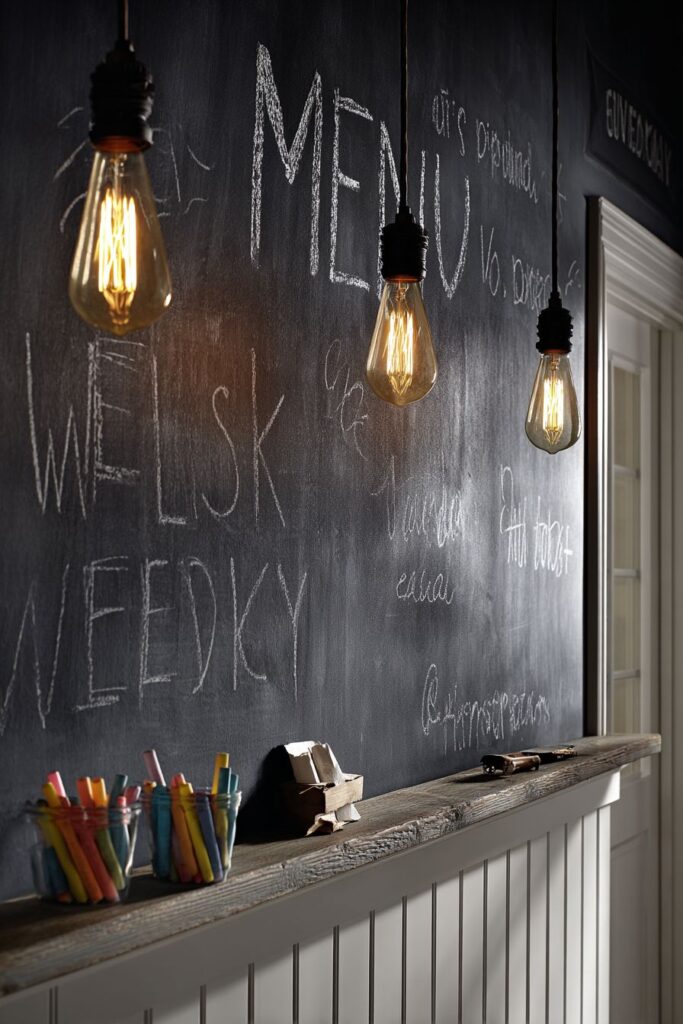
Vintage-style pendant lights with exposed Edison bulbs hang at strategic intervals, creating pools of warm light that illuminate the chalk lettering while casting dramatic shadows across the textured surface. The interplay between light and shadow emphasizes the three-dimensional quality of the chalk application and creates visual drama that draws the eye naturally to the menu display.
A narrow wooden ledge runs along the base of the chalkboard, providing convenient storage for colorful chalk pieces and erasers while adding a natural wood accent that warms the overall composition. This practical detail ensures that menu updates can be made easily and spontaneously, encouraging regular interaction with the display.
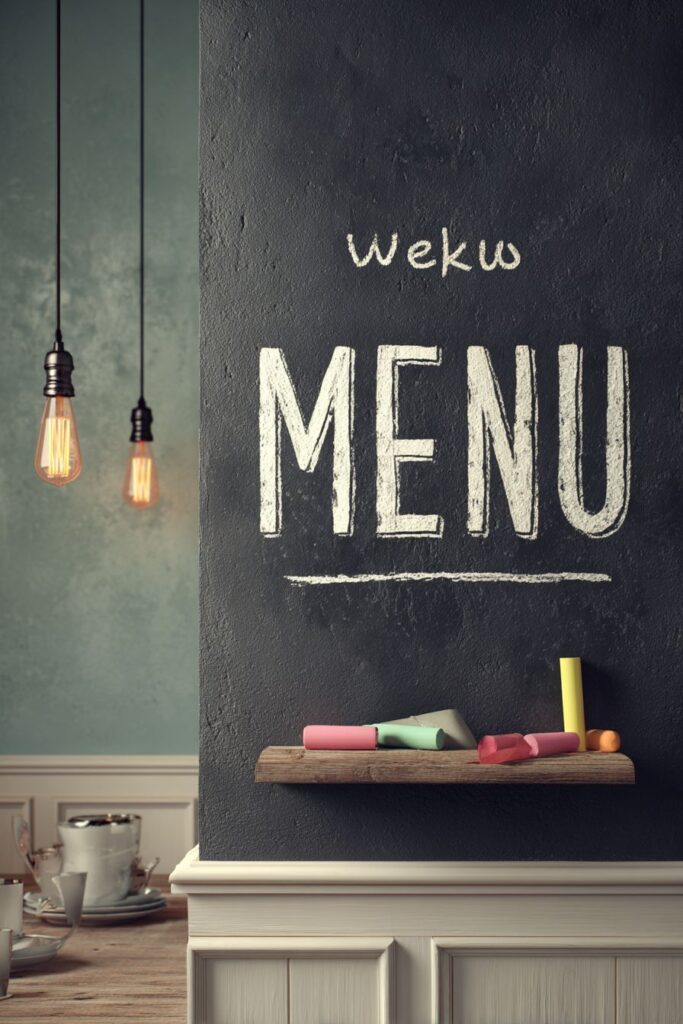
Key Design Tips:
- Apply proper chalkboard primer and conditioning before first use for optimal chalk adhesion
- Practice lettering techniques on paper before writing directly on the wall
- Use high-quality chalk or chalk markers for the most professional appearance
- Install adequate task lighting to ensure legibility during evening hours
- Consider seasonal decorative borders or illustrations to enhance the menu display
4. Vintage Copper Cookware Pegboard Display
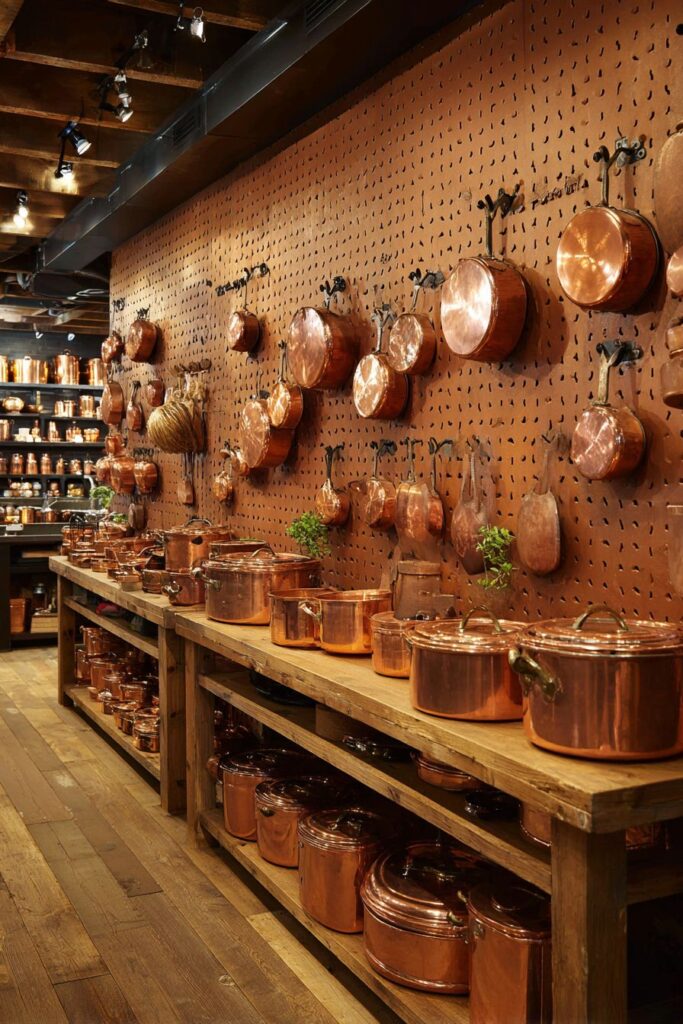
Transform functional cookware storage into a stunning visual display with a cork-backed pegboard system showcasing vintage copper pots and pans. This approach celebrates the inherent beauty of well-crafted cookware while keeping essential pieces easily accessible during cooking activities. The natural cork backing provides textural contrast and warm color that complements the gleaming copper surfaces, creating a display that’s both practical and aesthetically pleasing.
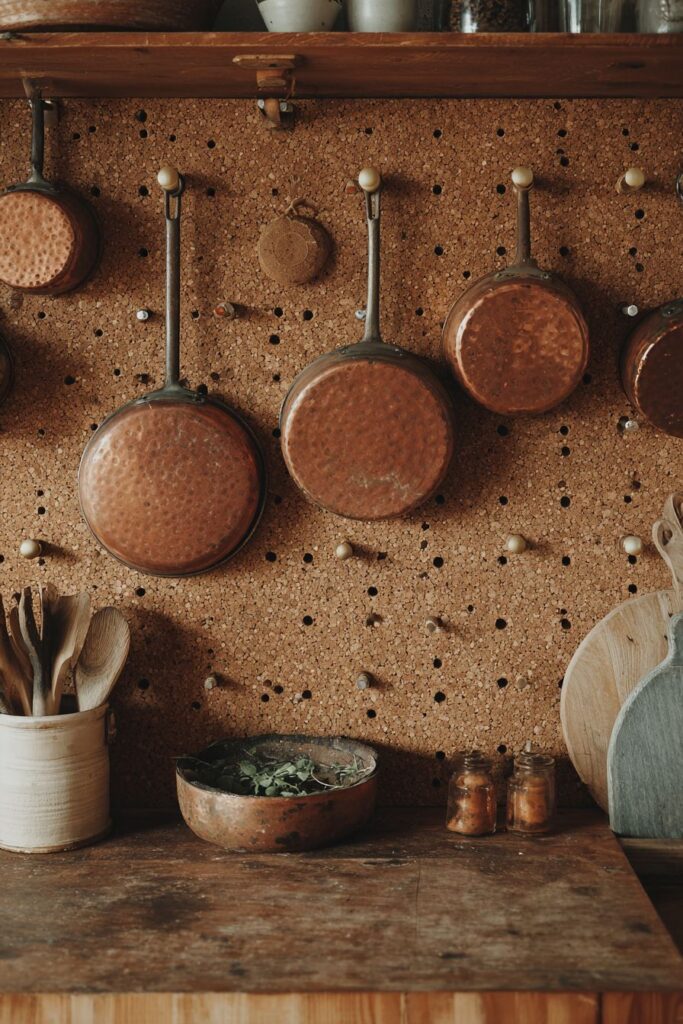
Each copper piece has been carefully selected for both function and visual appeal, displaying the authentic patina and gentle wear patterns that only come with regular use and proper care. The collection includes various sizes of saucepans, stockpots, and sauté pans, creating visual rhythm through repetition of form while offering variety in scale and proportion. The brass hooks add another layer of metallic warmth while providing secure mounting points that can be easily repositioned as needs change.
Positioned above a rustic wooden prep station, the display creates a cohesive work zone where form meets function seamlessly. The warm wood tones of the prep surface echo the natural cork backing, creating visual continuity that ties the entire area together. Professional-quality pendant fixtures cast warm light across the copper surfaces, creating beautiful reflections and highlights that emphasize the handcrafted quality of each piece.
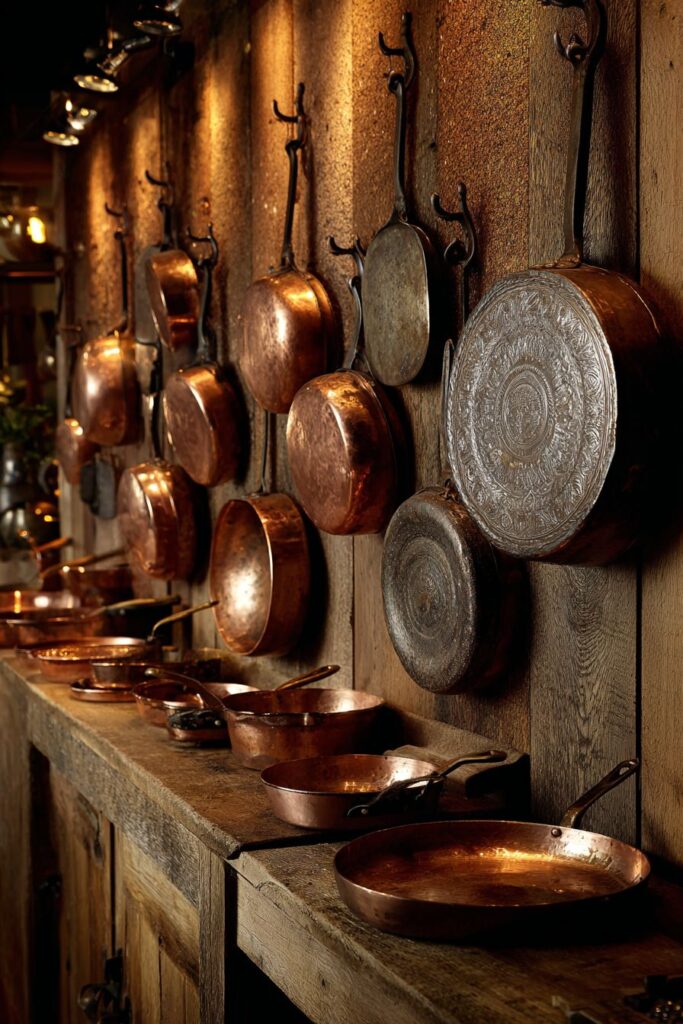
The beauty of copper cookware lies not only in its superior heat conduction properties but also in its ability to develop character over time. Each piece tells the story of countless meals prepared, developing unique color variations and patina patterns that cannot be replicated through artificial aging techniques. This authentic character makes the display feel collected and curated rather than simply purchased as a set.
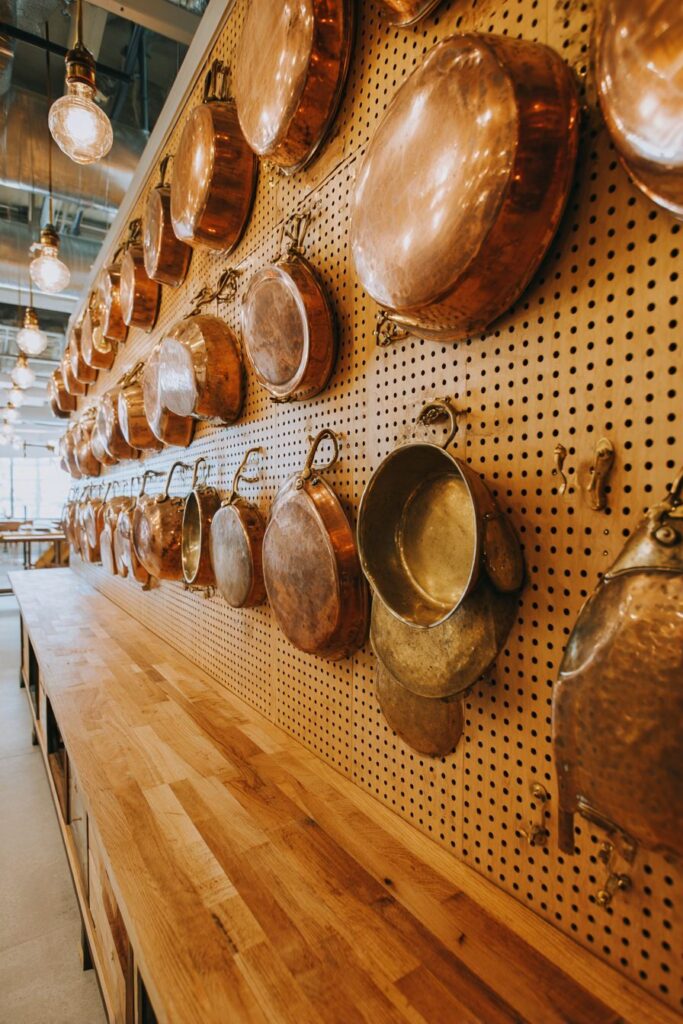
Key Design Tips:
- Select copper pieces with similar patina levels for visual cohesion
- Use brass or copper-toned hooks to maintain the warm metallic theme
- Position pendant lights to create attractive reflections without causing glare
- Leave adequate space between pieces to showcase each item’s individual character
- Consider including a few copper utensils or serving pieces to complete the collection
5. Geometric Honeycomb Spice Storage System
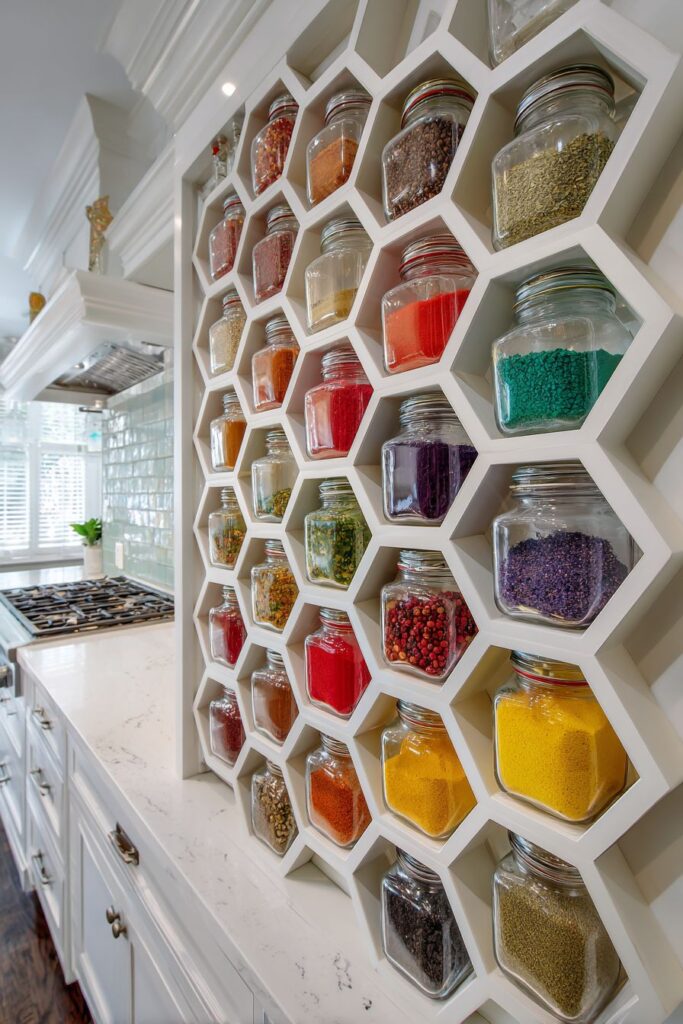
Revolutionize spice storage with an innovative honeycomb-pattern installation that transforms ordinary glass jars into a striking geometric mosaic. This built-in system features hexagonal cubbies precisely cut into white-painted wood backing, creating a pattern that’s both mathematically pleasing and highly functional. Each hexagonal compartment holds a clear glass container filled with colorful spices, creating a natural mosaic effect that celebrates the inherent beauty of culinary ingredients.
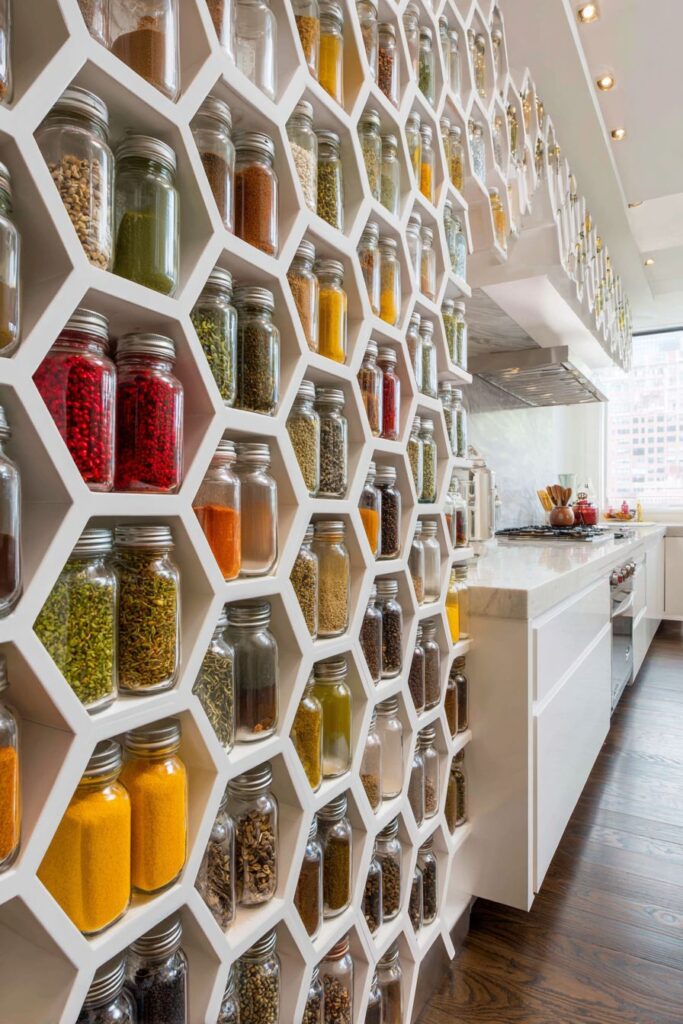
The installation spans the valuable wall space between upper cabinets and countertop, maximizing storage efficiency while creating visual impact. The hexagonal pattern provides optimal space utilization while offering endless arrangement possibilities. Spices can be organized by color to create rainbow effects, grouped by cuisine type for practical cooking efficiency, or arranged by frequency of use for maximum convenience.
Integrated LED strip lighting has been carefully positioned to illuminate the spice collection without creating glare or hot spots. The lighting transforms the installation into a glowing display that showcases the vibrant colors of paprika, turmeric, dried herbs, and exotic spices. Natural daylight from nearby windows enhances these colors during daytime hours while the artificial lighting ensures the display remains striking during evening cooking sessions.
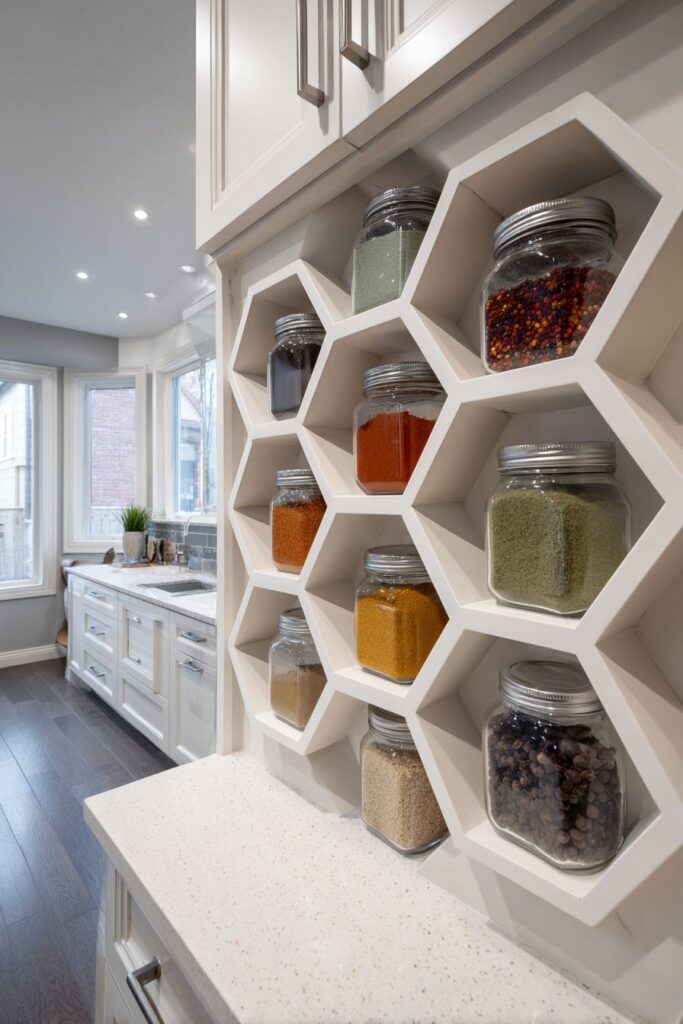
The clear glass containers allow for easy identification while protecting spices from light degradation when not illuminated. This system encourages experimentation with new spices and cooking techniques while keeping frequently used seasonings within easy reach. The geometric pattern creates visual order that appeals to both organized cooks and design enthusiasts.
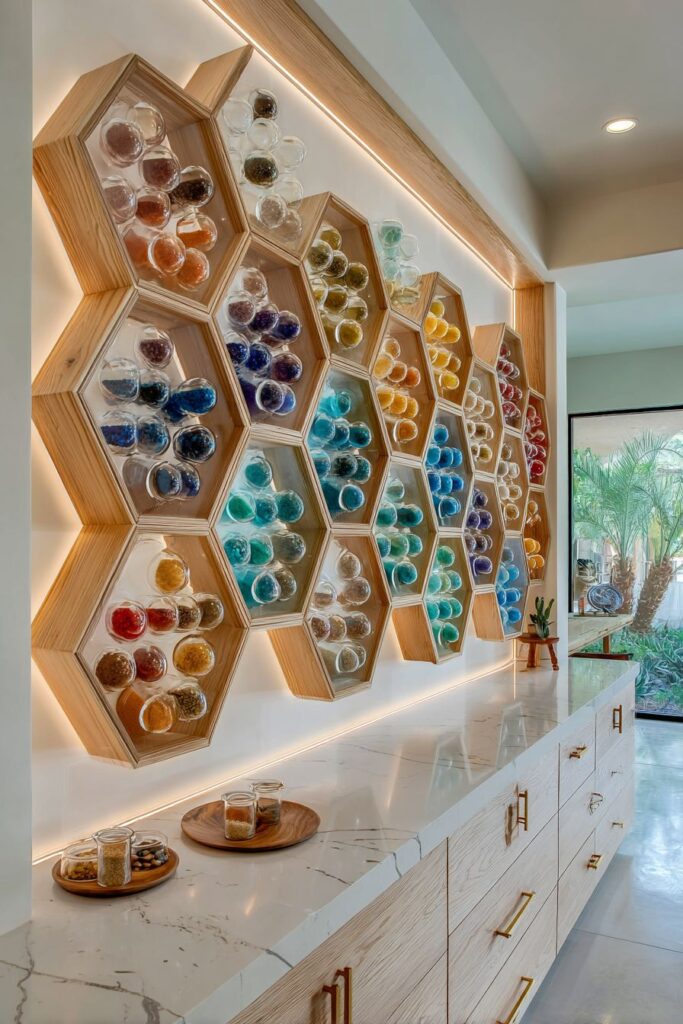
Key Design Tips:
- Measure spice jar dimensions carefully to ensure proper fit within hexagonal compartments
- Use matching glass containers for visual consistency and optimal light transmission
- Install dimmer switches to control lighting intensity based on time of day and mood
- Label jars clearly on multiple sides for easy identification from different angles
- Consider magnetic lids or airtight seals to maintain spice freshness and potency
6. Living Herb Garden Wall System
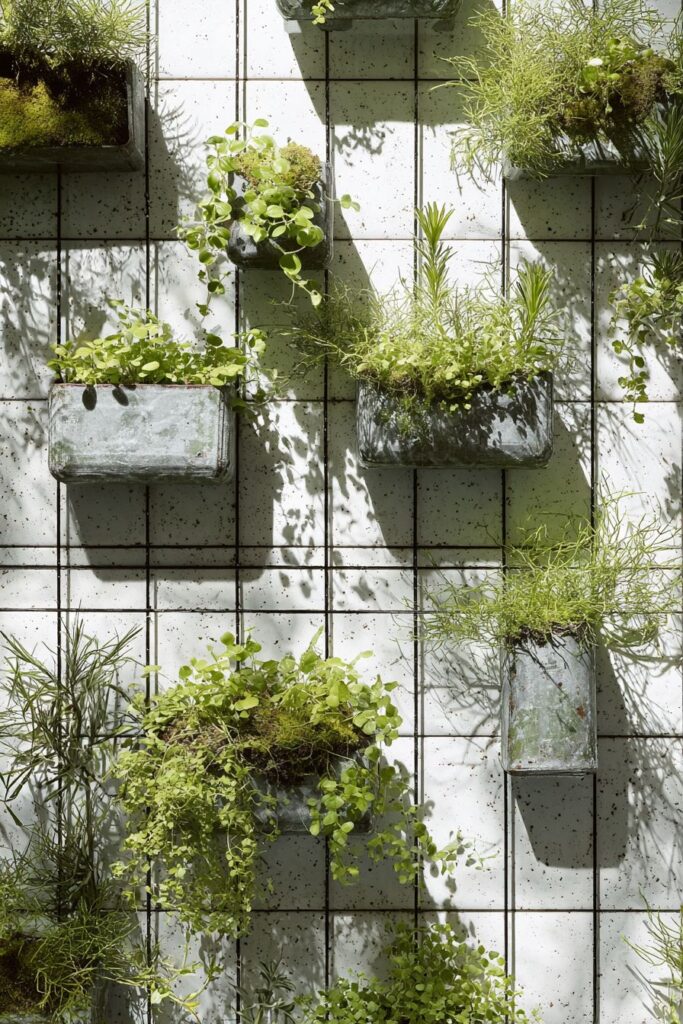
Bring the garden indoors with a sophisticated vertical growing system that creates a living wall of fresh herbs and microgreens. This modular installation features weathered galvanized metal containers arranged in an asymmetrical pattern against pristine white subway tiles, creating compelling contrast between industrial materials and organic plant life. The system represents the ultimate fusion of form and function, providing fresh ingredients while creating a dynamic, ever-changing wall display.
The galvanized planters show authentic weathering patterns that add character and visual interest, while their varied sizes and asymmetrical arrangement prevent the installation from appearing too rigid or institutional. Each container includes proper drainage systems and moisture barriers to protect wall surfaces while ensuring optimal growing conditions for herbs and microgreens.
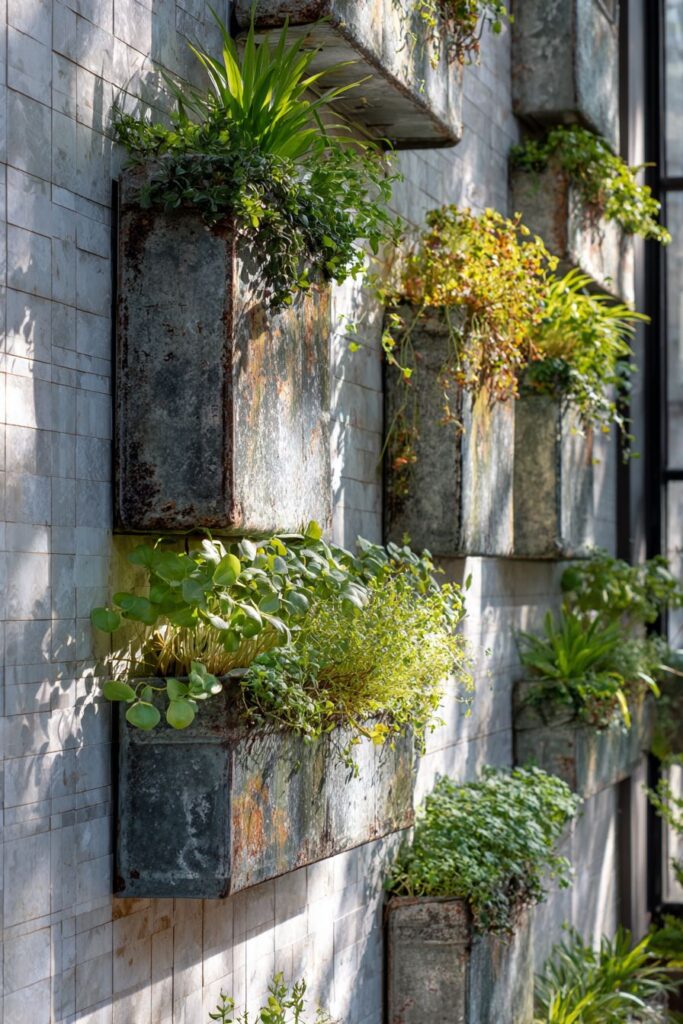
Discretely integrated drip irrigation lines ensure consistent moisture levels without requiring daily attention, making this living wall practical for busy home cooks. Natural grow lights provide supplemental illumination during shorter winter days or in areas with limited natural light, ensuring year-round productivity regardless of seasonal changes or kitchen orientation.
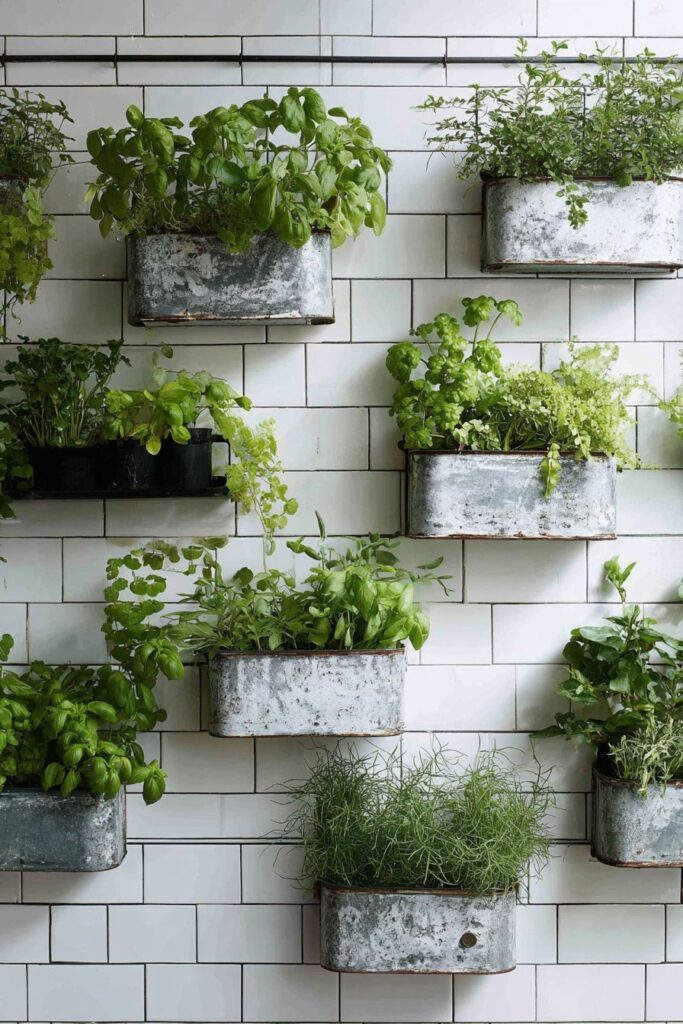
The living wall thrives near south-facing windows where morning light creates beautiful shadows through the foliage, adding another dimension of visual interest as light patterns change throughout the day. The combination of natural and artificial lighting ensures optimal growing conditions while creating dramatic visual effects that make the wall a focal point at any hour.
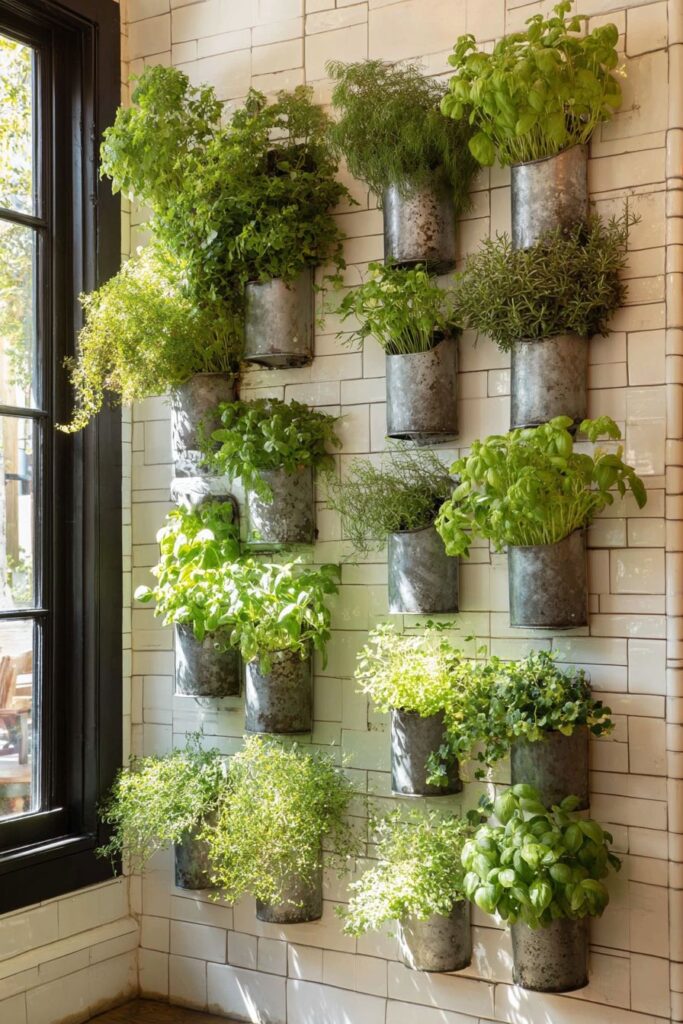
Key Design Tips:
- Choose herbs with similar light and water requirements for easier maintenance
- Install proper waterproofing behind planting areas to prevent wall damage
- Select containers with adequate drainage to prevent root rot and plant failure
- Position grow lights to supplement rather than replace natural lighting when possible
- Plan for seasonal rotation and replacement of annual herbs and microgreens
7. Vintage Coffee Station with Reclaimed Wood Shelving
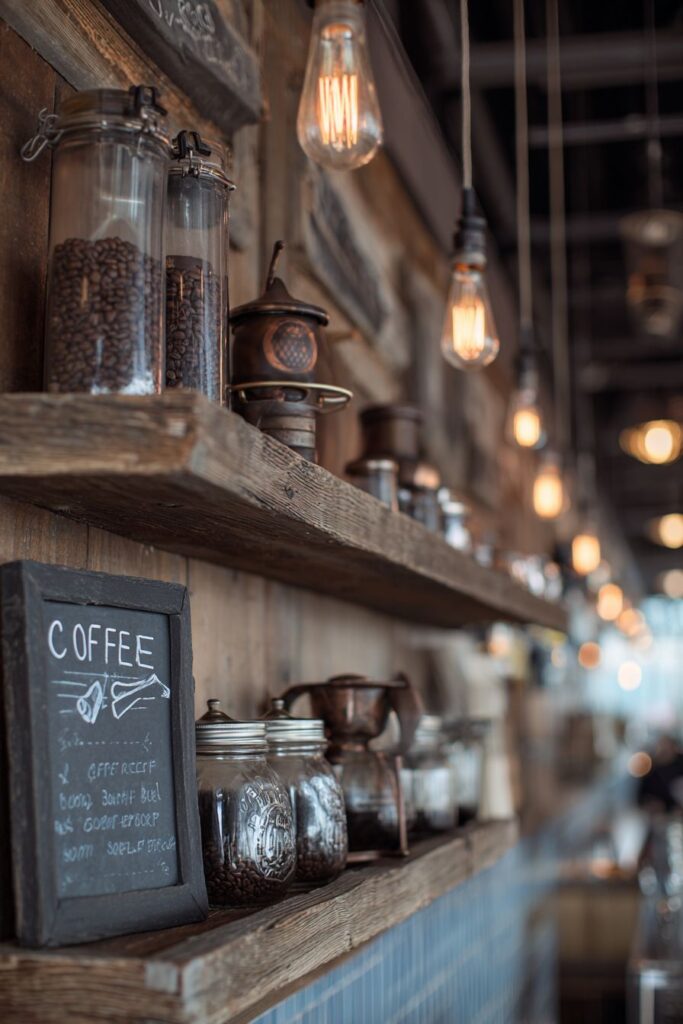
Create a dedicated coffee corner that celebrates the artisanal coffee culture with weathered reclaimed wood shelving displaying coffee-making equipment and bean storage. This installation transforms a small wall area into a functional coffee station that rivals professional cafes in both appearance and capability. The weathered wood planks bring authentic character and warmth, while the careful arrangement of coffee equipment creates visual interest through varied shapes, textures, and materials.
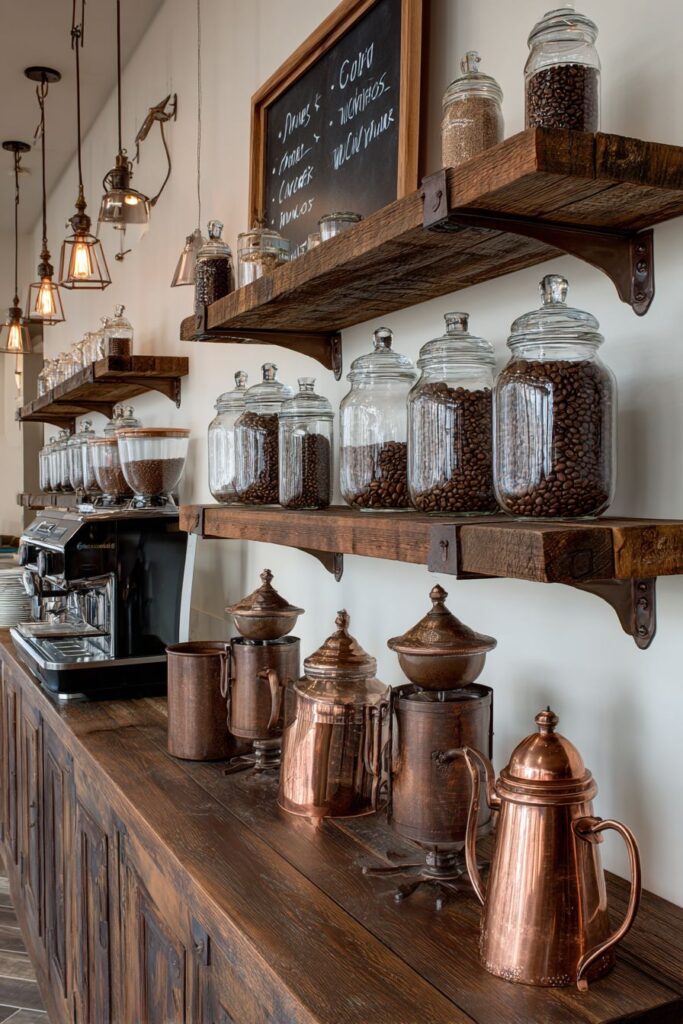
The shelving system accommodates copper French presses that develop beautiful patina over time, ceramic pour-over drippers in earth tones, and mason jars filled with different coffee bean varieties that create natural color variation through their varying shades of brown. Each element has been selected for both functional excellence and visual appeal, creating a display that performs as well as it looks.
A small chalkboard sign lists daily coffee specials written in elegant script, adding a café-like atmosphere while providing practical information about available brews. This detail transforms home coffee preparation into a special ritual while adding authentic coffee house character to the kitchen environment.
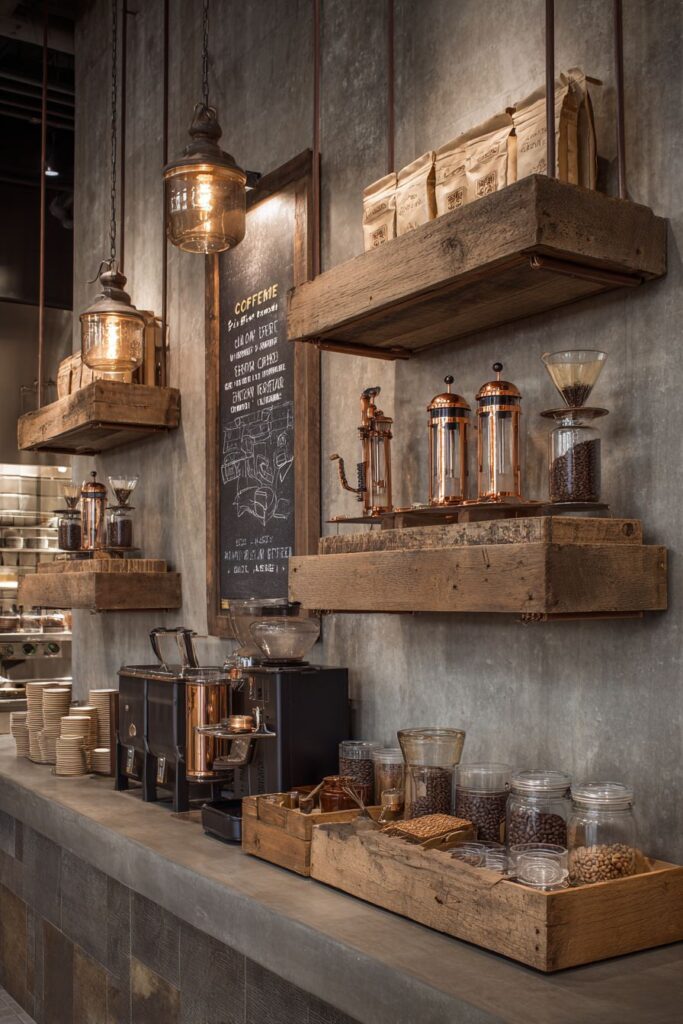
Warm pendant lighting creates cozy ambiance reminiscent of intimate coffee shops while highlighting the rich textures of weathered wood and patinated metal. The lighting choice emphasizes the handcrafted quality of both the shelving and coffee equipment while creating an inviting atmosphere that encourages lingering over morning coffee or afternoon espresso.
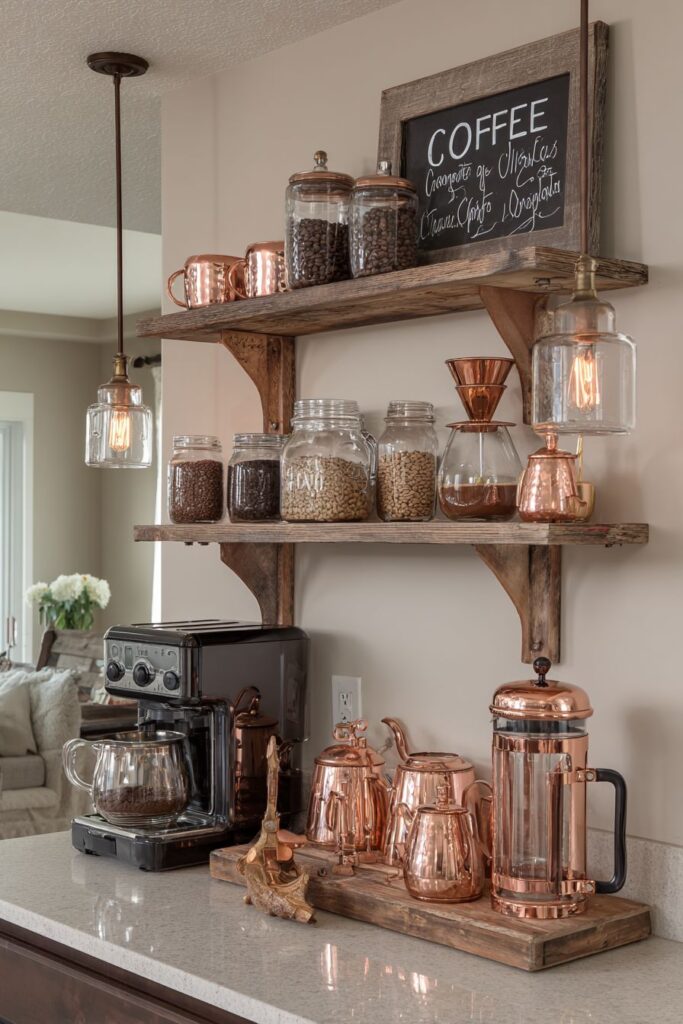
Key Design Tips:
- Select reclaimed wood with consistent thickness but varying grain patterns and weathering
- Group coffee equipment by material type for visual cohesion while maintaining functional accessibility
- Use warm-toned lighting to enhance coffee bean colors and wood grain character
- Include storage for filters, cups, and other coffee accessories within easy reach
- Consider electrical requirements for grinders and other powered equipment when planning layout
8. Professional Magnetic Tool Organization System
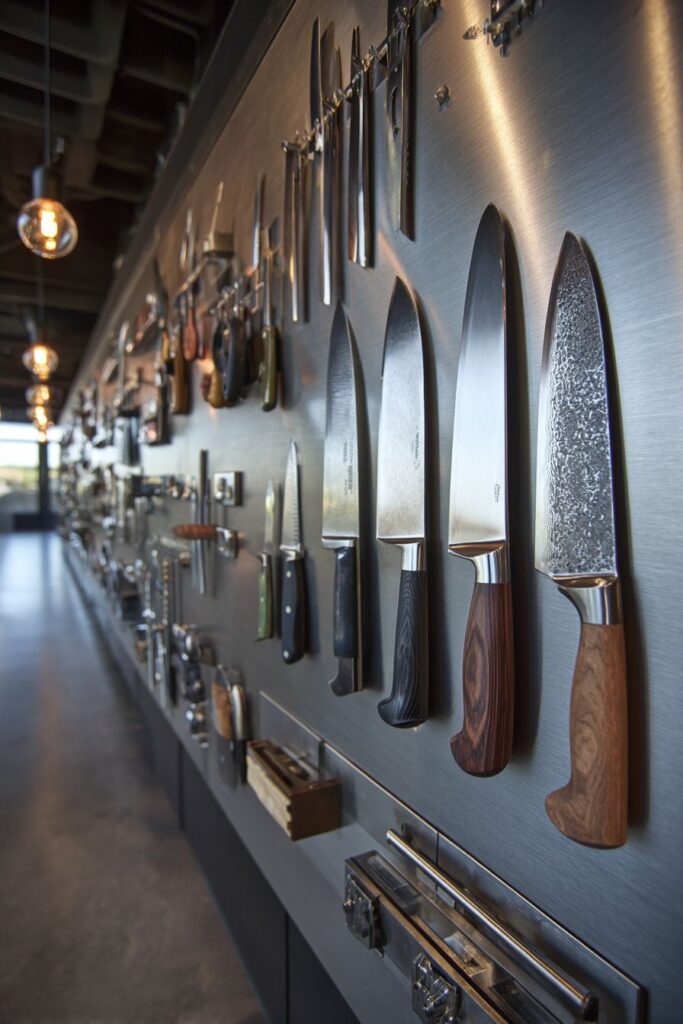
Elevate kitchen functionality with a sleek stainless steel magnetic system that keeps professional-quality knives and essential tools organized and easily accessible. This minimalist approach celebrates the beauty of well-crafted kitchen implements while ensuring they remain sharp and ready for use. The brushed metal surface provides subtle texture that reflects ambient light while creating sophisticated contrast against painted walls or natural materials.
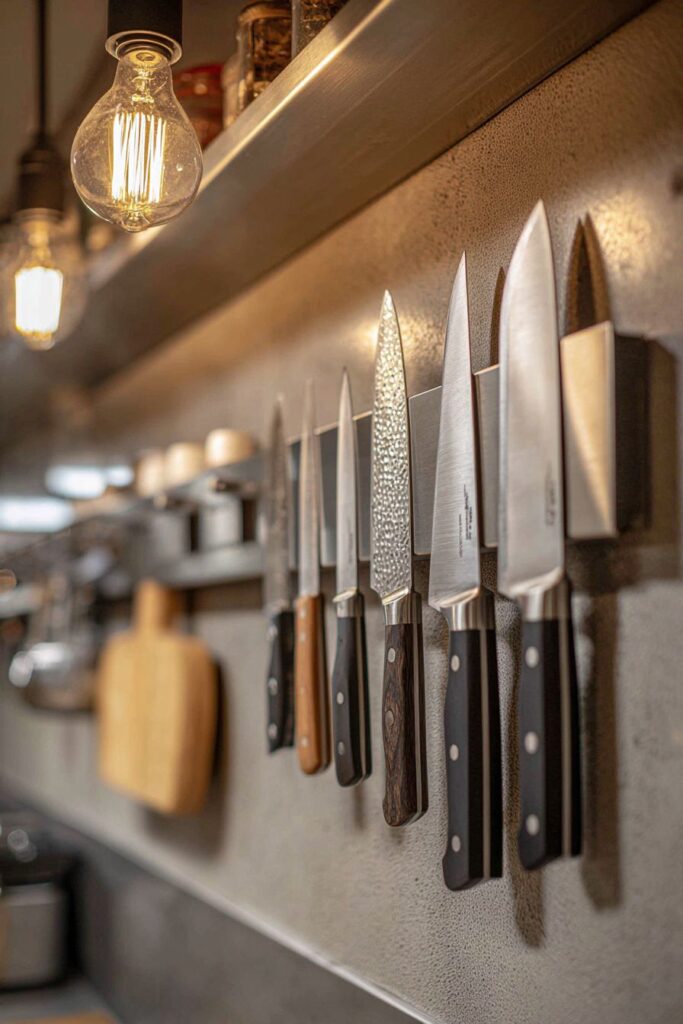
The magnetic strip securely holds chef’s knives, paring knives, and specialized tools while protecting blade edges better than traditional knife blocks. The varied shapes and textures of handles create visual interest – rich walnut wood, textured steel, composite materials – each representing different aspects of culinary craftsmanship. This functional display showcases the tools of serious cooking while keeping them optimally positioned above the main prep area.
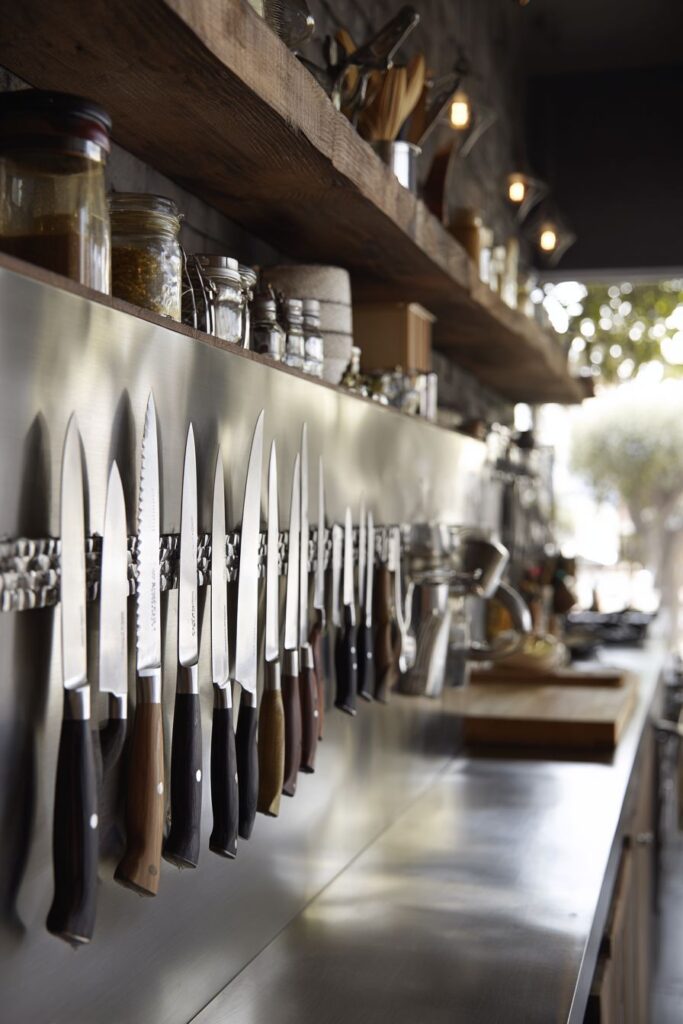
The stainless steel surface integrates seamlessly with professional appliances and fixtures, creating a cohesive aesthetic that appeals to serious home cooks. The brushed finish minimizes fingerprints and water spots while providing subtle texture that prevents the installation from appearing cold or institutional.
Natural lighting from pendant fixtures positioned above the prep area ensures excellent visibility while highlighting the quality and craftsmanship of displayed tools. This practical lighting eliminates shadows that could interfere with food preparation while showcasing the professional character of the tool collection.
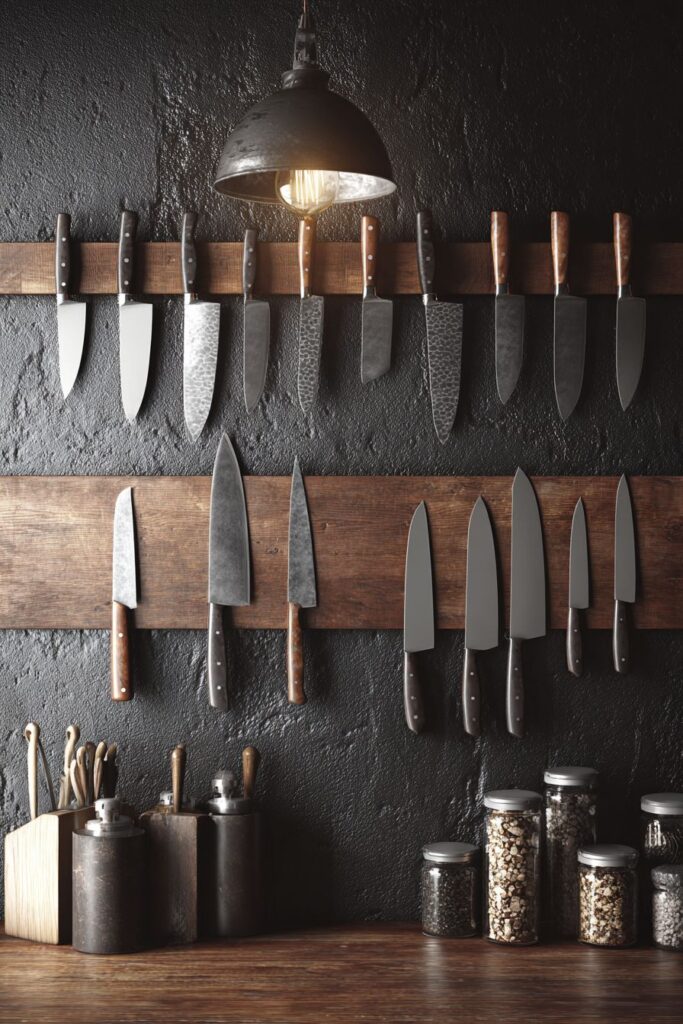
Key Design Tips:
- Choose magnetic strips with sufficient holding power for heavy professional knives
- Position strips at optimal height for both safety and accessibility during food preparation
- Select tools with complementary handle materials and finishes for visual cohesion
- Install adequate task lighting to eliminate shadows during knife work
- Consider including a few specialty tools that showcase your particular cooking interests
9. Hand-Painted Ceramic Tile Mosaic Backsplash
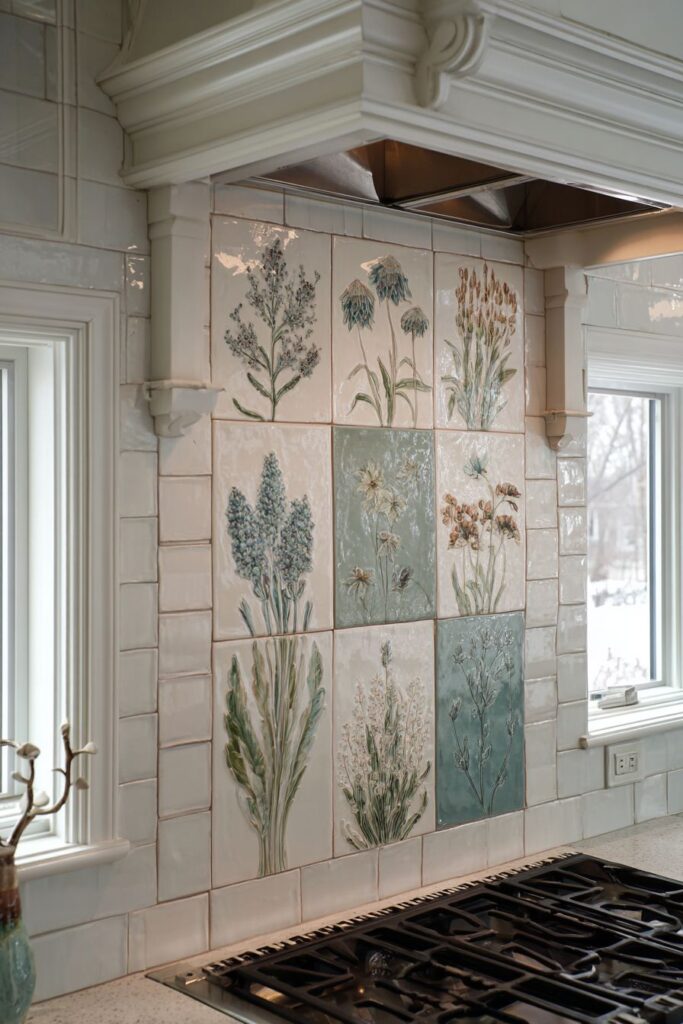
Transform the area behind your range with artisan-crafted ceramic tiles featuring botanical motifs in soft blue and sage green tones. This custom mosaic installation creates a stunning focal point that celebrates handcrafted artistry while providing practical splash protection. Each tile displays subtle variations in glaze application and firing results, creating the authentic imperfections that distinguish handmade ceramics from mass-produced alternatives.
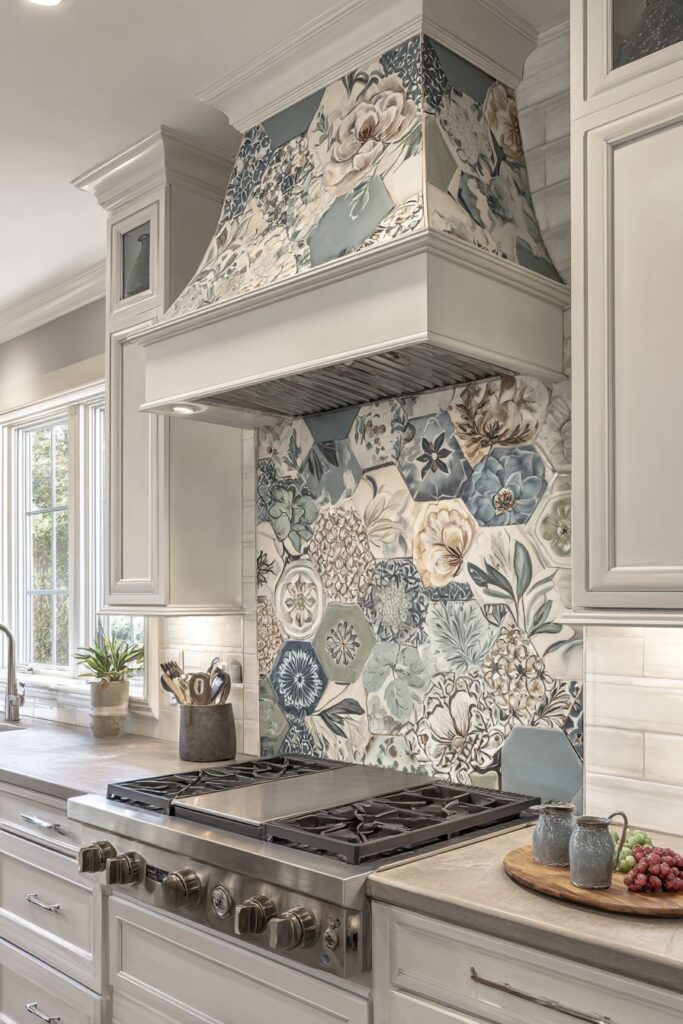
The botanical motifs range from delicate herb illustrations to stylized leaf patterns, each rendered in soft watercolor-style glazes that complement natural kitchen materials. The cream backgrounds provide cohesive foundation while the blue and green accents add color without overwhelming the space. These handcrafted tiles create visual interest through their subtle irregularities while maintaining overall design coherence.
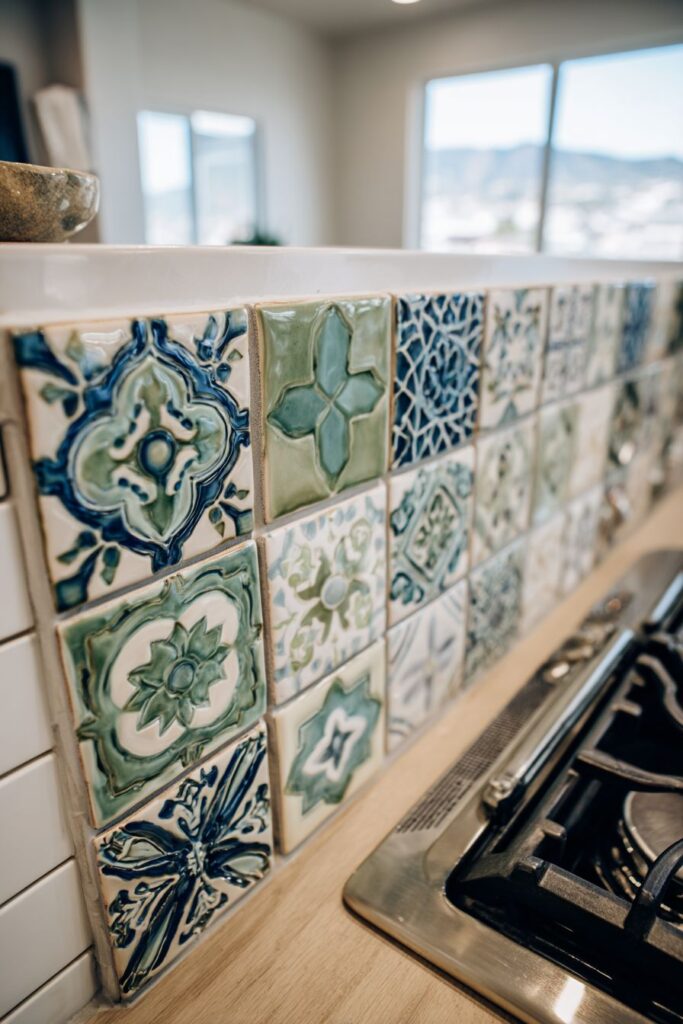
The mosaic panel creates dramatic contrast against adjacent areas of simple white subway tiles, demonstrating how artisanal elements can be integrated thoughtfully without dominating the entire space. This approach allows the handcrafted tiles to function as kitchen artwork while maintaining the clean, functional aesthetic that defines contemporary kitchen design.
Natural light from nearby windows illuminates the painted details and glossy ceramic surfaces, revealing the depth and complexity of the handcrafted glazes. The interplay between matte cream backgrounds and glossy painted elements creates subtle textural variation that changes throughout the day as lighting conditions shift.
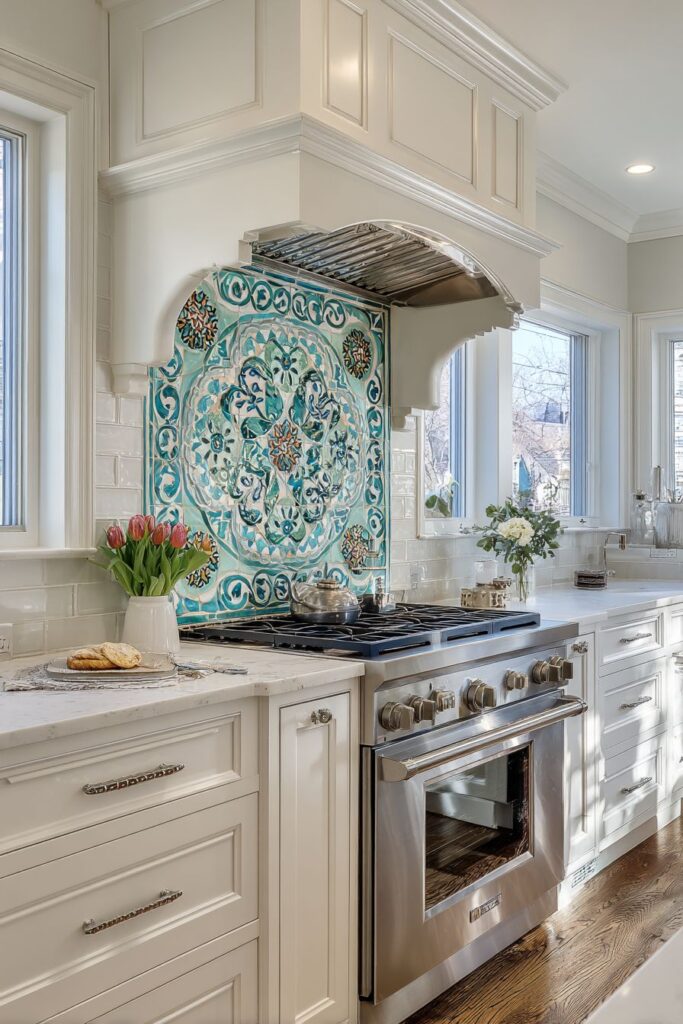
Key Design Tips:
- Order extra tiles to account for natural variations and potential future repairs
- Use contrasting grout colors to emphasize individual tile character and handcrafted quality
- Position tiles at eye level where detailed artwork can be easily appreciated
- Consider the overall color palette when selecting accent tile colors and patterns
- Seal handcrafted tiles appropriately to protect against kitchen moisture and splashing
10. Cast Iron and Enamelware Wall Display
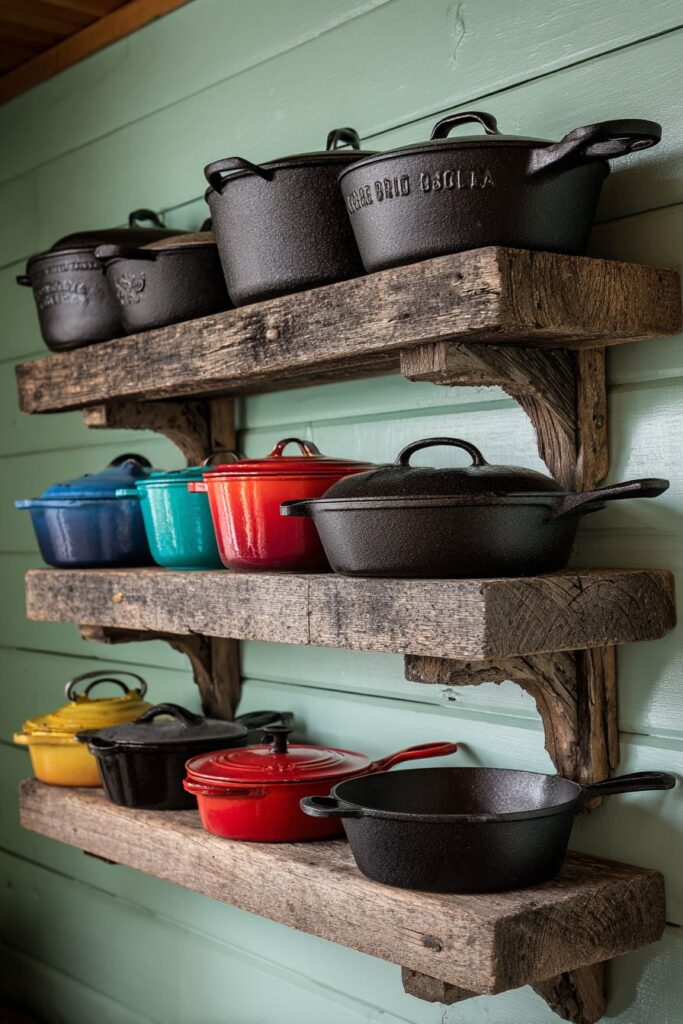
Celebrate the durability and beauty of vintage cookware with a wall-mounted display featuring well-seasoned cast iron skillets and colorful enamelware pieces. This collection showcases the authentic character that develops through years of use, from the deep black patina of properly seasoned cast iron to the charming chips and wear patterns of vintage enamel pieces. Rustic wooden brackets provide sturdy support while adding natural warmth that complements both the raw iron and colorful enamel finishes.
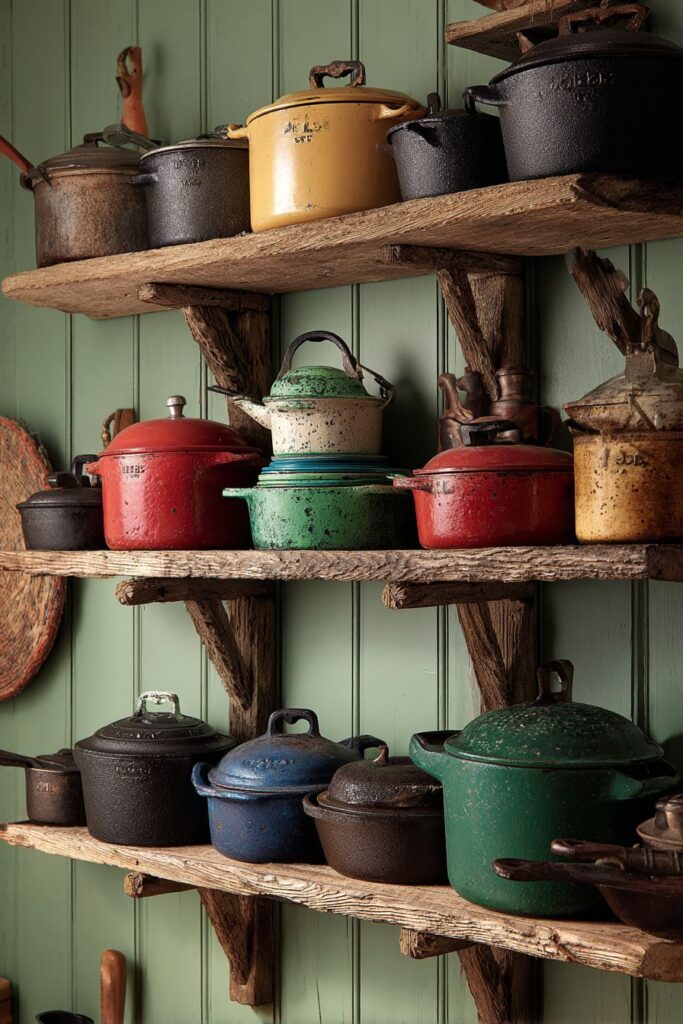
The weathered brackets, crafted from reclaimed wood, show authentic aging patterns that mirror the vintage character of the displayed cookware. Various sizes of skillets, Dutch ovens, and enamel pieces create visual rhythm while demonstrating the practical range of these time-tested cooking tools. The authentic chips and patina tell stories of countless family meals and kitchen adventures, creating character that cannot be artificially replicated.
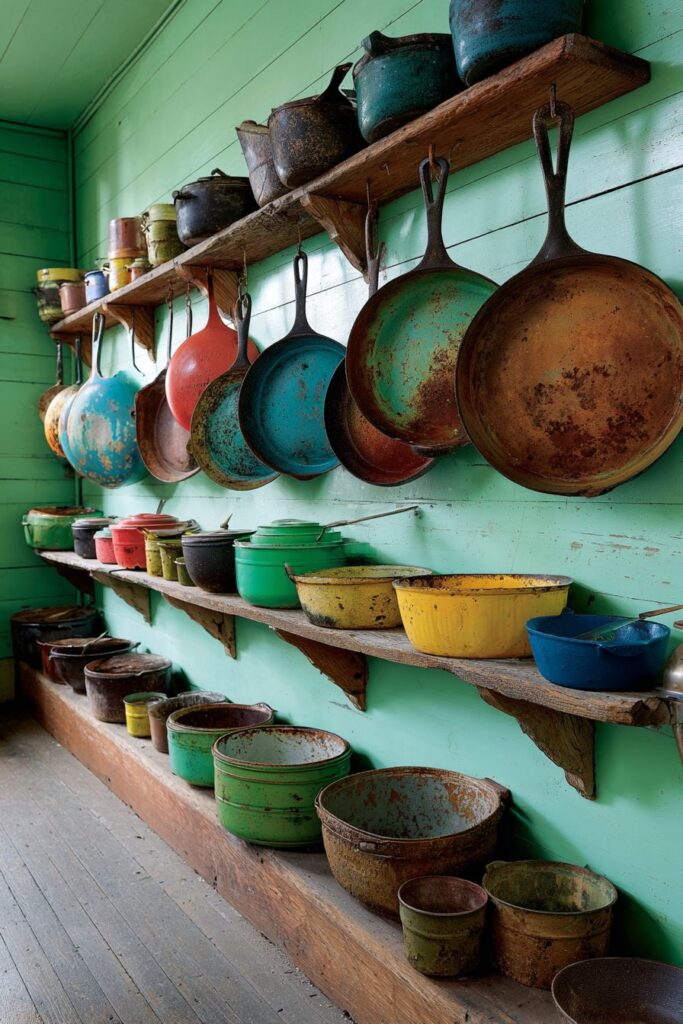
Mounted against shiplap paneling painted in soft sage green, the collection gains sophisticated backdrop that enhances rather than competes with the cookware display. The painted wood provides subtle color that complements both the black cast iron and the faded pastels of vintage enamelware, creating harmonious color relationships throughout the installation.
Warm brass pendant lighting emphasizes the rich patina and natural wear patterns while creating attractive highlights on both matte cast iron surfaces and glossy enamel finishes. This lighting choice celebrates the authentic character of vintage pieces while ensuring the display remains visible and appealing during evening hours.
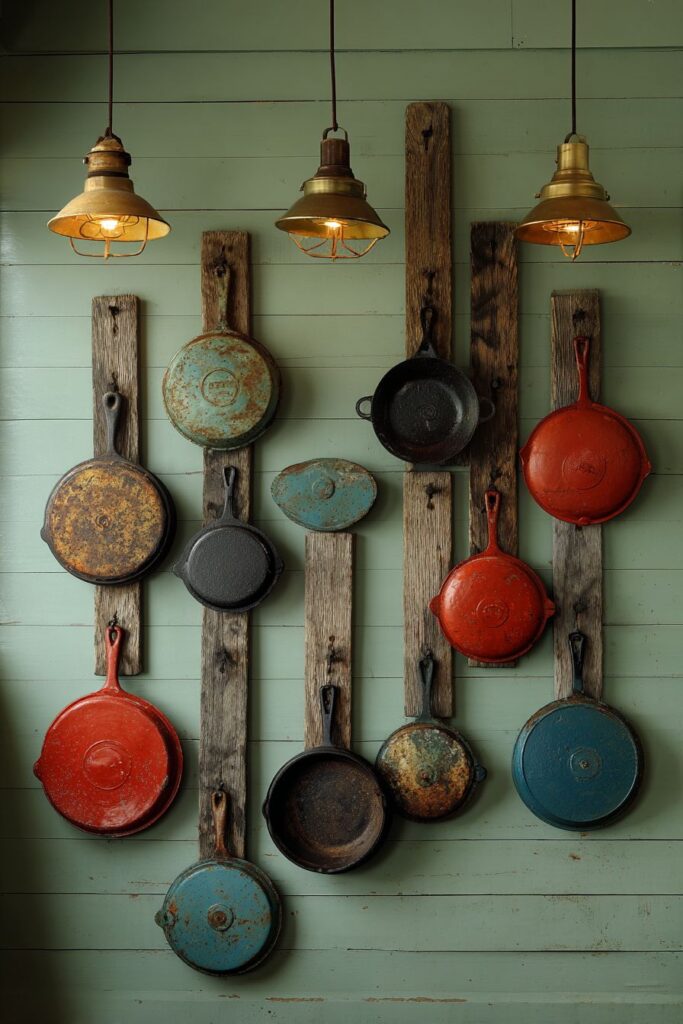
Key Design Tips:
- Select cast iron pieces with consistent seasoning levels for visual coherence
- Choose enamelware with complementary color palettes despite varying conditions
- Install brackets capable of supporting heavy cast iron pieces safely
- Position lighting to highlight authentic patina without creating harsh shadows
- Consider including a few cooking utensils to complete the vintage kitchen theme
11. Wine Cork Mosaic Accent Wall Installation
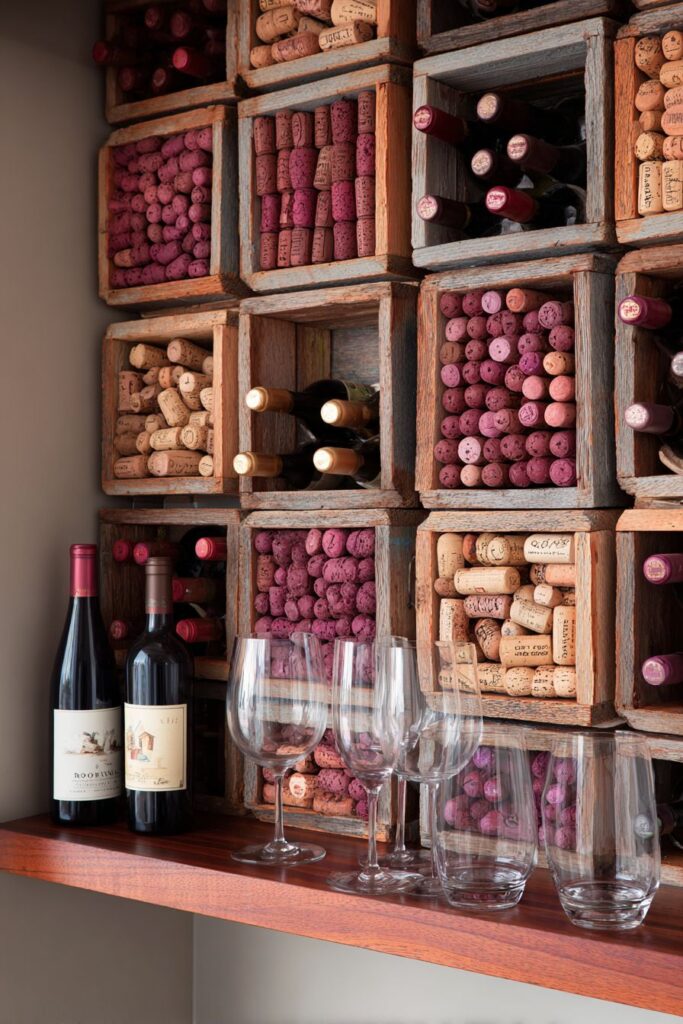
Create textural drama with an innovative wine cork installation that transforms collected corks into sophisticated wall art. This floor-to-ceiling installation utilizes hundreds of wine corks arranged in geometric patterns within reclaimed wooden wine crate frames, creating natural texture and color variation that ranges from light oak to deep burgundy-stained cork. The installation occupies a narrow alcove behind a beverage station, creating intimate atmosphere while showcasing years of wine appreciation.
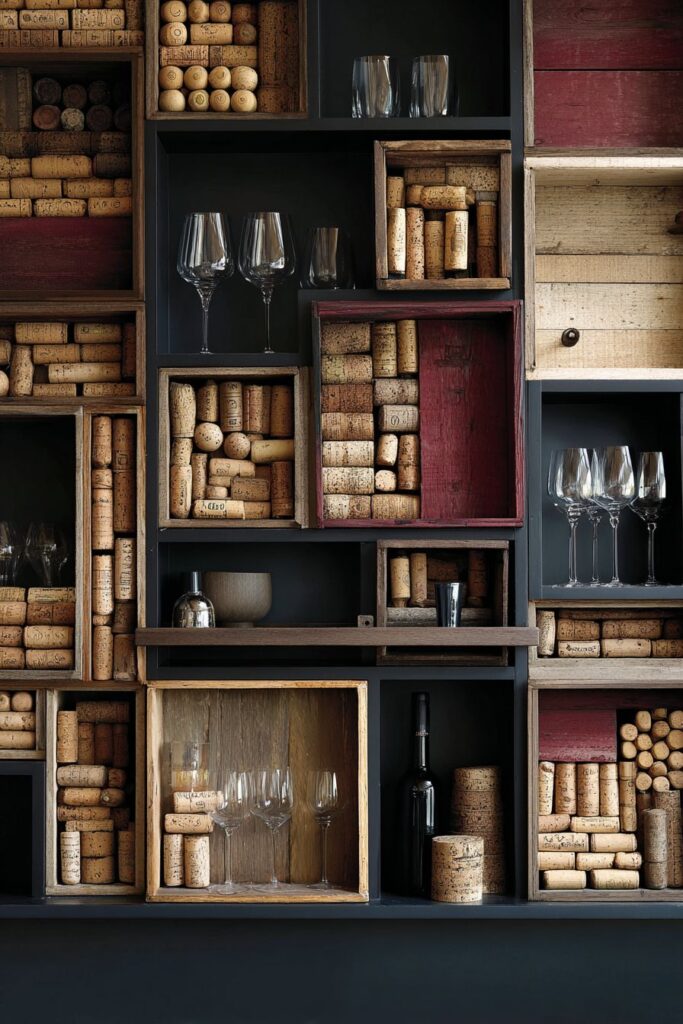
The reclaimed wine crate frames provide structural organization while adding authentic wine cellar character to the installation. Each frame contains carefully arranged corks that create subtle pattern variations through their natural color differences and aging characteristics. Some corks retain their original printing while others show the deep staining that comes from years of wine contact, creating rich color variation that adds visual depth.
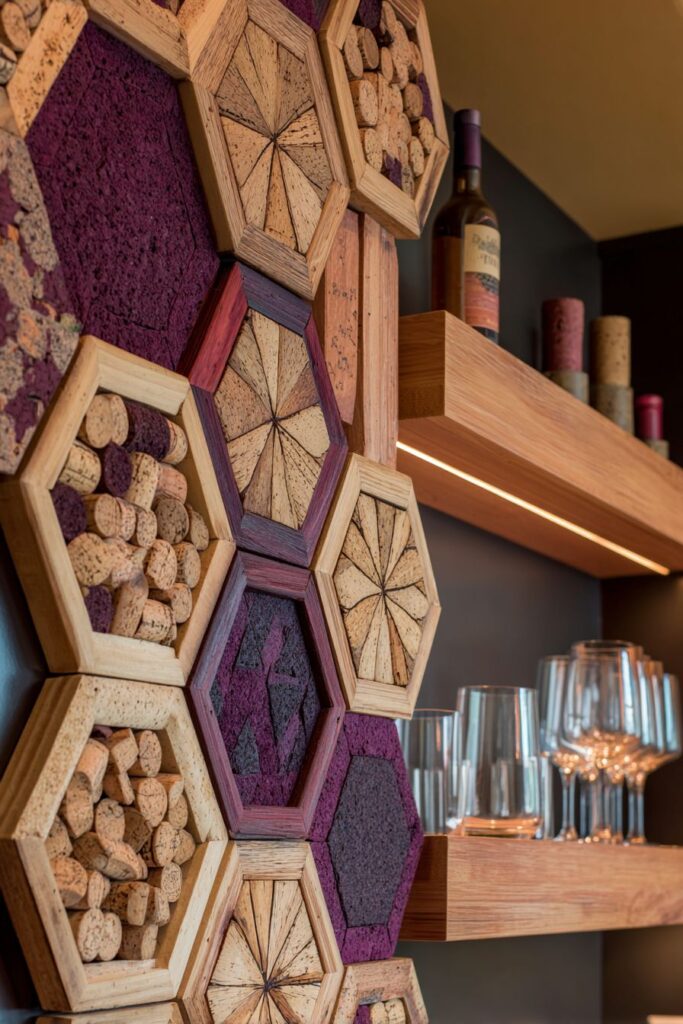
Integrated LED strip lighting has been positioned to create dramatic uplighting that emphasizes the cork textures while creating subtle shadows between individual pieces. This lighting transforms what could be simply recycled materials into sophisticated textural art that changes appearance throughout the day as lighting conditions vary.
A floating shelf positioned at appropriate height holds wine glasses and accessories, creating functional integration with the artistic installation. This practical element ensures the area serves both aesthetic and functional purposes while maintaining the wine appreciation theme throughout the space.
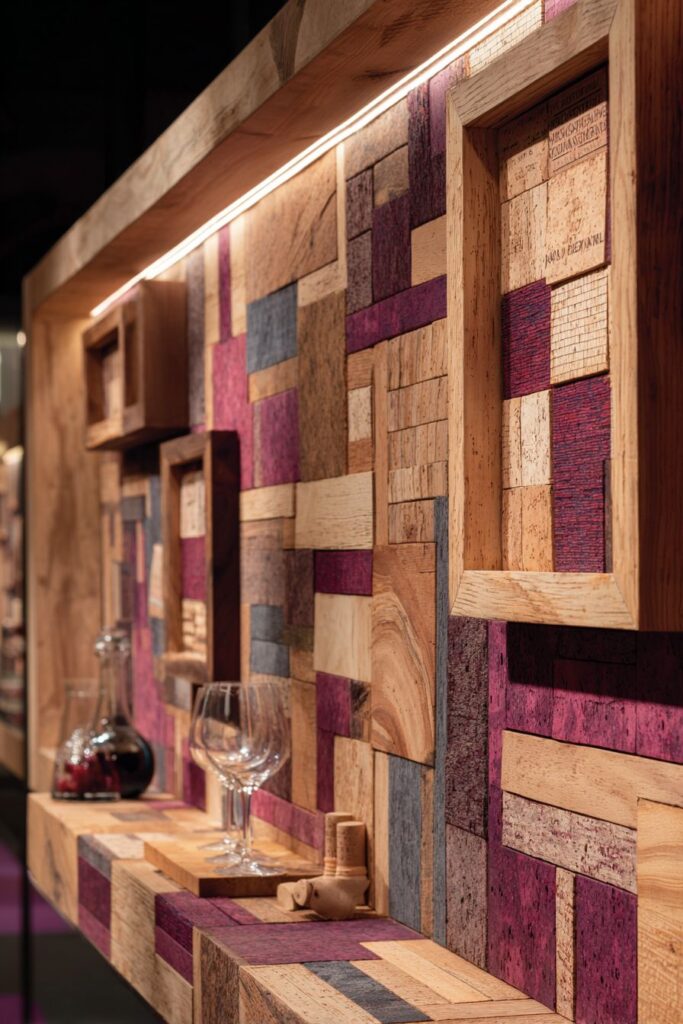
Key Design Tips:
- Clean and sort corks by color and condition before installation for optimal visual impact
- Use food-safe adhesives when installing corks to prevent deterioration over time
- Plan geometric patterns on paper before beginning installation to ensure visual balance
- Install adequate ventilation to prevent moisture accumulation behind cork installation
- Consider incorporating meaningful corks from special occasions or memorable wines
12. Farm-Style Plate Rack with Vintage Dishware
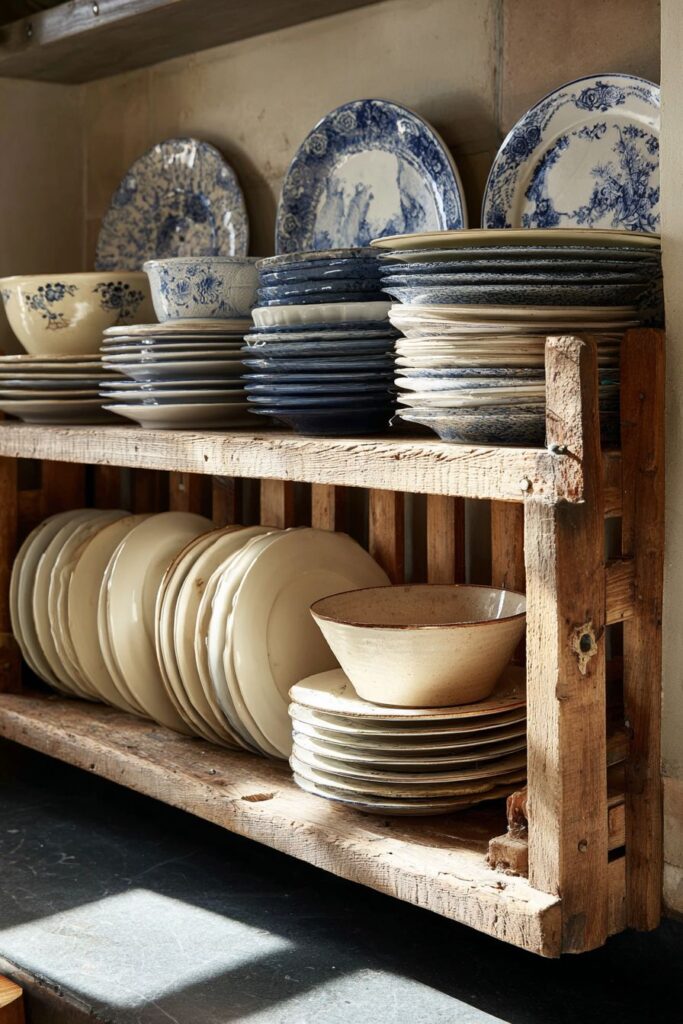
Showcase vintage transferware and ironstone dishes with traditional open plate rack construction that combines storage efficiency with nostalgic charm. This weathered pine rack features classic dowel construction that allows air circulation while displaying dishes attractively. The blue and white patterned plates, cream-colored ironstone platters, and rustic ceramic bowls each show gentle wear and authentic aging patterns that speak to their history of family use and care.
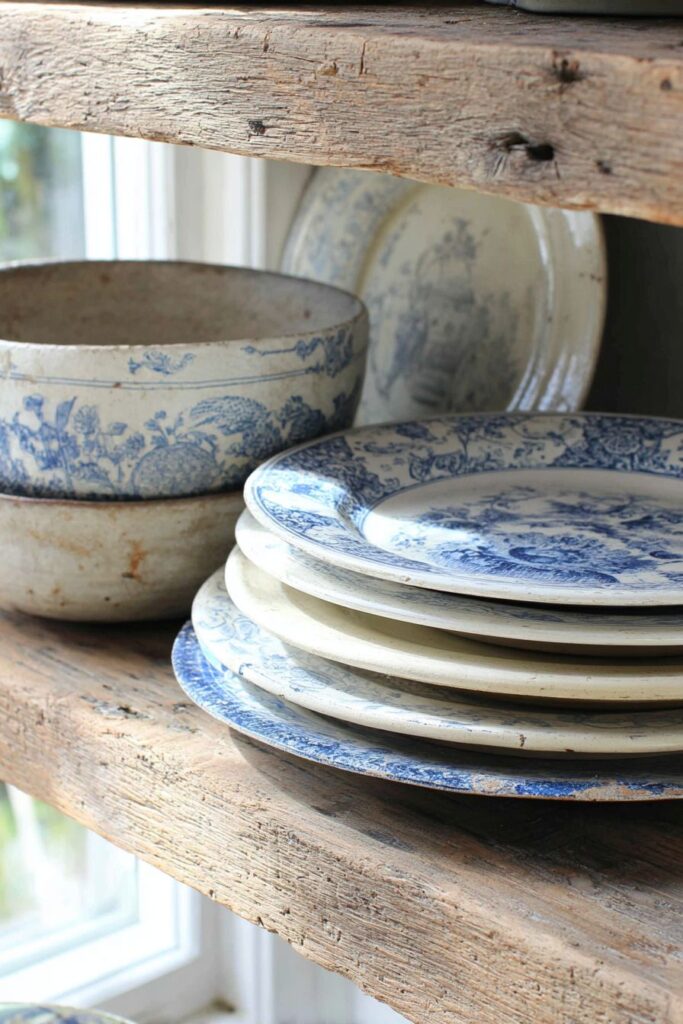
The traditional rack construction allows dishes to be stored vertically for optimal space utilization while creating attractive display opportunities. Each piece is easily accessible for daily use while contributing to the overall visual composition. The weathered pine construction shows authentic aging that complements the vintage dishware character.
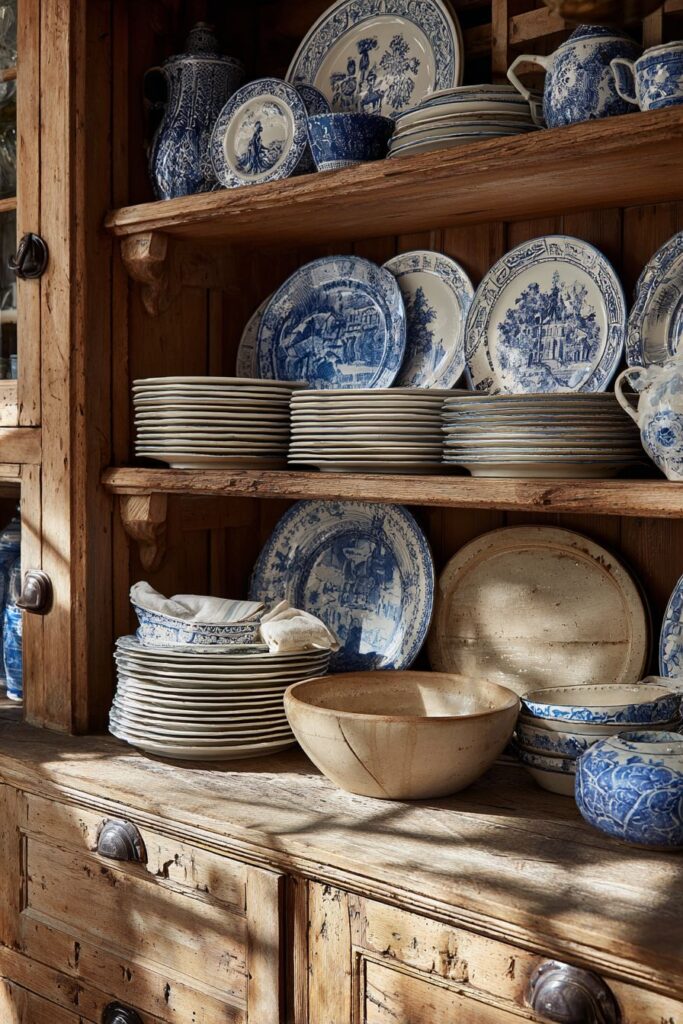
The blue and white transferware patterns range from delicate florals to bold geometric designs, creating visual interest while maintaining color coherence. Cream-colored ironstone pieces provide neutral balance while their simple forms emphasize functional beauty. Rustic ceramic bowls add organic shapes and earth-tone colors that ground the collection in natural materials.
Natural light from nearby windows creates soft highlights on ceramic glazes while revealing the subtle color variations and pattern details that make vintage dishware so appealing. The changing light throughout the day ensures the display remains dynamic and interesting regardless of viewing time.
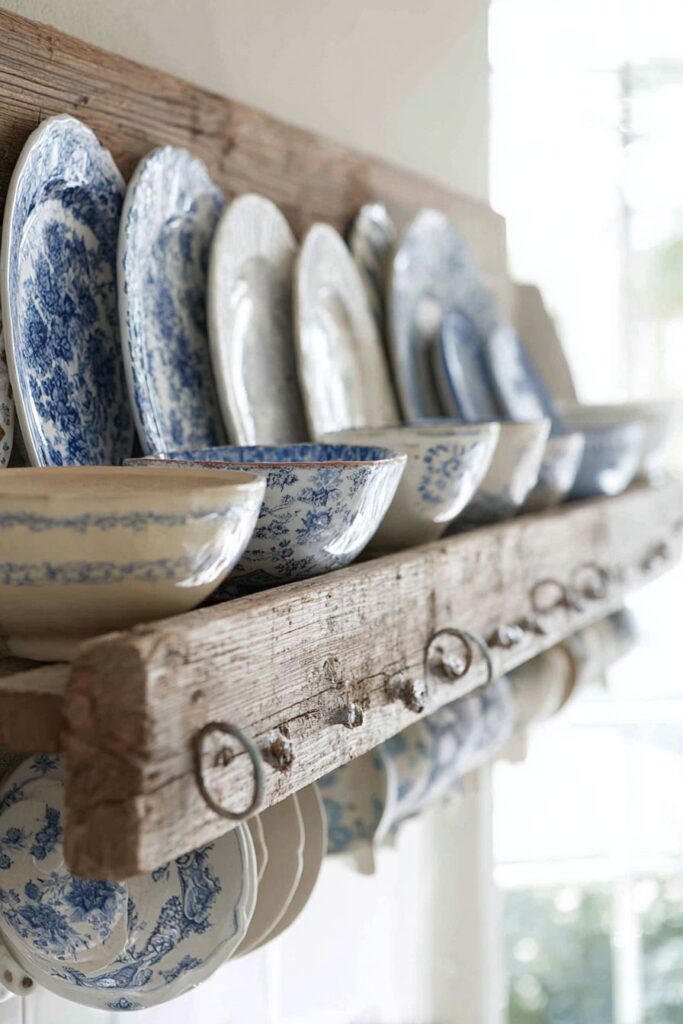
Key Design Tips:
- Select dishes with similar color palettes despite varying patterns and manufacturers
- Ensure rack construction can accommodate varying dish sizes and thicknesses safely
- Position rack where dishes remain easily accessible for daily use
- Consider seasonal rotation to showcase different pieces throughout the year
- Include serving pieces and platters to create scale variation and functional diversity
13. Modern Geometric Herb Garden Shelving
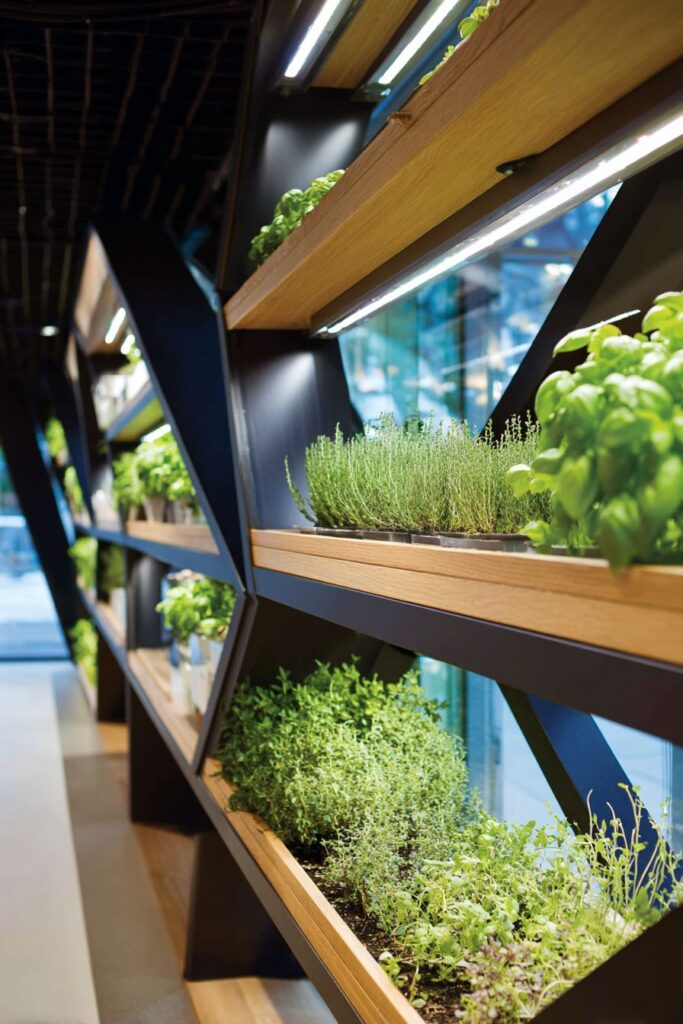
Integrate contemporary design with sustainable living through angular metal framework supporting natural wood shelves and built-in planters. This sophisticated system combines matte black metal structure with warm wood surfaces, creating striking contrast while providing multi-level growing space for kitchen herbs. The geometric design brings contemporary sculpture qualities to functional garden storage.
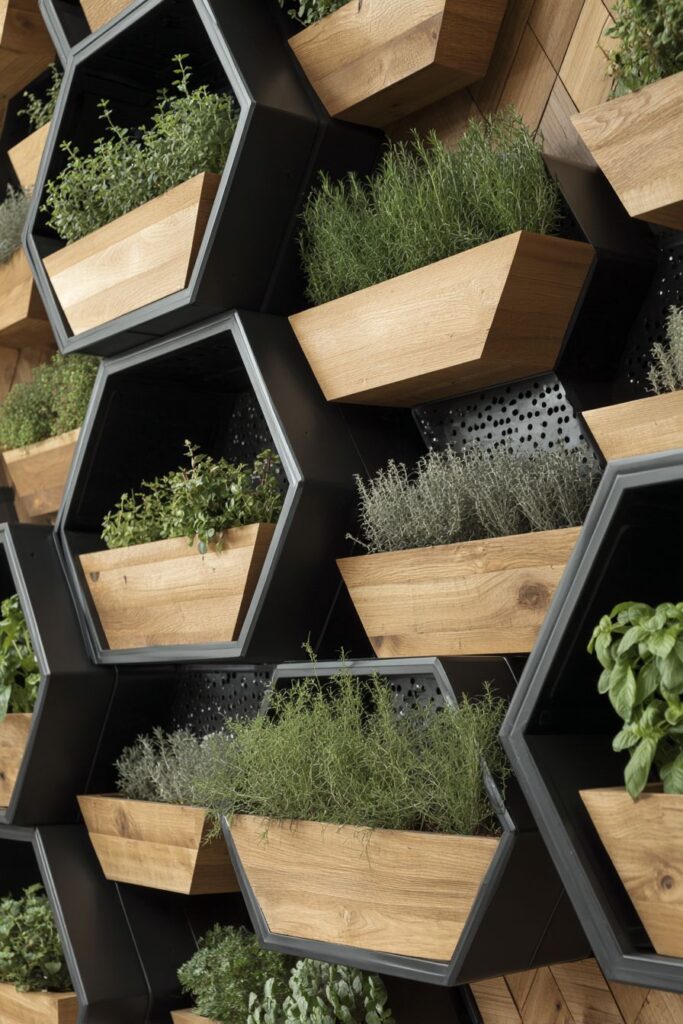
The angular framework creates visual interest through its mathematical precision while supporting natural wood shelves at varying heights. Each level incorporates built-in planter boxes with proper drainage systems that protect surrounding surfaces while providing optimal growing conditions. Fresh herbs like thyme, oregano, and mint create living color variations against the clean geometric lines.
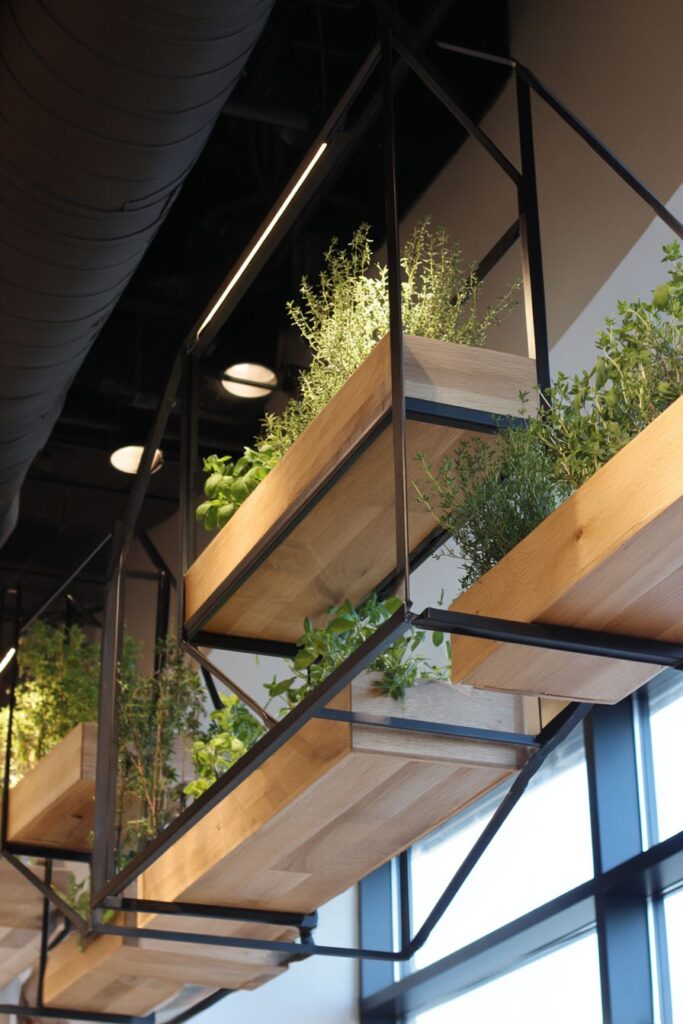
LED grow lights integrated into the framework provide supplemental illumination during evening hours and shorter winter days. These lights ensure consistent growing conditions while creating dramatic uplighting effects that make the living plants appear to glow against the dark metal framework.
The natural wood shelves provide storage space for gardening supplies, ceramic pots, and other kitchen accessories while maintaining the system’s functional integration with kitchen activities. The wood tones warm the overall composition while creating visual connection with other natural materials throughout the kitchen.
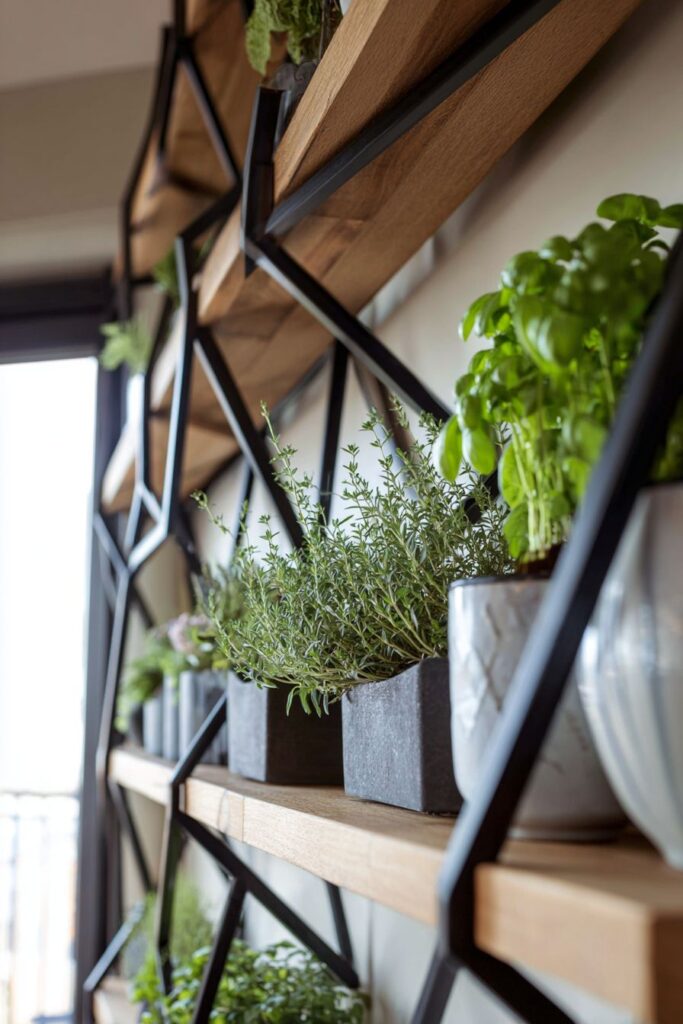
Key Design Tips:
- Choose herbs with similar light and water requirements for maintenance efficiency
- Install proper drainage systems to prevent water damage to surrounding surfaces
- Select wood species that can withstand occasional moisture exposure
- Position grow lights to supplement natural lighting without creating plant stress
- Plan for seasonal herb rotation and replacement as plants mature
14. Antique Kitchen Tool Collection Display
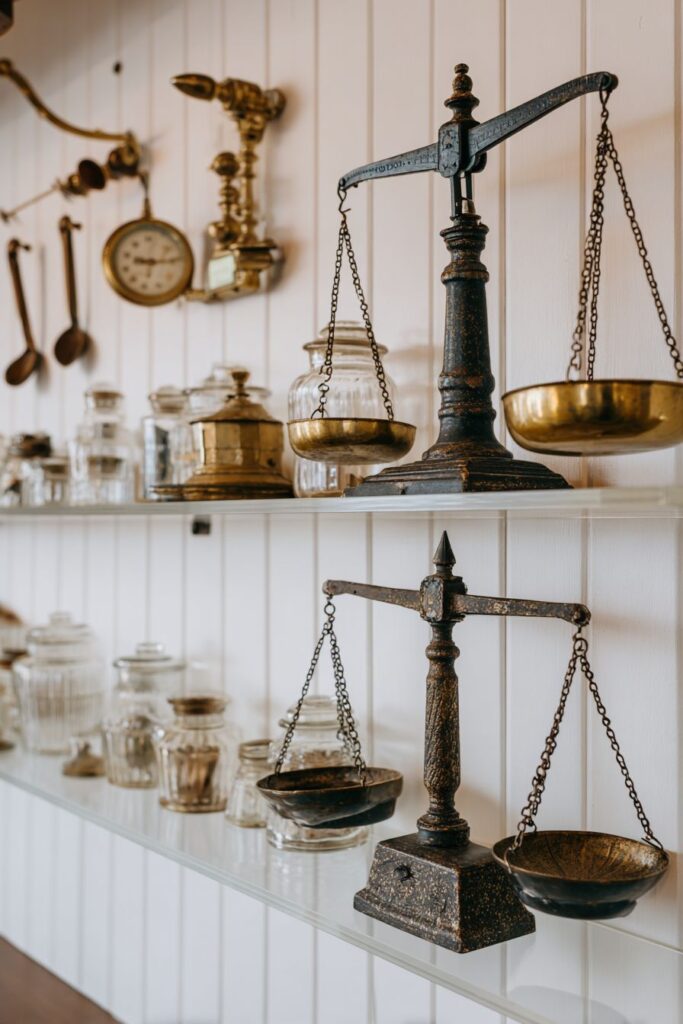
Create historical interest with carefully curated antique kitchen scales and measuring tools arranged on floating shelves with invisible mounting systems. This collection celebrates the evolution of kitchen tools while showcasing the superior craftsmanship of earlier eras. Brass and cast iron scales in various sizes demonstrate different approaches to kitchen measurement, while vintage glass measuring cups and wooden measuring spoons add material diversity and authentic patina.
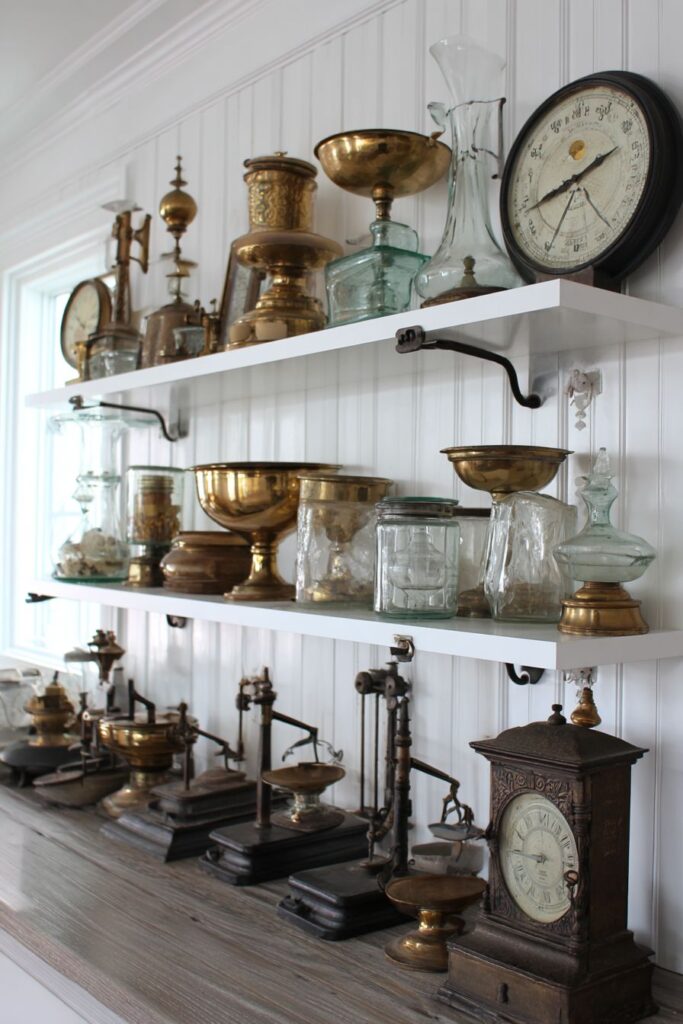
Each piece represents different historical periods and manufacturing techniques, creating educational value alongside aesthetic appeal. The brass pieces show natural tarnishing and wear patterns that speak to decades of kitchen use, while cast iron items display the deep black patina that develops through proper seasoning and care. Glass measuring cups reveal the clarity and thickness that distinguished quality vintage glassware.
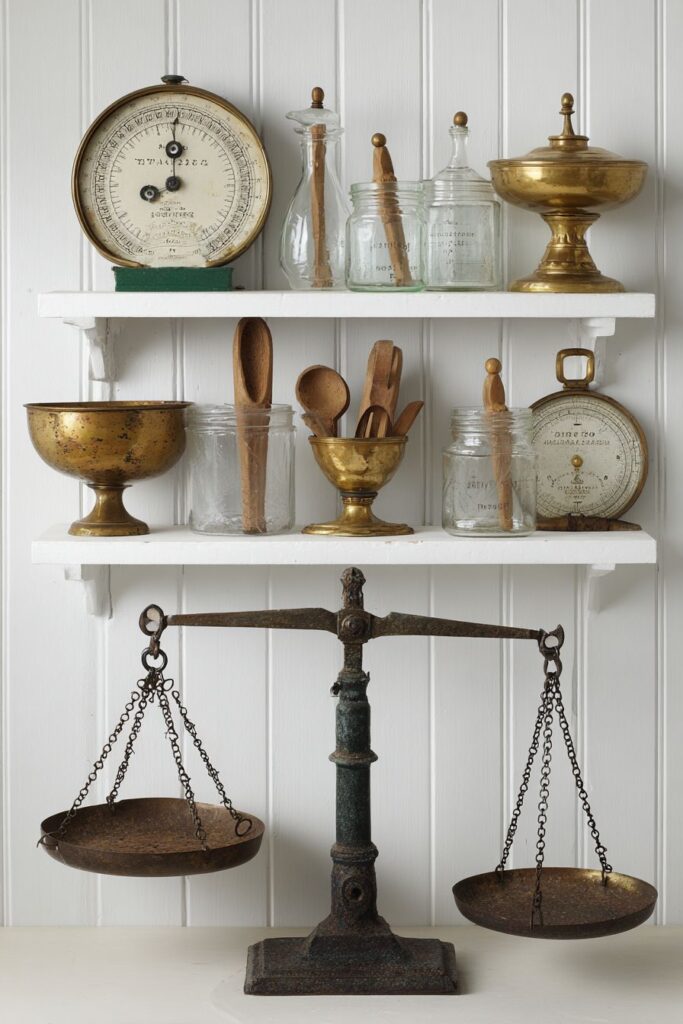
Positioned against white beadboard wainscoting, the collection gains clean backdrop that emphasizes the tools’ individual character without visual competition. The painted wood provides subtle texture that complements the varied materials while ensuring each piece remains clearly visible and appreciated.
Under-cabinet fixtures cast warm light across the collection, highlighting metallic patina and creating attractive shadows that emphasize dimensional qualities. This lighting choice ensures the display remains visible during evening cooking activities while celebrating the authentic aging characteristics that make vintage tools so appealing.
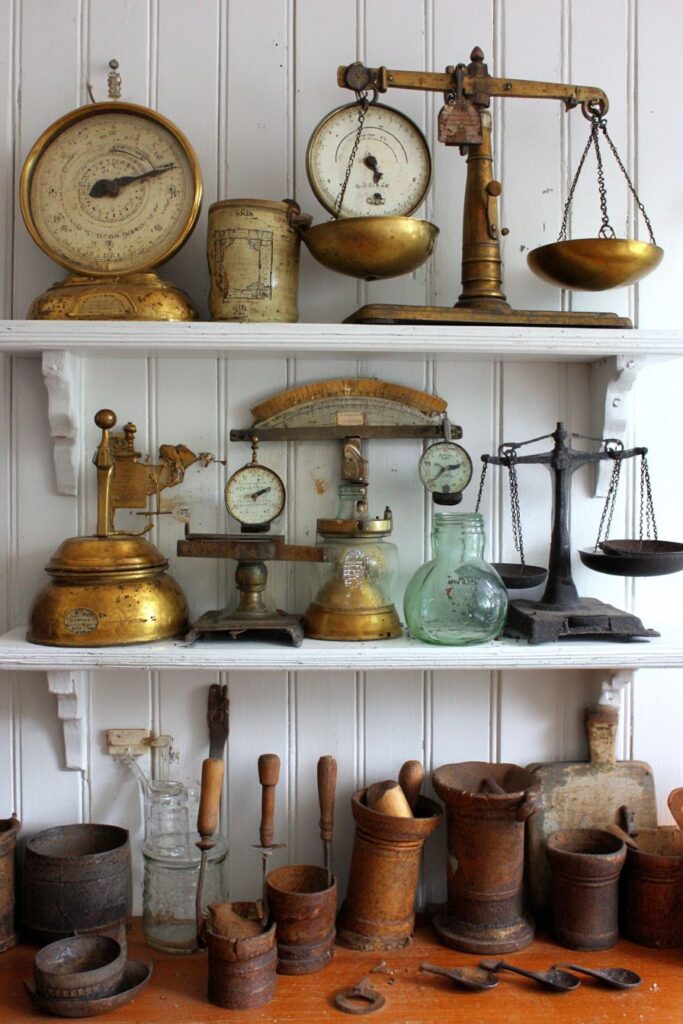
Key Design Tips:
- Research tool history and function to create educational display opportunities
- Group pieces by material type while maintaining visual balance across the entire arrangement
- Ensure shelves can support heavy cast iron and brass pieces safely
- Position lighting to highlight authentic patina without creating harsh glare
- Include informational labels or cards describing historical significance of special pieces
15. Repurposed Cutting Board Clock Installation
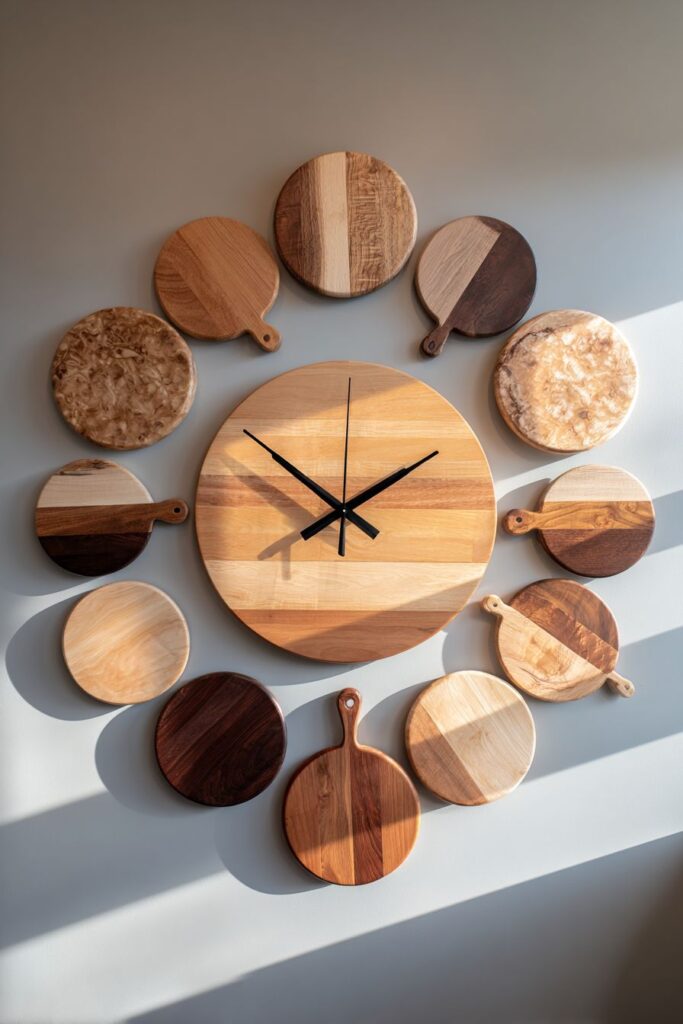
Transform functional cutting boards into artistic timepieces with creative repurposing that celebrates natural wood beauty. A large round cutting board serves as the clock face with simple black metal hands, while smaller boards in walnut, maple, and cherry create radial patterns that emphasize the central timepiece. Each board displays natural grain patterns and gentle use marks that tell stories of kitchen service.
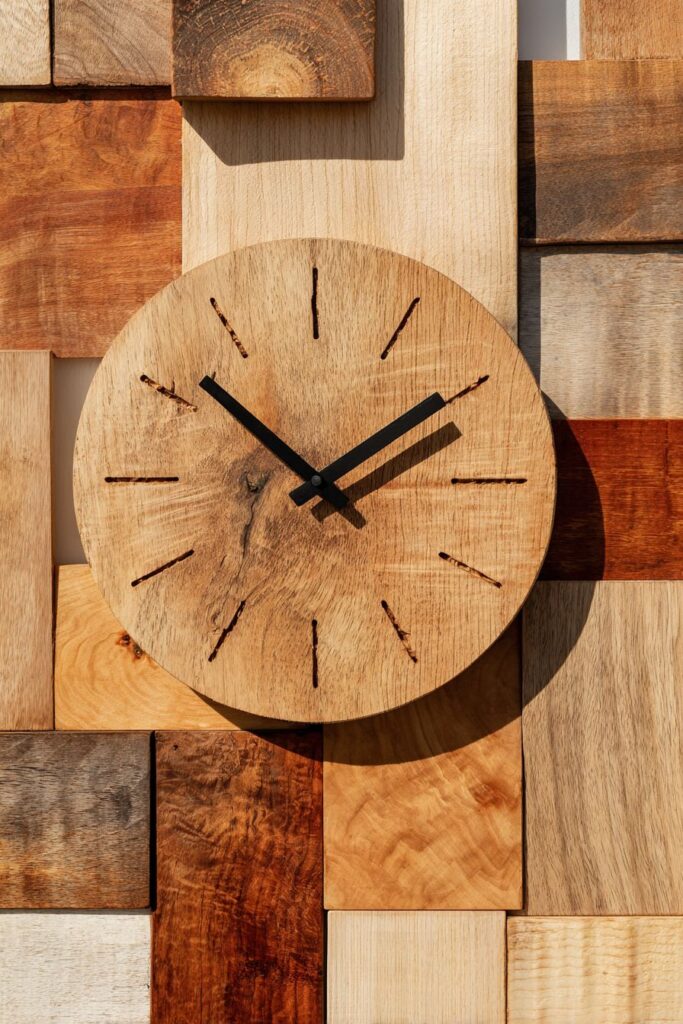
The various wood species create natural color variation from the deep chocolate tones of walnut to the light cream colors of maple, with cherry providing rich medium tones that bridge the color spectrum. Each cutting board shows authentic wear patterns from years of kitchen use, including gentle knife marks and natural patina that cannot be replicated through artificial aging.
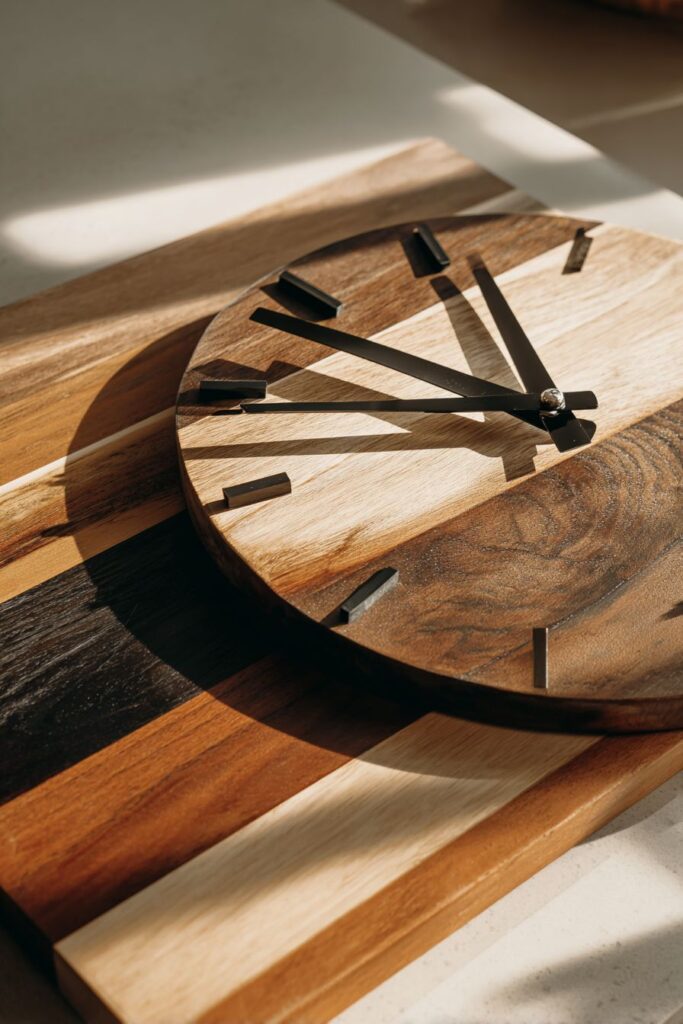
The radial arrangement creates visual movement that draws the eye naturally to the central clock while showcasing the individual character of each wood species. The geometric precision of the arrangement provides contemporary appeal while celebrating traditional woodcraft and kitchen functionality.
Natural lighting highlights wood grain variations while creating subtle shadows that emphasize the three-dimensional qualities of the installation. The changing light throughout the day ensures the display remains dynamic while maintaining its function as a practical timepiece.
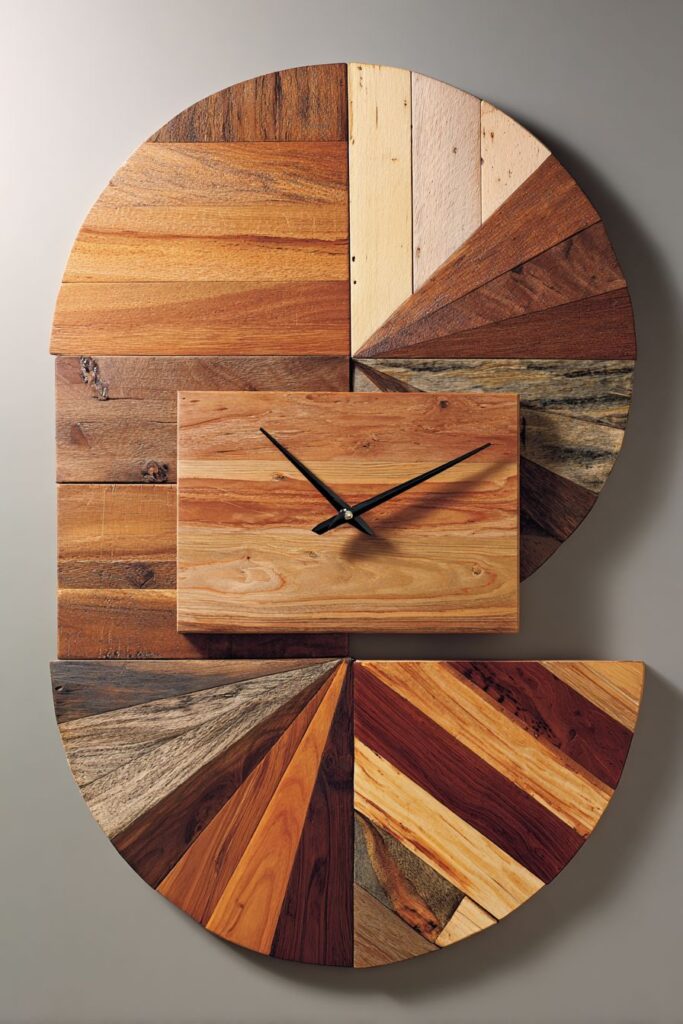
Key Design Tips:
- Select cutting boards with similar thickness but contrasting wood grain patterns
- Choose clock mechanisms appropriate for the weight and thickness of repurposed cutting boards
- Arrange smaller boards to create visual balance without overwhelming the central timepiece
- Consider the viewing angle from primary kitchen work areas when determining installation height
- Apply appropriate wood finishes to protect surfaces while preserving natural character
16. Vintage Advertising Sign Gallery Wall
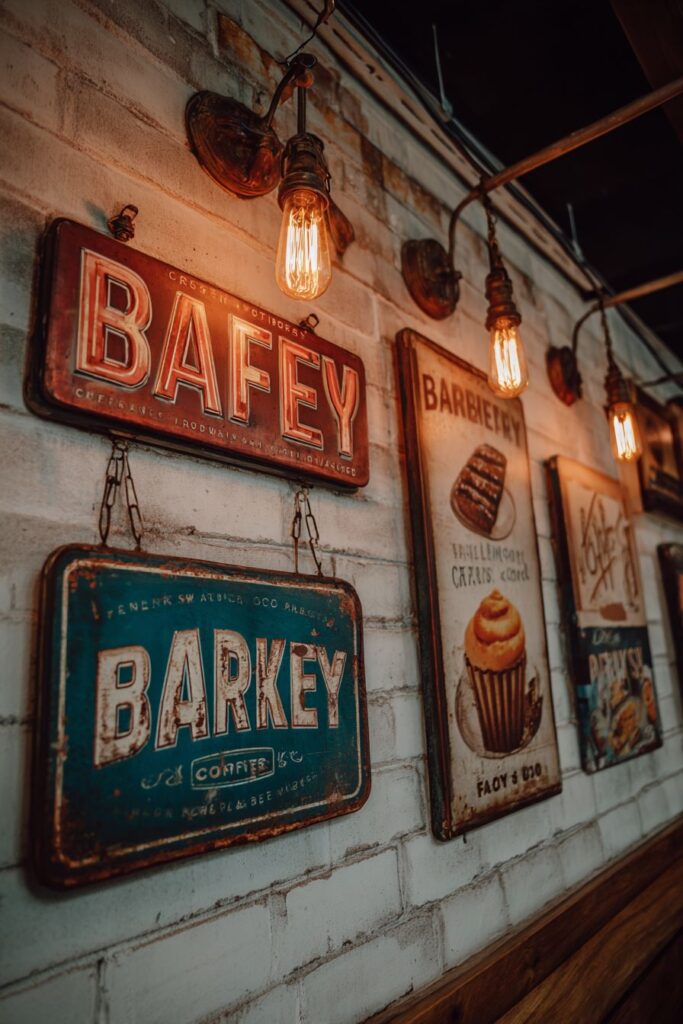
Curate an eclectic collection of weathered metal signs and enamel kitchen advertising that celebrates culinary history and Americana. This gallery wall features authentic vintage pieces advertising coffee brands, bakery goods, and farm products, each showing characteristic aging including rust spots, faded paint, and the natural patina that develops through decades of exposure. The varied sizes and asymmetrical arrangement create visual interest while maintaining collected-over-time authenticity.
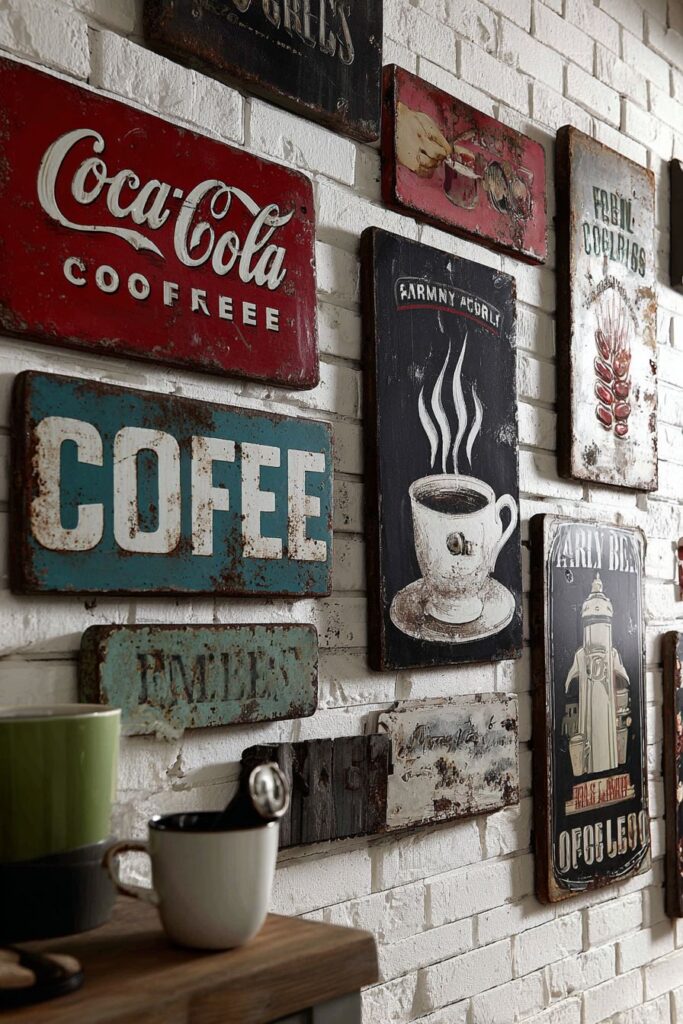
The weathered metal signs display authentic aging patterns that cannot be replicated through modern distressing techniques. Original advertising graphics show the typography and design sensibilities of their respective eras, creating historical timeline through visual evolution of commercial art. Faded colors and worn edges speak to years of service in original commercial settings.
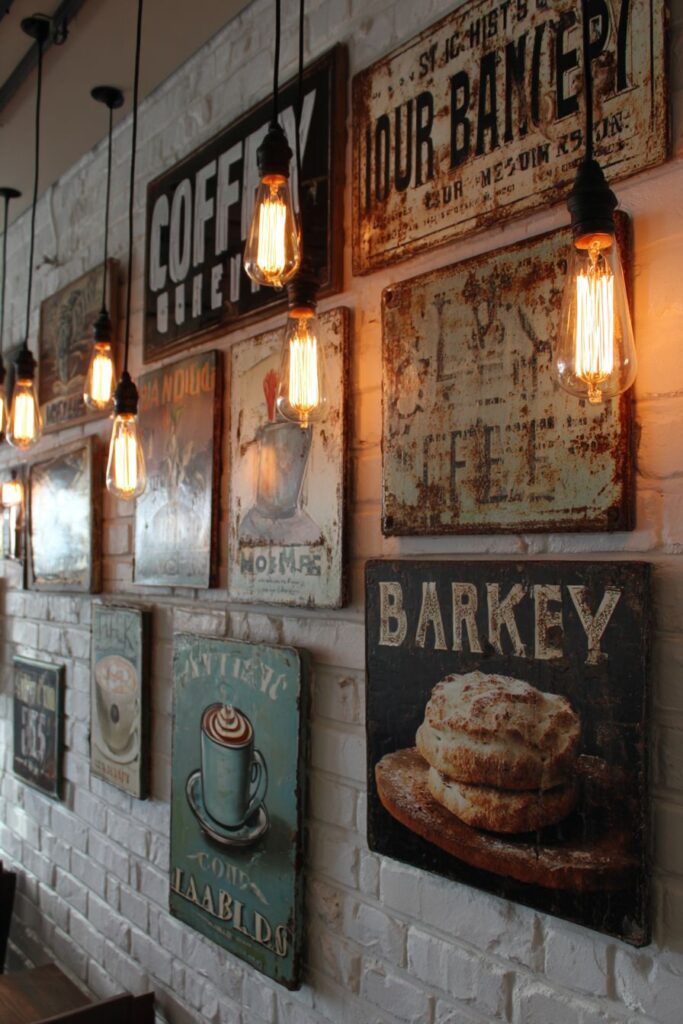
Arranged asymmetrically against white painted brick walls, the collection creates dynamic visual rhythm while preventing the rigid appearance that formal arrangements might create. The white brick backdrop provides texture without competing with the signage graphics while creating subtle contrast that makes colors appear more vibrant.
Warm Edison bulb lighting emphasizes aged patina and nostalgic character while creating authentic atmosphere reminiscent of vintage diners and general stores. This lighting choice celebrates the historical character while ensuring signs remain legible and visually appealing during evening hours.
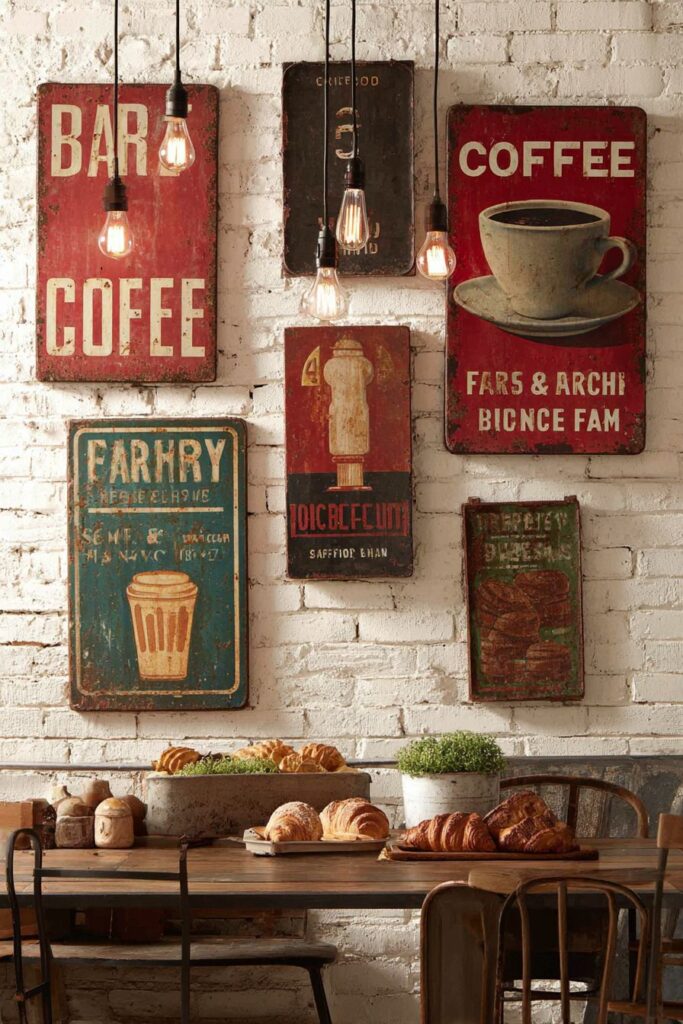
Key Design Tips:
- Authenticate vintage pieces to ensure historical accuracy and value preservation
- Arrange signs with varying sizes and orientations to create dynamic visual movement
- Consider color relationships between different pieces when planning arrangements
- Use appropriate hanging hardware for heavy metal signs to ensure safety
- Research sign history and original contexts to create conversation opportunities
17. Sculptural Wooden Utensil Art Installation
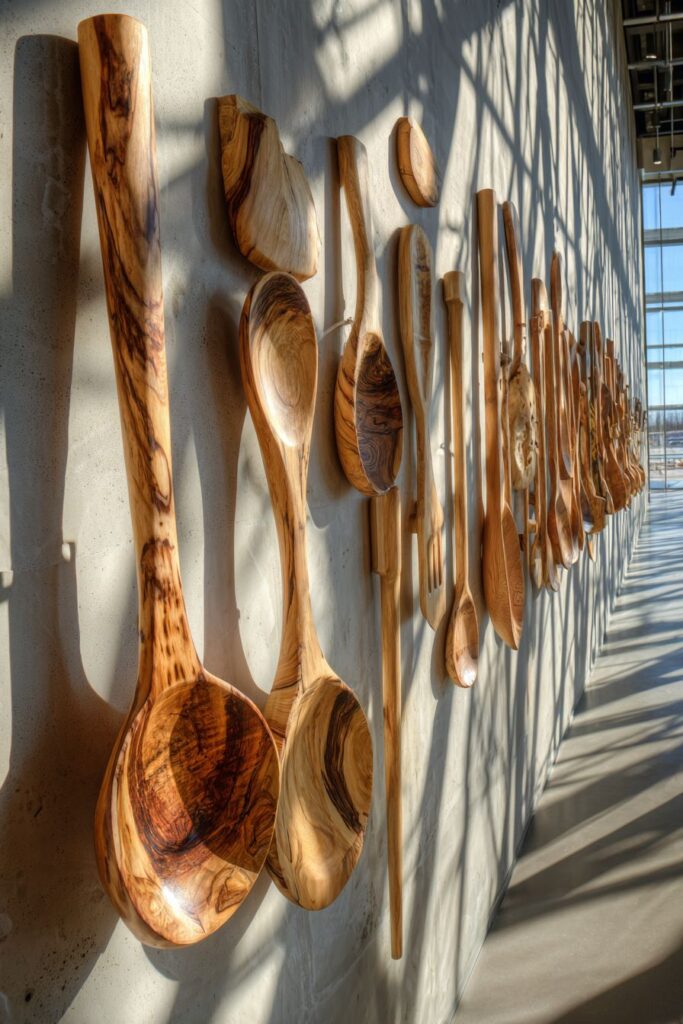
Transform oversized wooden spoons and kitchen utensils into contemporary wall sculpture through dynamic mounting arrangements. This artistic installation features utensils crafted from various wood species including olive wood, bamboo, and teak, creating natural color and grain variation while celebrating functional objects as art. Each piece shows organic shapes and natural wood characteristics that create visual rhythm and sculptural interest.
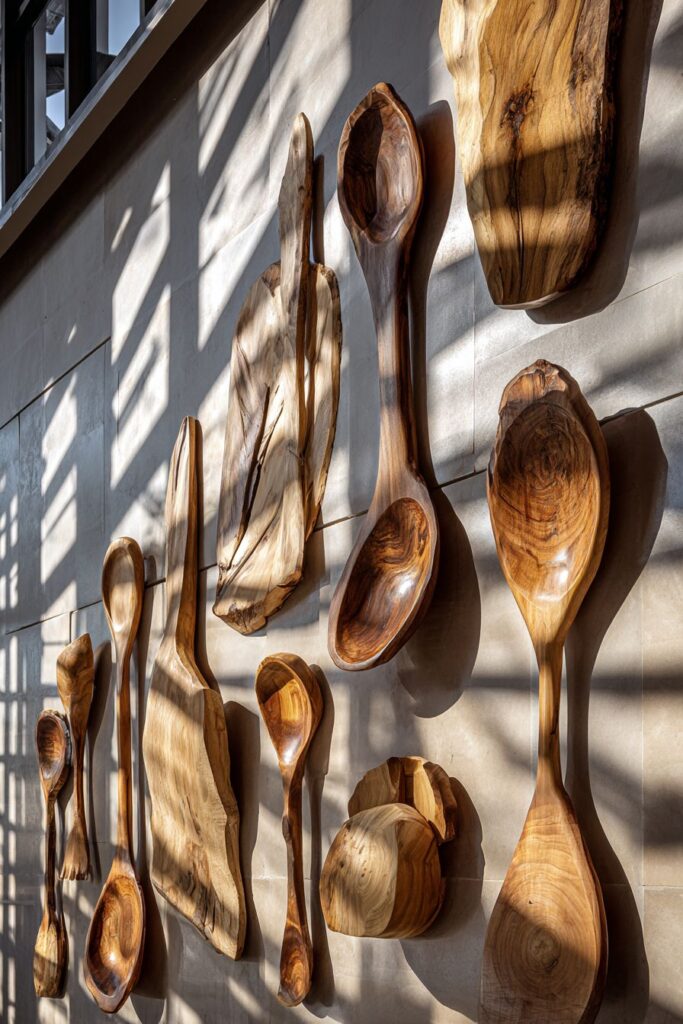
The utensils range from sleek salad servers with contemporary lines to rustic hand-carved ladles with traditional craftsmanship details. This variety creates textural interest while demonstrating the range of woodworking techniques and cultural influences found in kitchen tools. The natural wood grains provide movement and visual depth that changes as lighting conditions vary throughout the day.
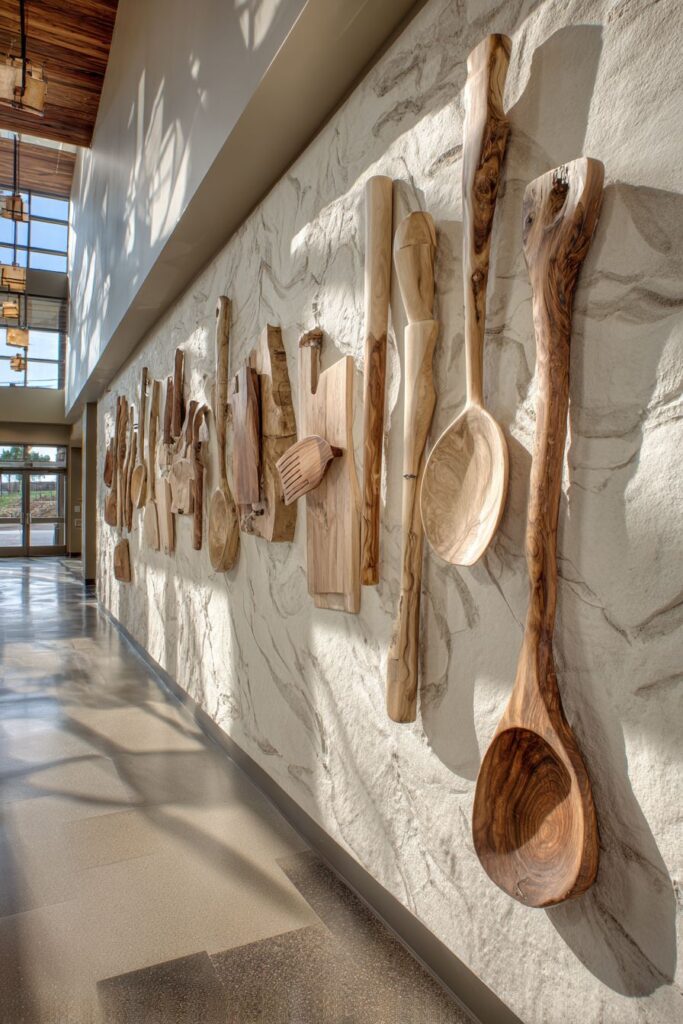
Mounted at different angles and positions, the utensils create dynamic shadows and visual rhythm that transforms the wall into three-dimensional sculpture. The varied orientations prevent static appearance while creating depth through overlapping shadows and dimensional variation.
Positioned above a kitchen island, the installation catches natural light from skylights, creating dramatic shadow patterns that change throughout the day. This natural lighting creates constantly evolving visual interest while highlighting the organic beauty of natural wood materials.
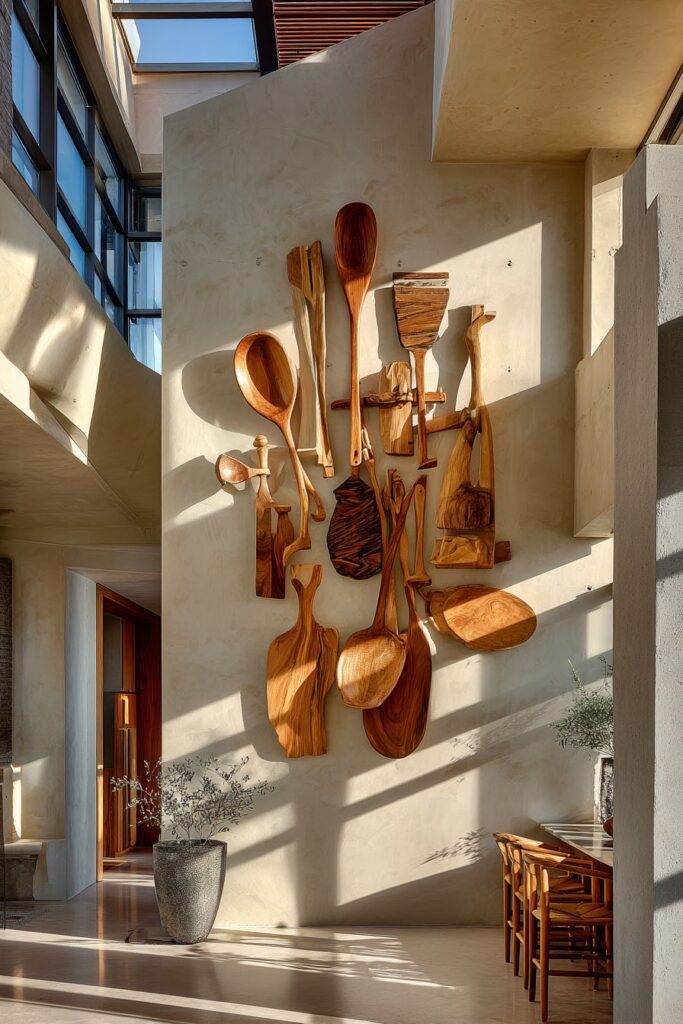
Key Design Tips:
- Select utensils with complementary wood tones despite varying species and grain patterns
- Plan mounting angles to create interesting shadow patterns without overwhelming the space
- Consider the viewing angle from different kitchen positions when planning arrangements
- Use museum-quality mounting hardware to support larger pieces safely
- Position installation where natural light can create dynamic shadow effects
18. Traditional Wrought Iron Pot Rack System
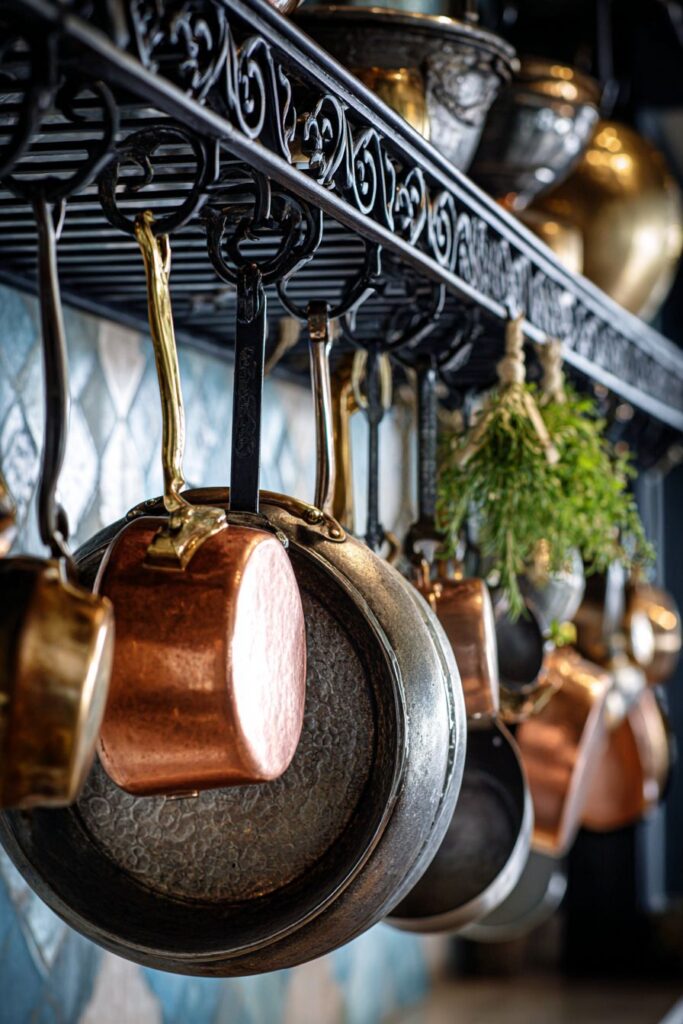
Install a ceiling-mounted pot rack system featuring scrolled ironwork and professional cookware display that combines old-world craftsmanship with contemporary functionality. The matte black wrought iron framework displays traditional scrollwork details while supporting copper and stainless steel pots and pans that show natural use patterns and professional quality. Fresh herb bundles hanging from S-hooks add natural elements while providing convenient seasoning access.
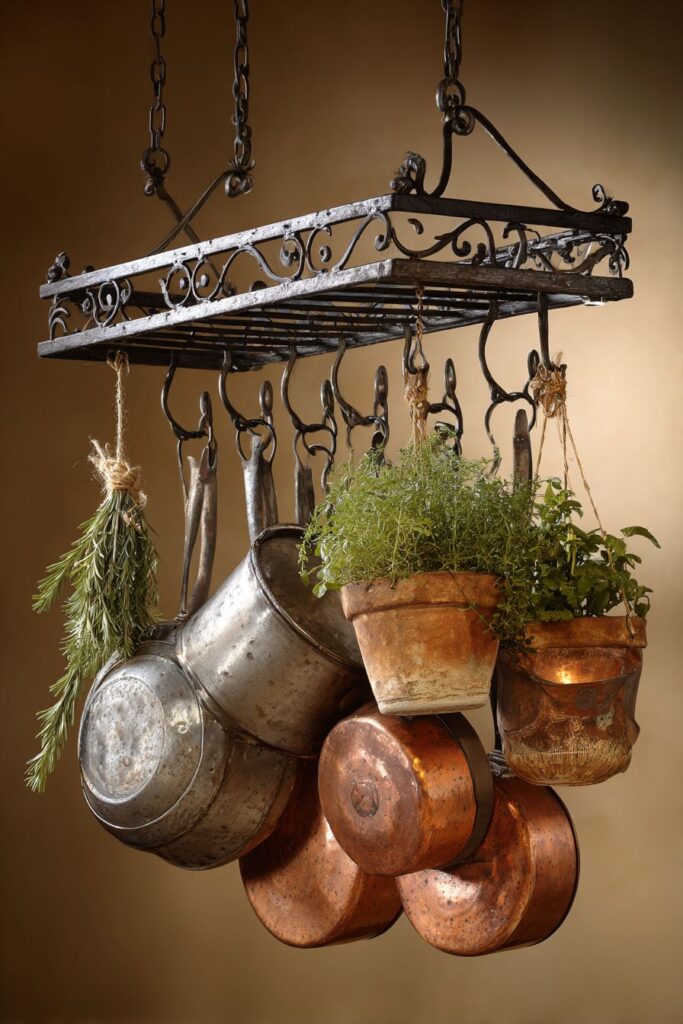
The wrought iron framework showcases traditional blacksmithing techniques through hand-forged scrollwork and textured surfaces that add visual interest while providing structural strength. The matte black finish provides sophisticated contrast against ceiling surfaces while complementing both copper and stainless steel cookware finishes.
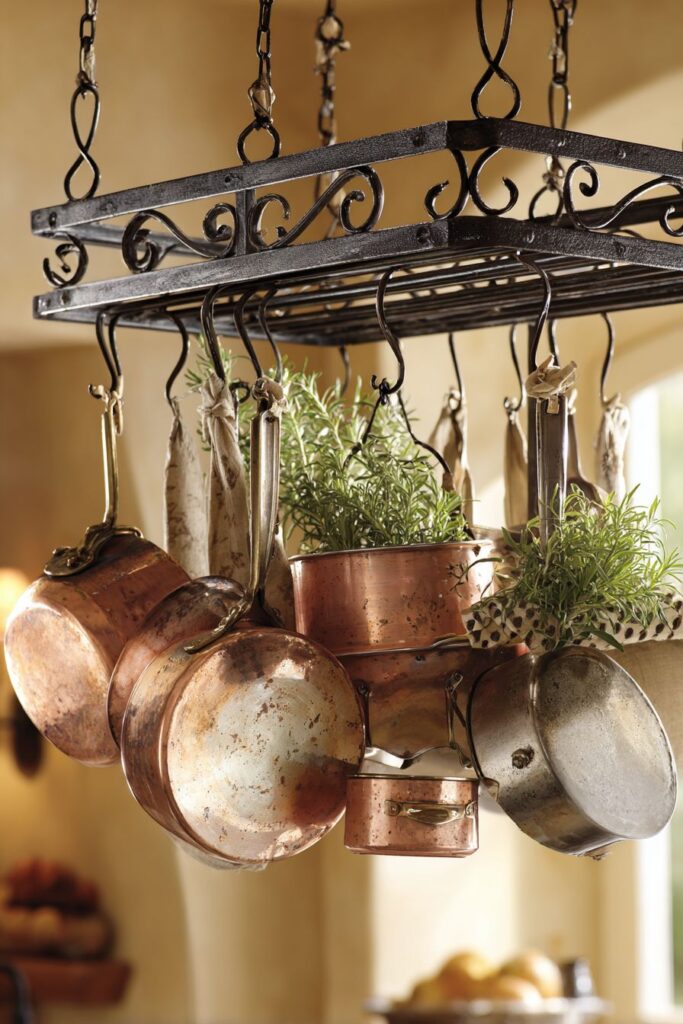
Each piece of cookware displays different light-reflecting qualities – copper showing warm patina and rich color variation, while stainless steel provides bright reflections that add sparkle and movement to the display. The varied pot and pan sizes create visual rhythm while demonstrating the comprehensive nature of a serious cook’s equipment collection.
Fresh herb bundles add living elements that provide both visual appeal and practical seasoning access. These natural additions soften the industrial character of metal components while adding fragrance and color that changes seasonally as different herbs are harvested and dried.
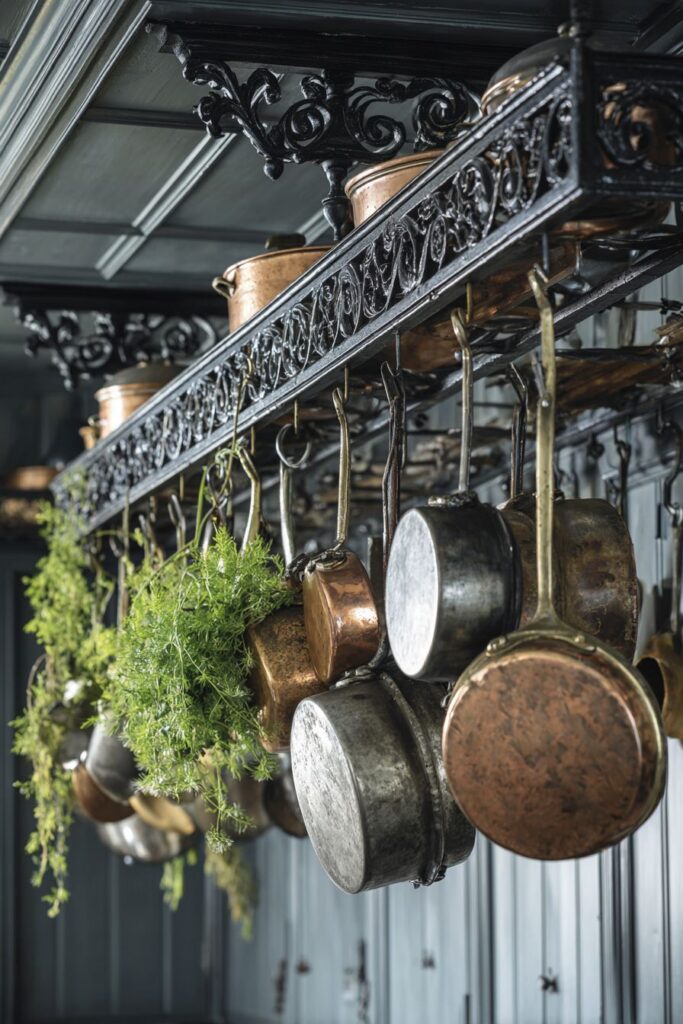
Key Design Tips:
- Ensure ceiling structure can support the weight of rack and full cookware load safely
- Position rack height for convenient access while maintaining adequate headroom
- Select cookware with complementary finishes despite different materials
- Include adequate lighting to showcase cookware quality and eliminate shadows
- Plan herb bundle placement for easy access while maintaining visual balance
19. Family Recipe Shadow Box Memorial Display
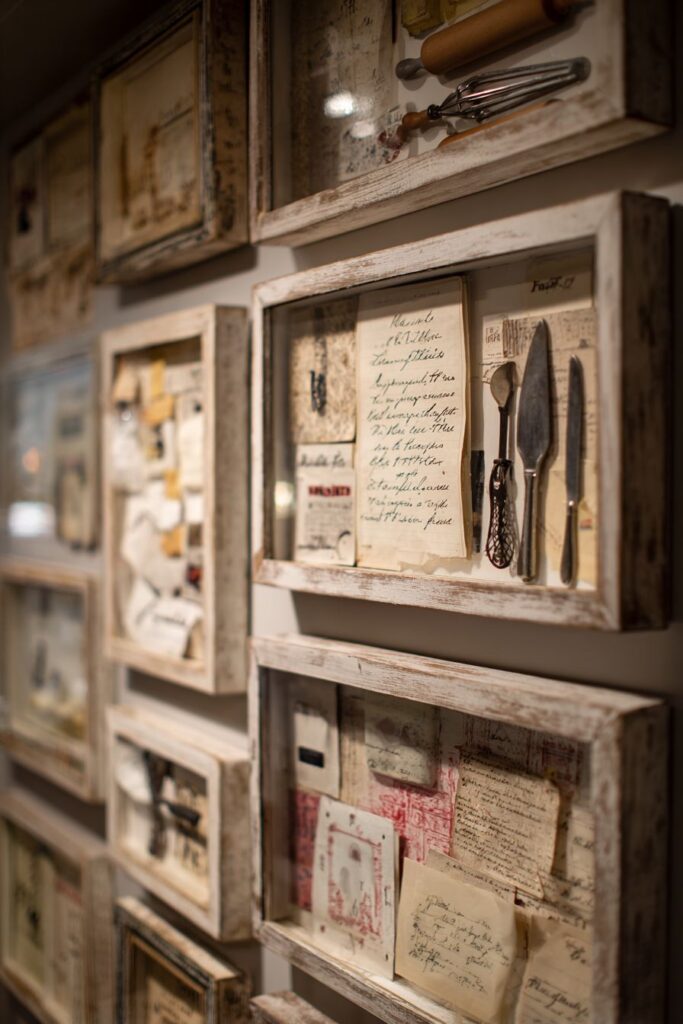
Create intimate storytelling opportunities with custom shadow boxes showcasing handwritten recipe cards and cherished kitchen memorabilia. These glass-fronted wooden boxes contain carefully curated vignettes that preserve family culinary history through tangible objects and handwritten documents. Each shadow box tells specific stories through meaningful arrangements of grandmother’s rolling pin, faded recipe cards with authentic splatter stains, and miniature ceramic measuring spoons that represent generations of kitchen wisdom.
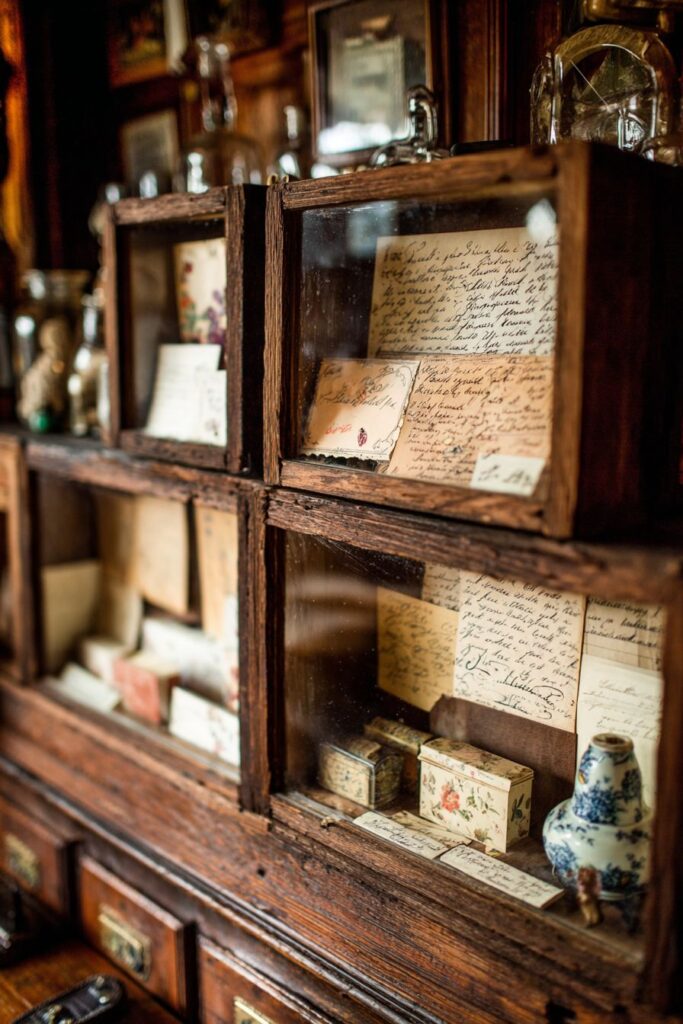
The custom-built wooden frames provide appropriate scale for displaying small precious objects while protecting them from handling and environmental damage. Glass fronts allow clear viewing while preventing deterioration of delicate paper items and preserving fragile ceramic pieces. Each box becomes a three-dimensional story that connects present cooking activities with family culinary traditions.
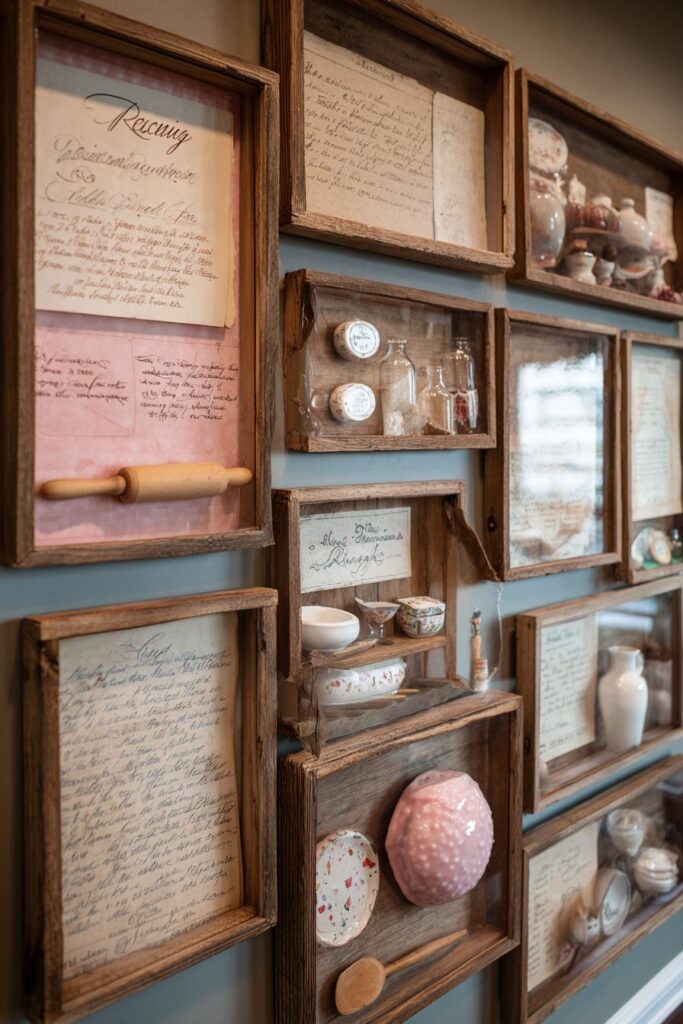
Handwritten recipe cards show authentic aging including splatter stains, worn edges, and faded ink that speak to years of kitchen use. These imperfections add authenticity and emotional connection that printed recipes cannot match. The personal handwriting creates intimate connection with family members who may no longer be present but whose culinary wisdom continues through preserved recipes.
Soft LED picture lighting illuminates each shadow box while protecting delicate paper items from UV damage that could cause further deterioration. This careful lighting ensures visibility while preserving precious family documents for future generations to appreciate and learn from.
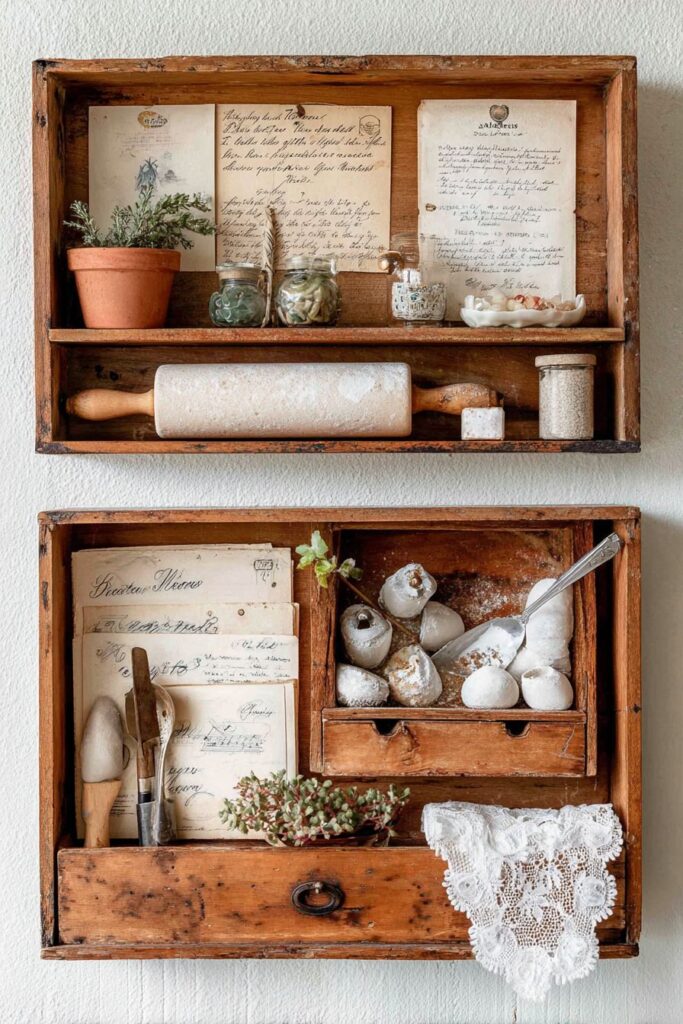
Key Design Tips:
- Use archival mounting materials to prevent deterioration of paper documents
- Include small informational cards explaining the significance of displayed items
- Position boxes at eye level where details can be easily read and appreciated
- Use UV-filtering glass to protect fragile paper and fabric items from light damage
- Consider rotating displays seasonally to showcase different family traditions and recipes
20. Living Moss Wall with Integrated Lighting

Create a dramatic natural focal point with preserved moss panels arranged in organic patterns within custom wooden frames. This sophisticated biophilic design installation requires no maintenance while providing natural texture and color variation through different moss species in various shades of green. Hidden LED strip lighting creates gentle uplighting that makes the moss appear to glow softly, transforming the kitchen into a connection with nature.
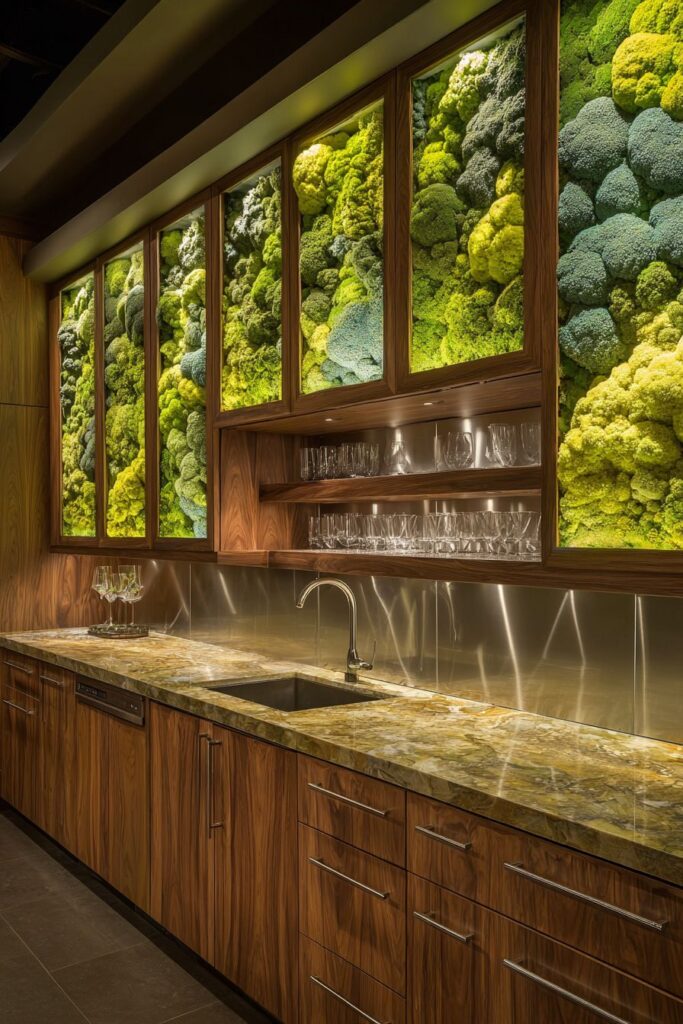
The preserved moss panels maintain their natural appearance and texture without requiring water, pruning, or special care, making them ideal for kitchen environments where maintenance time is limited. The various moss species create subtle color and texture variation that adds visual depth while maintaining the overall green color palette that brings natural calm to busy kitchen environments.
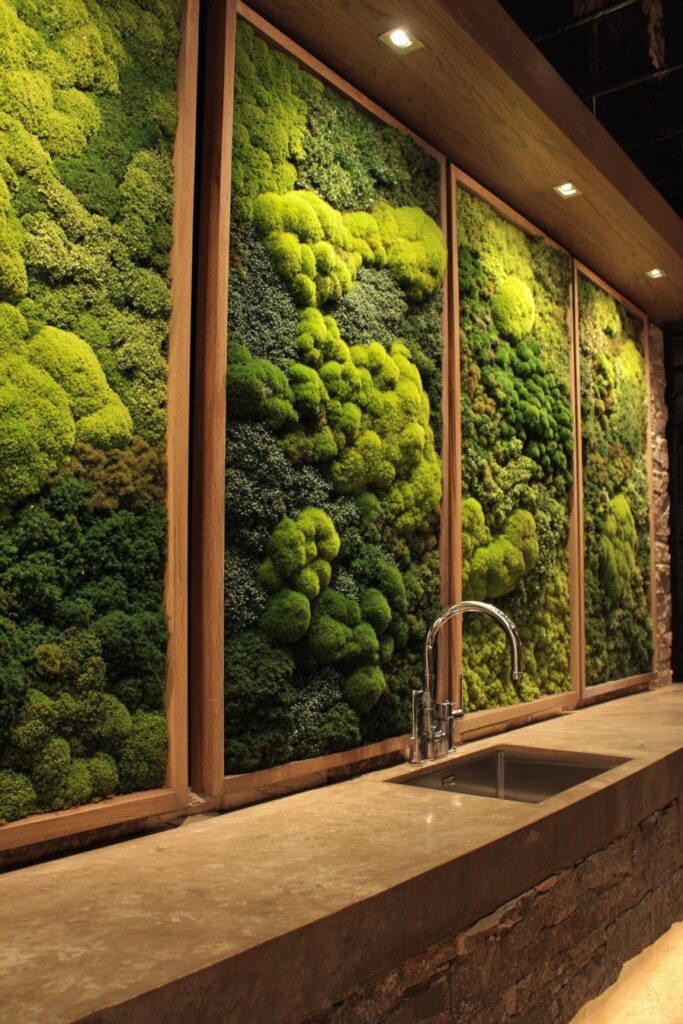
Custom wooden frames provide structure and visual organization while complementing other natural wood elements throughout the kitchen. The frames can be arranged in various configurations to suit different wall sizes and architectural features while maintaining organic visual flow that mimics natural growth patterns.
The installation spans from countertop to ceiling, creating dramatic vertical emphasis that makes kitchen spaces appear larger while providing stunning natural focal point behind the sink area. This positioning ensures the living wall remains visible during daily kitchen activities while creating beautiful reflection in stainless steel fixtures and surfaces.
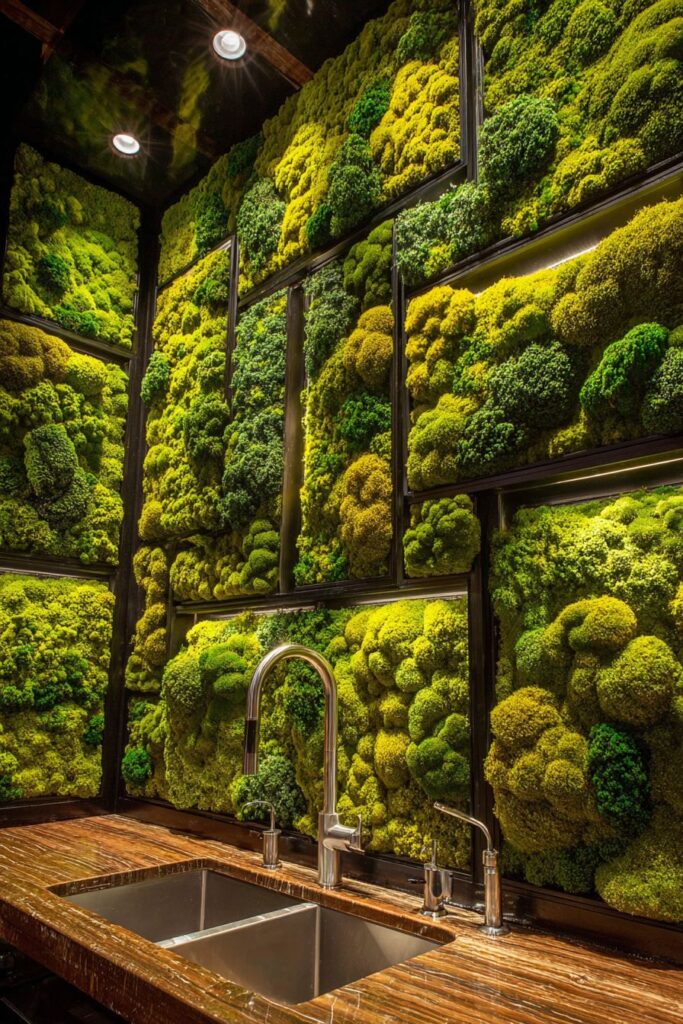
Key Design Tips:
- Select preserved moss varieties with complementary colors and textures for visual harmony
- Install proper backing materials to prevent moisture issues behind moss panels
- Position LED strips to create gentle uplighting without harsh shadows or hot spots
- Plan frame arrangements to complement existing architectural features and sight lines
- Consider seasonal accent lighting to enhance the natural appearance during different times of year
Why These Kitchen Wall Decor Ideas Are the Best
These twenty innovative kitchen wall decor concepts represent the pinnacle of contemporary interior design thinking, seamlessly blending aesthetic appeal with practical functionality. Each approach addresses the modern homeowner’s need for spaces that perform multiple roles while maintaining visual sophistication. The farmhouse gallery wall with herb prints and cutting boards exemplifies the current trend toward authenticity and connection with traditional craftsmanship, while the geometric honeycomb spice storage system demonstrates how contemporary design can solve storage challenges with mathematical precision and artistic flair.
The living wall systems, including both the vertical herb garden and preserved moss installations, respond to growing interest in biophilic design – the human need to connect with nature even within built environments. These approaches bring life and natural variation into kitchen spaces while addressing practical needs for fresh herbs and visual calm. The vintage collections, from copper cookware displays to antique advertising signs, satisfy the desire for unique character and historical connection that mass-produced items cannot provide.
Professional organization systems, such as the magnetic knife display and wrought iron pot racks, demonstrate how storage solutions can become focal points when approached with design consciousness. These installations celebrate the tools of serious cooking while keeping them optimally positioned for efficiency and safety. The artisanal elements, including hand-painted ceramic tiles and custom shadow box displays, provide opportunities for personal expression and family storytelling that transform kitchens from merely functional spaces into repositories of memory and meaning.
Each concept addresses specific challenges common to modern kitchen design: limited storage space, desire for personality in increasingly standardized home construction, need for practical organization systems, and yearning for connection with natural materials and traditional craftsmanship. The solutions range from high-technology approaches like integrated LED lighting systems to time-honored techniques like open plate racks and pegboard storage, ensuring options for every budget and skill level.
The integration of lighting in these designs demonstrates sophisticated understanding of how illumination affects both functionality and ambiance. From under-cabinet LED strips that highlight natural wood grain to dramatic uplighting that makes preserved moss appear to glow, each lighting choice enhances both practical use and visual appeal. This attention to lighting transforms simple storage solutions into dynamic displays that change throughout the day and adapt to different activities.
Material selection across these concepts emphasizes authenticity and sustainability. Reclaimed wood, vintage metal pieces, and repurposed cutting boards celebrate the beauty found in items with history and character. Natural materials like live-edge walnut and preserved moss bring organic textures that soften the hard surfaces typically found in kitchen environments. Even contemporary elements like stainless steel magnetic strips are selected for their durability and timeless appeal rather than trendy finishes that quickly become dated.
The scalability of these approaches makes them accessible to homeowners with varying budgets and skill levels. A simple gallery wall can be created with modest investment and basic hanging skills, while more complex installations like integrated spice storage systems may require professional construction but provide long-term value through improved functionality and home value enhancement. Many concepts can be implemented in phases, allowing homeowners to develop their kitchen character gradually over time.
These kitchen wall decor ideas succeed because they recognize that modern kitchens must serve multiple functions beyond food preparation. They accommodate the need for storage, the desire for beauty, the requirement for easy maintenance, and the yearning for personal expression within a single cohesive design approach. Whether implemented individually or combined thoughtfully, these concepts transform kitchen walls from afterthoughts into integral components of well-designed living spaces.
The emphasis on natural materials, authentic aging, and handcrafted elements reflects broader cultural movements toward sustainability, slow living, and appreciation for traditional skills. These approaches reject the disposable culture in favor of items with longevity and character, creating kitchen environments that improve with age rather than deteriorating over time. The integration of living plants and natural textures addresses psychological needs for biophilic connection while providing practical benefits like fresh herbs and improved air quality.
Conclusion
Kitchen wall decor represents one of the most impactful opportunities for transforming culinary spaces into environments that inspire both cooking creativity and daily living joy. These twenty innovative approaches demonstrate that walls need not be mere boundaries but can become integral components of kitchen functionality and aesthetic appeal. From the rustic charm of farmhouse gallery walls to the contemporary sophistication of living moss installations, each concept offers unique pathways for expressing personal style while addressing practical storage and organizational needs.
The success of these designs lies in their recognition that modern kitchens must serve multiple roles – workspace, gathering place, storage solution, and personal expression canvas. By thoughtfully combining materials, lighting, and functional elements, these approaches create wall treatments that enhance rather than complicate daily kitchen activities. Whether your style gravitates toward vintage collections that tell family stories or contemporary systems that celebrate clean geometric forms, these concepts provide frameworks for creating kitchen environments that feel both personal and professionally designed.
The integration of sustainable practices, from repurposed materials to living plant systems, reflects growing awareness of our connection to both natural environments and historical craftsmanship traditions. These approaches encourage homeowners to view their kitchens as evolving spaces that can accommodate changing needs while maintaining enduring appeal through quality materials and thoughtful design principles.
As you consider implementing these ideas in your own kitchen, remember that the most successful wall decor solutions are those that genuinely reflect your cooking style, aesthetic preferences, and practical needs. Start with approaches that resonate most strongly with your vision, and allow your kitchen walls to evolve gradually as your confidence and creativity expand. The reward will be a culinary space that not only functions efficiently but also provides daily inspiration and genuine pleasure in both cooking activities and quiet moments of appreciation for thoughtfully designed living environments.
